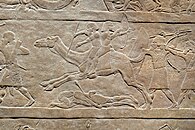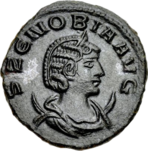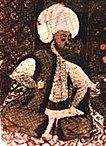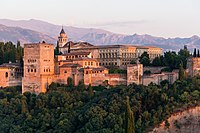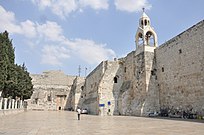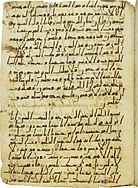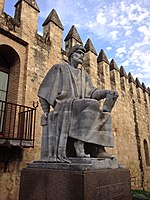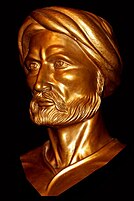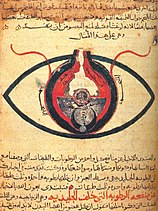арабы
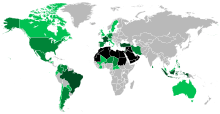 | |
| Общая численность населения | |
в. 400 миллионов [1] [2] до 420+ миллионов [3] [4]
| |
| Регионы со значительной численностью населения | |
| 350,000,000 [5] [6] | |
| 11,600,000–20,000,000 [7] [8] [9] | |
| 5,500,000–7,000,000 [10] [11] | |
| 5,000,000[12][a] | |
| 3,700,000[14] | |
| 3,500,000[15] | |
| 3,200,000[16][17][18][19][20] | |
| 2,080,000[21] | |
| 1,800,000[22] | |
| 1,600,000[23]–4,000,000[24] | |
| 1,600,000[25] | |
| 1,401,950[26] | |
| 1,350,000[27][28] | |
| 1,100,000[29] | |
| 800,000[30][31][32] | |
| 750,925[33] | |
| 705,968[34] | |
| 543,350[35] | |
| 500,000[36] | |
| 500,000[37] | |
| 480,000–613,800[38] | |
| 300,000[39] | |
| 280,000[40] | |
| 170,000 [41] | |
| 150,000 (2006)[42] | |
| 121,000[43] | |
| 118,866 (2010)[44] | |
| 100,000[45][46][47][48][49] | |
| 80,000 (2010)[50] | |
| 75,000[51] | |
| 70,000[52] | |
| 59,021 (2019)[53] | |
| 30,000[54] | |
| Languages | |
| Arabic | |
| Religion | |
Predominantly:
| |
| Related ethnic groups | |
| Other peoples of the Middle East and North Africa[55] | |
Арабы DIN ( арабский : عَرَب , 31635 : ʿarab , арабское произношение : [б] [ˈʕɑ.rɑb] ), также известный как , арабский народ является этнической группой [с] в основном населяющие арабский мир в Западной Азии и Северной Африке . Значительная арабская диаспора присутствует в различных частях мира. [74]
Арабы жили в Плодородном полумесяце уже тысячи лет. [75] В 9 веке до нашей эры ассирийцы письменно упоминали арабов как жителей Леванта, Месопотамии и Аравии . [76] На протяжении всего древнего Ближнего Востока арабы основали влиятельные цивилизации, начиная с 3000 г. до н. э., такие как Дилмун , Герра и Маган , играющие жизненно важную роль в торговле между Месопотамией и Средиземноморьем . [77] Другие известные племена включают Мадиам , Ад и Самуд , упомянутые в Библии и Коране . Позже, в 900 г. до н. э., кедариты поддерживали тесные отношения с близлежащими ханаанскими и арамейскими государствами, а их территория простиралась от Нижнего Египта до Южного Леванта. [78] могущественные царства, такие как Саба , Лихьян , Миней , Катабан , Хадрамаут , Авсан и Гомерит . С 1200 г. до н. э. по 110 г. до н. э . в Аравии возникли [79] Согласно авраамической традиции, арабы являются потомками Авраама через его сына Измаила . [80]
Во времена классической античности в 300 г. до н.э. набатейцы царство основали свое со столицей . Петрой [81] к 271 году н. э. Пальмиренская империя со столицей Пальмирой , возглавляемая царицей Зенобией , охватывала Сирию, Палестину , Аравию Петрею и Египет , а также большую часть Анатолии . [82] Арабские итурийцы населяли Ливан , Сирию и северную Палестину ( Галилею ) в эллинистический и римский периоды. [83] Осроены Хатран и были арабскими королевствами в Верхней Месопотамии около 200 г. н.э. [84] In 164 CE, the Sasanians recognized the Arabs as "Arbayistan", meaning "land of the Arabs,"[85] as they were part of Adiabene in upper Mesopotamia.[86] The Arab Emesenes ruled by 46 BCE Emesa (Homs), Syria.[87] During late antiquity, the Tanukhids, Salihids, Lakhmids, Kinda, and Ghassanids were dominant Arab tribes in the Levant, Mesopotamia, and Arabia, they predominantly embraced Christianity.[88] During the Middle Ages, Islam fostered a vast Arab union, leading to significant Arab migration from the East to North Africa, under the rule of Arab empires such as the Rashidun, Umayyad, Abbasid, and Fatimid, ultimately leading to the decline of the Byzantine and Sasanian empires. At its peak, Arab territories stretched from southern France to western China, forming one of history's largest empires.[89] The Great Arab Revolt in the early 20th century aided in dismantling the Ottoman Empire, ultimately leading to the formation of the Arab League on 22 March 1945, with its Charter endorsing the principle of a "unified Arab homeland".[90]
Arabs from Morocco to Iraq share a common bond based on ethnicity, language, culture, history, identity, ancestry, nationalism, geography, unity, and politics,[91] which give the region a distinct identity and distinguish it from other parts of the Muslim world.[92] They also have their own customs, literature, music, dance, media, food, clothing, society, sports, architecture, art and, mythology.[93] Arabs have significantly influenced and contributed to human progress in many fields, including science, technology, philosophy, ethics, literature, politics, business, art, music, comedy, theatre, cinema, architecture, food, medicine, and religion.[94] Before Islam, most Arabs followed polytheistic Semitic religion, while some tribes adopted Judaism or Christianity and a few individuals, known as the hanifs, followed a form of monotheism.[95] Currently, around 93% of Arabs are Muslims, while the rest are mainly Arab Christians, as well as Arab groups of Druze and Baháʼís.[96]
Etymology

The earliest documented use of the word Arab in reference to a people appears in the Kurkh Monoliths, an Akkadian-language record of the Assyrian conquest of Aram (9th century BCE). The Monoliths used the term to refer to Bedouins of the Arabian Peninsula under King Gindibu, who fought as part of a coalition opposed to Assyria.[97] Listed among the booty captured by the army of the Assyrian king Shalmaneser III in the Battle of Qarqar (853 BCE) are 1000 camels of "Gîndibuʾ the Arbâya" or "[the man] Gindibu belonging to the Arabs" (ar-ba-a-a being an adjectival nisba of the noun ʿArab).[97]
The related word ʾaʿrāb is used to refer to Bedouins today, in contrast to ʿArab which refers to Arabs in general.[98] Both terms are mentioned around 40 times in pre-Islamic Sabaean inscriptions. The term ʿarab ('Arab') occurs also in the titles of the Himyarite kings from the time of 'Abu Karab Asad until MadiKarib Ya'fur. According to Sabaean grammar, the term ʾaʿrāb is derived from the term ʿarab. The term is also mentioned in Quranic verses, referring to people who were living in Madina and it might be a south Arabian loanword into Quranic language.[99]
The oldest surviving indication of an Arab national identity is an inscription made in an archaic form of Arabic in 328 CE using the Nabataean alphabet, which refers to Imru' al-Qays ibn 'Amr as 'King of all the Arabs'.[100][101] Herodotus refers to the Arabs in the Sinai, southern Palestine, and the frankincense region (Southern Arabia). Other Ancient-Greek historians like Agatharchides, Diodorus Siculus and Strabo mention Arabs living in Mesopotamia (along the Euphrates), in Egypt (the Sinai and the Red Sea), southern Jordan (the Nabataeans), the Syrian steppe and in eastern Arabia (the people of Gerrha). Inscriptions dating to the 6th century BCE in Yemen include the term 'Arab'.[102]
The most popular Arab account holds that the word Arab came from an eponymous father named Ya'rub, who was supposedly the first to speak Arabic. Abu Muhammad al-Hasan al-Hamdani had another view; he states that Arabs were called gharab ('westerners') by Mesopotamians because Bedouins originally resided to the west of Mesopotamia; the term was then corrupted into Arab.
Yet another view is held by al-Masudi that the word Arab was initially applied to the Ishmaelites of the Arabah valley. In Biblical etymology, Arab (Hebrew: arvi) comes from the desert origin of the Bedouins it originally described (arava means 'wilderness').
The root ʿ-r-b has several additional meanings in Semitic languages—including 'west, sunset', 'desert', 'mingle', 'mixed', 'merchant' and 'raven'—and are "comprehensible" with all of these having varying degrees of relevance to the emergence of the name. It is also possible that some forms were metathetical from ʿ-B-R, 'moving around' (Arabic: ʿ-B-R, 'traverse') and hence, it is alleged, 'nomadic'.[103]
Origins
Arabic is a Semitic language that belongs to the Afroasiatic language family. The majority of scholars accept the "Arabian peninsula" has long been accepted as the original Urheimat (linguistic homeland) of the Semitic languages.[104][105][106][107] with some scholars investigating if its origins are in the Levant.[108] The ancient Semitic-speaking peoples lived in the ancient Near East, including the Levant, Mesopotamia, and the Arabian Peninsula from the 3rd millennium BCE to the end of antiquity. Proto-Semitic likely reached the Arabian Peninsula by the 4th millennium BCE, and its daughter languages spread outward from there,[109] while Old Arabic began to differentiate from Central Semitic by the start of the 1st millennium BCE.[110] Central Semitic is a branch of the Semitic language includes Arabic, Aramaic, Canaanite, Phoenician, Hebrew and others.[111][112] The origins of Proto-Semitic may lie in the Arabian Peninsula, with the language spreading from there to other regions. This theory proposes that Semitic peoples reached Mesopotamia and other areas from the deserts to the west, such as the Akkadians who entered Mesopotamia around the late 4th millennium BCE.[109] The origins of Semitic peoples are thought to include various regions Mesopotamia, the Levant, the Arabian Peninsula, and North Africa. Some view that Semitic may have originated in the Levant around 3800 BCE and subsequently spread to the Horn of Africa around 800 BCE from Arabia, as well as to North Africa.[113][114]
In Abrahamic traditions
According to Arab–Islamic–Jewish traditions, Ishmael, the son of Abraham and Hagar was "father of the Arabs".[115][116][117][118][119] The Book of Genesis narrates that God promised Hagar to beget from Ishmael twelve princes and turn his descendants into a "great nation".[120][121][122][123][124][125] Ishmael was considered the ancestor of the Islamic prophet Muhammad, the founder of Islam. The tribes of Central West Arabia called themselves the "people of Abraham and the offspring of Ishmael."[126] Ibn Khaldun, an Arab scholar in the 8th century, described the Arabs as having Ishmaelite origins.[127]

The Quran mentions that Ibrahim (Abraham) and his wife Hajar (Hagar) bore a prophetic child named Ishmael, who was gifted by God a favor above other nations.[128] God ordered Ibrahim to bring Hajar and Ishmael to Mecca, where he prayed for them to be provided with water and fruits. Hajar ran between the hills of Safa and Marwa in search of water, and an angel appeared to them and provided them with water. Ishmael grew up in Mecca. Ibrahim was later ordered to sacrifice Ishmael in a dream, but God intervened and replaced him with a goat. Ibrahim and Ishmael then built the Kaaba in Mecca, which was originally constructed by Adam.[129]
According to the Samaritan book Asaṭīr adds:[130]: 262 "And after the death of Abraham, Ishmael reigned twenty-seven years; And all the children of Nebaot ruled for one year in the lifetime of Ishmael; And for thirty years after his death from the river of Egypt to the river Euphrates; and they built Mecca."[131] Josephus also lists the sons and states that they "...inhabit the lands which are between Euphrates and the Red Sea, the name of which country is Nabathæa.[132][133] The Targum Onkelos annotates (Genesis 25:16), describing the extent of their settlements: The Ishmaelites lived from Hindekaia (India) to Chalutsa (possibly in Arabia), by the side of Mizraim (Egypt), and from the area around Arthur (Assyria) up towards the north. This description suggests that the Ishmaelites were a widely dispersed group with a presence across a significant portion of the ancient Near East.[134][135]
History
The nomads of Arabia have been spreading through the desert fringes of the Fertile Crescent since at least 3000 BCE, but the first known reference to the Arabs as a distinct group is from an Assyrian scribe recording a battle in 853 BCE.[136][137] The history of the Arabs during the pre-Islamic period in various regions, including Arabia, Levant, Mesopotamia, and Egypt. The Arabs were mentioned by their neighbors, such as Assyrian and Babylonian Royal Inscriptions from 9th to 6th century BCE, mention the king of Qedar as king of the Arabs and King of the Ishmaelites.[138][139][140][141] Of the names of the sons of Ishmael the names "Nabat, Kedar, Abdeel, Dumah, Massa, and Teman" were mentioned in the Assyrian Royal Inscriptions as tribes of the Ishmaelites. Jesur was mentioned in Greek inscriptions in the 1st century BCE.[142] There are also records from Sargon's reign that mention sellers of iron to people called Arabs in Ḫuzaza in Babylon, causing Sargon to prohibit such trade out of fear that the Arabs might use the resource to manufacture weapons against the Assyrian army. The history of the Arabs in relation to the Bible shows that they were a significant part of the region and played a role in the lives of the Israelites. The study asserts that the Arab nation is an ancient and significant entity; however, it highlights that the Arabs lacked a collective awareness of their unity. They did not inscribe their identity as Arabs or assert exclusive ownership over specific territories.[143]
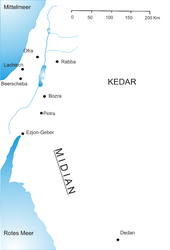
Magan, Midian, and ʿĀd are all ancient tribes or civilizations that are mentioned in Arabic literature and have roots in the Arabia. Magan (Arabic: مِجَانُ, Majan), known for its production of copper and other metals, the region was an important trading center in ancient times and is mentioned in the Qur'an as a place where Musa (Moses) traveled during his lifetime.[144][145] Midian (Arabic: مَدْيَن, Madyan), on the other hand, was a region located in the northwestern part of the Arabia, the people of Midian are mentioned in the Qur'an as having worshiped idols and having been punished by God for their disobedience.[146][147] Moses also lived in Midian for a time, where he married and worked as a shepherd. ʿĀd (Arabic: عَادَ, ʿĀd), as mentioned earlier, was an ancient tribe that lived in the southern Arabia, the tribe was known for its wealth, power, and advanced technology, but they were ultimately destroyed by a powerful windstorm as punishment for their disobedience to God.[148] ʿĀd is regarded as one of the original Arab tribes.[149][150]The historian Herodotus provided extensive information about Arabia, describing the spices, terrain, folklore, trade, clothing, and weapons of the Arabs. In his third book, he mentioned the Arabs (Άραβες) as a force to be reckoned with in the north of the Arabian Peninsula just before Cambyses’ campaign against Egypt. Other Greek and Latin authors who wrote about Arabia include Theophrastus, Strabo, Diodorus Siculus, and Pliny the Elder. The Jewish historian Flavius Josephus wrote about the Arabs and their king, mentioning their relationship with Cleopatra, the queen of Egypt. The tribute paid by the Arab king to Cleopatra was collected by Herod, the king of the Jews, but the Arab king later became slow in his payments and refused to pay without further deductions. This sheds some light on the relations between the Arabs, Jews, and Egypt at that time.[151] Geshem the Arab was an Arab man who opposed Nehemiah in the Hebrew Bible (Neh. 2:19, 6:1). He was likely the chief of the Arab tribe "Gushamu" and have been a powerful ruler with influence stretching from northern Arabia to Judah. The Arabs and the Samaritans made efforts to hinder Nehemiah's rebuilding of the walls of Jerusalem.[152][153][154]
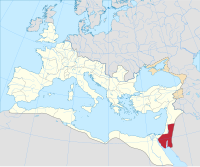
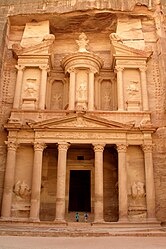
The term "Saracens" was a term used in the early centuries, both in Greek and Latin writings, to refer to the "Arabs" who lived in and near what was designated by the Romans as Arabia Petraea (Levant) and Arabia Deserta (Arabia).[155][156] The Christians of Iberia used the term Moor to describe all the Arabs and Muslims of that time. Arabs of Medina referred to the nomadic tribes of the deserts as the A'raab, and considered themselves sedentary, but were aware of their close racial bonds. Hagarenes is a term widely used by early Syriac, Greek, and Armenian to describe the early Arab conquerors of Mesopotamia, Syria and Egypt, refers to the descendants of Hagar, who bore a son named Ishmael to Abraham in the Old Testament. In the Bible, the Hagarenes referred to as "Ishmaelites" or "Arabs."[157] The Arab conquests in the 7th century was a sudden and dramatic conquest led by Arab armies, which quickly conquered much of the Middle East, North Africa, and Spain. It was a significant moment for Islam, which saw itself as the successor of Judaism and Christianity.[158] The term ʾiʿrāb has the same root refers to the Bedouin tribes of the desert who rejected Islam and resisted Muhammad.(Quran 9:97) The 14th century Kebra Nagast says "And therefore the children of Ishmael became kings over Tereb, and over Kebet, and over Nôbâ, and Sôba, and Kuergue, and Kîfî, and Mâkâ, and Môrnâ, and Fînḳânâ, and ’Arsîbânâ, and Lîbâ, and Mase'a, for they were the seed of Shem."[159]
Antiquity

Limited local historical coverage of these civilizations means that archaeological evidence, foreign accounts and Arab oral traditions are largely relied on to reconstruct this period. Prominent civilizations at the time included, Dilmun civilization was an important trading centre[162] which at the height of its power controlled the Arabian Gulf trading routes.[162] The Sumerians regarded Dilmun as holy land.[163] Dilmun is regarded as one of the oldest ancient civilizations in the Middle East.[164][165] which arose around the 4th millennium BCE and lasted to 538 BCE. Gerrha was an ancient city of Eastern Arabia, on the west side of the Gulf, Gerrha was the center of an Arab kingdom from approximately 650 BCE to circa CE 300. Thamud, which arose around the 1st millennium BCE and lasted to about 300 CE. From the beginning of the first millennium BCE, Proto-Arabic, or Ancient North Arabian, texts give a clearer picture of the Arabs' emergence. The earliest are written in variants of epigraphic south Arabian musnad script, including the 8th century BCE Hasaean inscriptions of eastern Saudi Arabia, the Thamudic texts found throughout the Arabian Peninsula and Sinai.
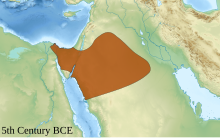
The Qedarites were a largely nomadic ancient Arab tribal confederation centred in the Wādī Sirḥān in the Syrian Desert. They were known for their nomadic lifestyle and for their role in the caravan trade that linked the Arabian Peninsula with the Mediterranean world. The Qedarites gradually expanded their territory over the course of the 8th and 7th centuries BCE, and by the 6th century BCE, they had consolidated into a kingdom that covered a large area in northern Arabia, southern Palestine, and the Sinai Peninsula. The Qedarites were influential in the ancient Near East, and their kingdom played a significant role in the political and economic affairs of the region for several centuries.[166]
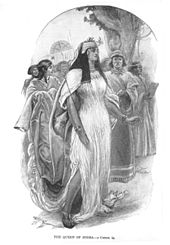
Sheba (Arabic: سَبَأٌ Saba) is kingdom mentioned in the Hebrew Bible (Old Testament) and the Quran, though Sabaean was a South Arabian languaged and not an Arabic one. Sheba features in Jewish, Muslim, and Christian traditions, whose lineage goes back to Qahtan son of Hud, one of the ancestors of the Arabs,[167][168][169] Sheba was mentioned in Assyrian inscriptions and in the writings of Greek and Roman writers.[170] One of the ancient written references that also spoke of Sheba is the Old Testament, which stated that the people of Sheba supplied Syria and Egypt with incense, especially frankincense, and exported gold and precious stones to them.[171] The Queen of Sheba who travelled to Jerusalem to question King Solomon, great caravan of camels, carrying gifts of gold, precious stones, and spices,[172] when she arrived, she was impressed by the wisdom and wealth of King Solomon, and she posed a series of difficult questions to him.[173] King Solomon was able to answer all of her questions, and the Queen of Sheba was impressed by his wisdom and his wealth.(1 Kings 10)

Sabaeans are mentioned several times in the Hebrew Bible. In the Quran,[174] they are described as either Sabaʾ (سَبَأ, not to be confused with Ṣābiʾ, صَابِئ),[168][169] or as Qawm Tubbaʿ (Arabic: قَوْم تُبَّع, lit. 'People of Tubbaʿ').[175][176] They were known for their prosperous trade and agricultural economy, which was based on the cultivation of frankincense and myrrh, these highly valued aromatic resins were exported to Egypt, Greece, and Rome, making the Sabaeans wealthy and powerful, they also traded in spices, textiles, and other luxury goods. The Maʾrib Dam was one of the greatest engineering achievements of the ancient world, and it provided water for the city of Maʾrib and the surrounding agricultural lands.[177][178][170]
Lihyan also called Dadān or Dedan was a powerful and highly organized ancient Arab kingdom that played a vital cultural and economic role in the north-western region of the Arabian Peninsula and used Dadanitic language.[179] The Lihyanites were known for their advanced organization and governance, and they played a significant role in the cultural and economic life of the region. The kingdom was centered around the city of Dedan (modern-day Al Ula), and it controlled a large territory that extended from Yathrib in the south to parts of the Levant in the north.[180][179] The Arab genealogies consider the Banu Lihyan to be Ishmaelites, and used Dadanitic language.[181]
The Kingdom of Ma'in was an ancient Arab kingdom with a hereditary monarchy system and a focus on agriculture and trade.[182] Proposed dates range from the 15th century BCE to the 1st century CE Its history has been recorded through inscriptions and classical Greek and Roman books, although the exact start and end dates of the kingdom are still debated. The Ma'in people had a local governance system with councils called "Mazood," and each city had its own temple that housed one or more gods. They also adopted the Phoenician alphabet and used it to write their language. The kingdom eventually fell to the Arab Sabaean people.[183][184]
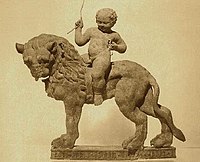
Qataban was an ancient kingdom located in the South Arabia, which existed from the early 1st millennium BCE till the late 1st or 2nd centuries CE.[186][186][187] It developed into a centralized state in the 6th century BCE with two co-kings ruling poles.[186][188] Qataban expanded its territory, including the conquest of Ma'in and successful campaigns against the Sabaeans.[187][185][189] It challenged the supremacy of the Sabaeans in the region and waged a successful war against Hadramawt in the 3rd century BCE.[185][190] Qataban's power declined in the following centuries, leading to its annexation by Hadramawt and Ḥimyar in the 1st century CE.[191][187][185][186][192][185]
The Kingdom of Hadhramaut it was known for its rich cultural heritage, as well as its strategic location along important trade routes that connected the Middle East, South Asia, and East Africa.[193] The Kingdom was established around the 3rd century BCE, and it reached its peak during the 2nd century CE, when it controlled much of the southern Arabian Peninsula. The kingdom was known for its impressive architecture, particularly its distinctive towers, which were used as watchtowers, defensive structures, and homes for wealthy families.[194] The people of Hadhramaut were skilled in agriculture, especially in growing frankincense and myrrh. They had a strong maritime culture and traded with India, East Africa, and Southeast Asia.[195] Although the kingdom declined in the 4th century, Hadhramaut remained a cultural and economic center. Its legacy can still be seen today.[196]
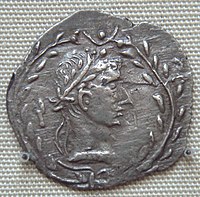
The ancient Kingdom of Awsān (8th–7th century BCE) was indeed one of the most important small kingdoms of South Arabia, and its capital Ḥajar Yaḥirr was a significant center of trade and commerce in the ancient world. It is fascinating to learn about the rich history of this region and the cultural heritage that has been preserved through the archaeological sites like Ḥajar Asfal. The destruction of the city in the 7th century BCE by the king and Mukarrib of Saba' Karab El Watar is a significant event in the history of South Arabia. It highlights the complex political and social dynamics that characterized the region at the time and the power struggles between different kingdoms and rulers. The victory of the Sabaeans over Awsān is also a testament to the military might and strategic prowess of the Sabaeans, who were one of the most powerful and influential kingdoms in the region.[197]
The Himyarite Kingdom or Himyar, was an ancient kingdom that existed from around the 2nd century BCE to the 6th century CE. It was centered in the city of Zafar, which is located in present-day Yemen. The Himyarites were an Arab people who spoke a South Arabian language and were known for their prowess in trade and seafaring,[198] they controlled the southern part of Arabia and had a prosperous economy based on agriculture, commerce, and maritime trade, they were skilled in irrigation and terracing, which allowed them to cultivate crops in the arid environment. The Himyarites converted to Judaism in the 4th century CE, and their rulers became known as the "Kings of the Jews", this conversion was likely influenced by their trade connections with the Jewish communities of the Red Sea region and the Levant, however, the Himyarites also tolerated other religions, including Christianity and the local pagan religions.[198]
Classical antiquity
The Nabataeans were nomadic Arabs who settled in a territory centred around their capital of Petra in what is now Jordan.[199][200] Their early inscriptions were in Aramaic, but gradually switched to Arabic, and since they had writing, it was they who made the first inscriptions in Arabic. The Nabataean alphabet was adopted by Arabs to the south, and evolved into modern Arabic script around the 4th century. This is attested by Safaitic inscriptions (beginning in the 1st century BCE) and the many Arabic personal names in Nabataean inscriptions. From about the 2nd century BCE, a few inscriptions from Qaryat al-Faw reveal a dialect no longer considered proto-Arabic, but pre-classical Arabic. Five Syriac inscriptions mentioning Arabs have been found at Sumatar Harabesi, one of which dates to the 2nd century CE.[201][202]
Arabs are first recorded in Palmyra in the late first millennium BCE.[203] The soldiers of the sheikh Zabdibel, who aided the Seleucids in the battle of Raphia (217 BCE), were described as Arabs; Zabdibel and his men were not actually identified as Palmyrenes in the texts, but the name "Zabdibel" is a Palmyrene name leading to the conclusion that the sheikh hailed from Palmyra.[204] After the Battle of Edessa in 260 CE. Valerian's capture by the Sassanian king Shapur I was a significant blow to Rome, and it left the empire vulnerable to further attacks. Zenobia was able to capture most of the Near East, including Egypt and parts of Asia Minor. However, their empire was short-lived, as Aurelian was able to defeat the Palmyrenes and recover the lost territories. The Palmyrenes were helped by their Arab allies, but Aurelian was also able to leverage his own alliances to defeat Zenobia and her army. Ultimately, the Palmyrene Empire lasted only a few years, but it had a significant impact on the history of the Roman Empire and the Near East.
Most scholars identify the Itureans as an Arab people who inhabited the region of Iturea,[205][206][207][208] emerged as a prominent power in the region after the decline of the Seleucid Empire in the 2nd century BCE, from their base around Mount Lebanon and the Beqaa Valley, they came to dominate vast stretches of Syrian territory,[209] and appear to have penetrated into northern parts of Palestine as far as the Galilee.[83] Tanukhids were an Arab tribal confederation that lived in the central and eastern Arabian Peninsula during the late ancient and early medieval periods. As mentioned earlier, they were a branch of the Rabi'ah tribe, which was one of the largest Arab tribes in the pre-Islamic period. They were known for their military prowess and played a significant role in the early Islamic period, fighting in battles against the Byzantine and Sassanian empires and contributing to the expansion of the Arab empire.[210]

The Osroene Arabs, also known as the Abgarids,[211][212][213] were in possession of the city of Edessa in the ancient Near East for a significant period of time. Edessa was located in the region of Osroene, which was an ancient kingdom that existed from the 2nd century BCE to the 3rd century CE. They established a dynasty known as the Abgarids, which ruled Edessa for several centuries. The most famous ruler of the dynasty was Abgar V, who is said to have corresponded with Jesus Christ and is believed to have converted to Christianity.[214] The Abgarids played an important role in the early history of Christianity in the region, and Edessa became a center of Christian learning and scholarship.[215] The Kingdom of Hatra was an ancient city located in the region of Mesopotamia, it was founded in the 2nd or 3rd century BCE and flourished as a major center of trade and culture during the Parthian Empire. The rulers of Hatra were known as the Arsacid dynasty, which was a branch of the Parthian ruling family. However, in the 2nd century CE, the Arab tribe of Banu Tanukh seized control of Hatra and established their own dynasty. The Arab rulers of Hatra assumed the title of "malka," which means king in Arabic, and they often referred to themselves as the "King of the Arabs."[216]
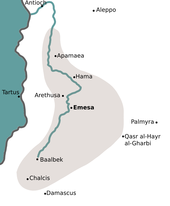
The Osroeni and Hatrans were part of several Arab groups or communities in upper Mesopotamia, which also included the Arabs of Adiabene which was an ancient kingdom in northern Mesopotamia, its chief city was Arbela (Arba-ilu), where Mar Uqba had a school, or the neighboring Hazzah, by which name the later Arabs also called Arbela.[217][218] This elaborate Arab presence in upper Mesopotamia was acknowledged by the Sasanians, who called the region Arbayistan, meaning "land of the Arabs", is first attested as a province in the Ka'ba-ye Zartosht inscription of the second Sasanian King of Kings (shahanshah) Shapur I (r. 240–270),[219] which was erected in c. 262.[220][86] The Emesene were a dynasty of Arab priest-kings that ruled the city of Emesa (modern-day Homs, Syria) in the Roman province of Syria from the 1st century CE to the 3rd century CE. The dynasty is notable for producing a number of high priests of the god El-Gabal, who were also influential in Roman politics and culture. The first ruler of the Emesene dynasty was Sampsiceramus I, who came to power in 64 CE. He was succeeded by his son, Iamblichus, who was followed by his own son, Sampsiceramus II. Under Sampsiceramus II, Emesa became a client kingdom of the Roman Empire, and the dynasty became more closely tied to Roman political and cultural traditions.[221]
Late antiquity
The Ghassanids, Lakhmids and Kindites were the last major migration of pre-Islamic Arabs out of Yemen to the north. The Ghassanids increased the Semitic presence in then-Hellenized Syria, the majority of Semites were Aramaic peoples. They mainly settled in the Hauran region and spread to modern Lebanon, Palestine and Jordan. Greeks and Romans referred to all the nomadic population of the desert in the Near East as Arabi. The Romans called Yemen "Arabia Felix".[222] The Romans called the vassal nomadic states within the Roman Empire Arabia Petraea, after the city of Petra, and called unconquered deserts bordering the empire to the south and east Arabia Magna.

The Lakhmids as a dynasty inherited their power from the Tanukhids, the mid Tigris region around their capital Al-Hira. They ended up allying with the Sassanids against the Ghassanids and the Byzantine Empire. The Lakhmids contested control of the Central Arabian tribes with the Kindites with the Lakhmids eventually destroying the Kingdom of Kinda in 540 after the fall of their main ally Himyar. The Persian Sassanids dissolved the Lakhmid dynasty in 602, being under puppet kings, then under their direct control.[223] The Kindites migrated from Yemen along with the Ghassanids and Lakhmids, but were turned back in Bahrain by the Abdul Qais Rabi'a tribe. They returned to Yemen and allied themselves with the Himyarites who installed them as a vassal kingdom that ruled Central Arabia from "Qaryah Dhat Kahl" (the present-day called Qaryat al-Faw). They ruled much of the Northern/Central Arabian peninsula, until they were destroyed by the Lakhmid king Al-Mundhir, and his son 'Amr.
The Ghassanids were an Arab tribe in the Levant in the early third century. According to Arab genealogical tradition, they were considered a branch of the Azd tribe. They fought alongside the Byzantines against the Sasanians and Arab Lakhmids. Most Ghassanids were Christians, converting to Christianity in the first few centuries, and some merged with Hellenized Christian communities. After the Muslim conquest of the Levant, few Ghassanids became Muslims, and most remained Christian and joined Melkite and Syriac communities within what is now Jordan, Palestine, Syria, and Lebanon.[224] The Salihids were Arab foederati in the 5th century, were ardent Christians, and their period is less documented than the preceding and succeeding periods due to a scarcity of sources. Most references to the Salihids in Arabic sources derive from the work of Hisham ibn al-Kalbi, with the Tarikh of Ya'qubi considered valuable for determining the Salihids' fall and the terms of their foedus with the Byzantines.[225]
Middle Ages
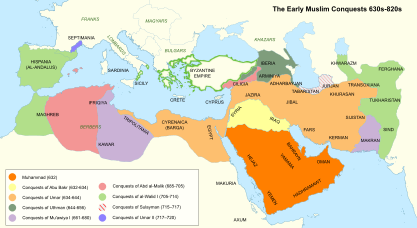
During the Middle Ages, Arab civilization flourished and the Arabs made significant contributions to the fields of science, mathematics, medicine, philosophy, and literature, with the rise of great cities like Baghdad, Cairo, and Cordoba, they became centers of learning, attracting scholars, scientists, and intellectuals.[226][227] Arabs forged many empires and dynasties, most notably, the Rashidun Empire, the Umayyad Empire, the Abbasid Empire, the Fatimid Empire, among others. These empires were characterized by their expansion, scientific achievements, and cultural flourishing, extended from Spain to India.[226] The region was vibrant and dynamic during the Middle Ages and left a lasting impact on the world.[227]

The rise of Islam began when Muhammad and his followers migrated from Mecca to Medina in an event known as the Hijra. Muhammad spent the last ten years of his life engaged in a series of battles to establish and expand the Muslim community. From 622 to 632, he led the Muslims in a state of war against the Meccans.[228] During this period, the Arabs conquered the region of Basra, and under the leadership of Umar, they established a base and built a mosque there. Another conquest was Midian, but due to its harsh environment, the settlers eventually moved to Kufa. Umar successfully defeated rebellions by various Arab tribes, bringing stability to the entire Arabian peninsula and unifying it. Under the leadership of Uthman, the Arab empire expanded through the conquest of Persia, with the capture of Fars in 650 and parts of Khorasan in 651.[229] The conquest of Armenia also began in the 640s. During this time, the Rashidun Empire extended its rule over the entire Sassanid Empire and more than two-thirds of the Eastern Roman Empire. However, the reign of Ali ibn Abi Talib, the fourth caliph, was marred by the First Fitna, or the First Islamic Civil War, which lasted throughout his rule. After a peace treaty with Hassan ibn Ali and the suppression of early Kharijite disturbances, Muawiyah I became the Caliph.[230] This marked a significant transition in leadership.[229][231]
Arab empires
Rashidun era (632–661)
After the death of Muhammad in 632, Rashidun armies launched campaigns of conquest, establishing the Caliphate, or Islamic Empire, one of the largest empires in history. It was larger and lasted longer than the previous Arab empire Tanukhids of Queen Mawia or the Arab Palmyrene Empire. The Rashidun state was a completely new state and unlike the Arab kingdoms of its century such as the Himyarite, Lakhmids or Ghassanids.
During the Rashidun era, the Arab community expanded rapidly, conquering many territories and establishing a vast Arab empire, which is marked by the reign of the first four caliphs, or leaders, of the Arab community.[232] These caliphs are Abu Bakr, Umar, Uthman and Ali, who are collectively known as the Rashidun, meaning "rightly guided." The Rashidun era is significant in Arab and Islamic history as it marks the beginning of the Arab empire and the spread of Islam beyond the Arabian Peninsula. During this time, the Arab community faced numerous challenges, including internal divisions and external threats from neighboring empires.[232][233]
Under the leadership of Abu Bakr, the Arab community successfully quelled a rebellion by some tribes who refused to pay Zakat, or Islamic charity. During the reign of Umar ibn al-Khattab, the Arab empire expanded significantly, conquering territories such as Egypt, Syria, and Iraq. The reign of Uthman ibn Affan was marked by internal dissent and rebellion, which ultimately led to his assassination. Ali, the cousin and son-in-law of Muhammad, succeeded Uthman as caliph but faced opposition from some members of the Islamic community who believed he was not rightfully appointed.[232] Despite these challenges, the Rashidun era is remembered as a time of great progress and achievement in Arab and Islamic history, the caliphs established a system of governance that emphasized justice and equality for all members of the Islamic community. They also oversaw the compilation of the Quran into a single text and spread Arabic teachings and principles throughout the empire. Overall, the Rashidun era played a crucial role in shaping Arab history and continues to be revered by Muslims worldwide as a period of exemplary leadership and guidance.[234]
Umayyad era (661–750 & 756–1031)
In 661, the Rashidun Caliphate fell into the hands of the Umayyad dynasty and Damascus was established as the empire's capital. The Umayyads were proud of their Arab identity and sponsored the poetry and culture of pre-Islamic Arabia. They established garrison towns at Ramla, Raqqa, Basra, Kufa, Mosul and Samarra, all of which developed into major cities.[235] Caliph Abd al-Malik established Arabic as the Caliphate's official language in 686.[236] Caliph Umar II strove to resolve the conflict when he came to power in 717. He rectified the disparity, demanding that all Muslims be treated as equals, but his intended reforms did not take effect, as he died after only three years of rule. By now, discontent with the Umayyads swept the region and an uprising occurred in which the Abbasids came to power and moved the capital to Baghdad.
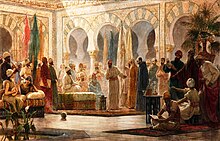
Umayyads expanded their Empire westwards capturing North Africa from the Byzantines. Before the Arab conquest, North Africa was conquered or settled by various people including Punics, Vandals and Romans. After the Abbasid Revolution, the Umayyads lost most of their territories with the exception of Iberia.
Their last holding became known as the Emirate of Córdoba. It was not until the rule of the grandson of the founder of this new emirate that the state entered a new phase as the Caliphate of Córdoba. This new state was characterized by an expansion of trade, culture and knowledge, and saw the construction of masterpieces of al-Andalus architecture and the library of Al-Ḥakam II which housed over 400,000 volumes. With the collapse of the Umayyad state in 1031 CE, Al-Andalus was divided into small kingdoms.[237]
Abbasid era (750–1258 and 1261–1517)
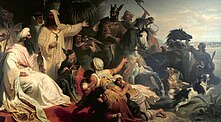
The Abbasids were the descendants of Abbas ibn Abd al-Muttalib, one of the youngest uncles of Muhammad and of the same Banu Hashim clan. The Abbasids led a revolt against the Umayyads and defeated them in the Battle of the Zab effectively ending their rule in all parts of the Empire with the exception of al-Andalus. In 762, the second Abbasid Caliph al-Mansur founded the city of Baghdad and declared it the capital of the Caliphate. Unlike the Umayyads, the Abbasids had the support of non-Arab subjects.[235] The Islamic Golden Age was inaugurated by the middle of the 8th century by the ascension of the Abbasid Caliphate and the transfer of the capital from Damascus to the newly founded city of Baghdad. The Abbasids were influenced by the Quranic injunctions and hadith such as "The ink of the scholar is more holy than the blood of martyrs" stressing the value of knowledge.
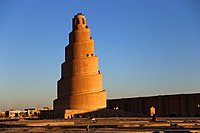
During this period the Arab Empire became an intellectual centre for science, philosophy, medicine and education as the Abbasids championed the cause of knowledge and established the "House of Wisdom" (Arabic: بيت الحكمة) in Baghdad. Rival dynasties such as the Fatimids of Egypt and the Umayyads of al-Andalus were also major intellectual centres with cities such as Cairo and Córdoba rivaling Baghdad.[238] The Abbasids ruled for 200 years before they lost their central control when Wilayas began to fracture in the 10th century; afterwards, in the 1190s, there was a revival of their power, which was ended by the Mongols, who conquered Baghdad in 1258 and killed the Caliph Al-Musta'sim. Members of the Abbasid royal family escaped the massacre and resorted to Cairo, which had broken from the Abbasid rule two years earlier; the Mamluk generals taking the political side of the kingdom while Abbasid Caliphs were engaged in civil activities and continued patronizing science, arts and literature.
Fatimid era (909–1171)
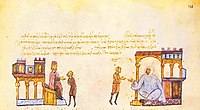
The Fatimid caliphate was founded by al-Mahdi Billah, a descendant of Fatimah, the daughter of Muhammad, the Fatimid Caliphate was a Shia that existed from 909 to 1171 CE. The empire was based in North Africa, with its capital in Cairo, and at its height, it controlled a vast territory that included parts of modern-day Egypt, Libya, Tunisia, Algeria, Morocco, Syria, and Palestine. The Fatimid state took shape among the Kutama, in the West of the North African littoral, in Algeria, in 909 conquering Raqqada, the Aghlabid capital. In 921 the Fatimids established the Tunisian city of Mahdia as their new capital. In 948 they shifted their capital to Al-Mansuriya, near Kairouan in Tunisia, and in 969 they conquered Egypt and established Cairo as the capital of their caliphate.
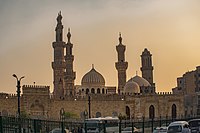
The Fatimids were known for their religious tolerance and intellectual achievements, they established a network of universities and libraries that became centers of learning in the Islamic world. They also promoted the arts, architecture, and literature, which flourished under their patronage. One of the most notable achievements of the Fatimids was the construction of the Al-Azhar Mosque and Al-Azhar University in Cairo. Founded in 970 CE, it is one of the oldest universities in the world and remains an important center of Islamic learning to this day. The Fatimids also had a significant impact on the development of Islamic theology and jurisprudence. They were known for their support of Shia Islam and their promotion of the Ismaili branch of Shia Islam. Despite their many achievements, the Fatimids faced numerous challenges during their reign. They were constantly at war with neighboring empires, including the Abbasid Caliphate and the Byzantine Empire. They also faced internal conflicts and rebellions, which weakened their empire over time. In 1171 CE, the Fatimid Caliphate was conquered by the Ayyubid dynasty, led by Saladin. Although the Fatimid dynasty came to an end, its legacy continued to influence Arab-Islamic culture and society for centuries to come.[239]
Ottoman era (1517–1918)
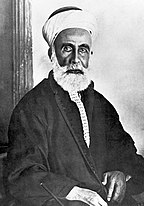
From 1517 to 1918, The Ottomans defeated the Mamluk Sultanate in Cairo, and ended the Abbasid Caliphate in the battles of Marj Dabiq and Ridaniya. They entered the Levant and Egypt as conquerors, and brought down the Abbasid caliphate after it lasted for many centuries. In 1911, Arab intellectuals and politicians from throughout the Levant formed al-Fatat ("the Young Arab Society"), a small Arab nationalist club, in Paris. Its stated aim was "raising the level of the Arab nation to the level of modern nations." In the first few years of its existence, al-Fatat called for greater autonomy within a unified Ottoman state rather than Arab independence from the empire. Al-Fatat hosted the Arab Congress of 1913 in Paris, the purpose of which was to discuss desired reforms with other dissenting individuals from the Arab world.[240] However, as the Ottoman authorities cracked down on the organization's activities and members, al-Fatat went underground and demanded the complete independence and unity of the Arab provinces.[241]

The Arab Revolt was a military uprising of Arab forces against the Ottoman Empire during World War I, began in 1916, led by Sherif Hussein bin Ali, the goal of the revolt was to gain independence for the Arab lands under Ottoman rule and to create a unified Arab state. The revolt was sparked by a number of factors, including the Arab desire for greater autonomy within the Ottoman Empire, resentment towards Ottoman policies, and the influence of Arab nationalist movements. The Arab Revolt was a significant factor in the eventual defeat of the Ottoman Empire. The revolt helped to weaken Ottoman military power and tie up Ottoman forces that could have been deployed elsewhere. It also helped to increase support for Arab independence and nationalism, which would have a lasting impact on the region in the years to come.[242][243] The Empire's defeat and the occupation of part of its territory by the Allied Powers in the aftermath of World War I, the Sykes–Picot Agreement had a significant impact on the Arab world and its people. The agreement divided the Arab territories of the Ottoman Empire into zones of control for France and Britain, ignoring the aspirations of the Arab people for independence and self-determination.[244]
Renaissance
The Golden Age of Arab Civilization known as the "Islamic Golden Age", traditionally dated from the 8th century to the 13th century.[245][246][247] The period is traditionally said to have ended with the collapse of the Abbasid caliphate due to Siege of Baghdad in 1258.[248] During this time, Arab scholars made significant contributions to fields such as mathematics, astronomy, medicine, and philosophy. These advancements had a profound impact on European scholars during the Renaissance.[249]
The Arabs shared its knowledge and ideas with Europe, including translations of Arabic texts.[250] These translations had a significant impact on culture of Europe, leading to the transformation of many philosophical disciplines in the medieval Latin world. Additionally, the Arabs made original innovations in various fields, including the arts, agriculture, alchemy, music, and pottery, and traditional star names such as Aldebaran, scientific terms like alchemy (whence also chemistry), algebra, algorithm, etc. and names of commodities such as sugar, camphor, cotton, coffee, etc.[251][252][253][254]
From the medieval scholars of the Renaissance of the 12th century, who had focused on studying Greek and Arabic works of natural sciences, philosophy, and mathematics, rather than on such cultural texts. Arab logician, most notably Averroes, had inherited Greek ideas after they had invaded and conquered Egypt and the Levant. Their translations and commentaries on these ideas worked their way through the Arab West into Iberia and Sicily, which became important centers for this transmission of ideas. From the 11th to the 13th century, many schools dedicated to the translation of philosophical and scientific works from Classical Arabic to Medieval Latin were established in Iberia, most notably the Toledo School of Translators. This work of translation from Arab culture, though largely unplanned and disorganized, constituted one of the greatest transmissions of ideas in history.[255]
During the Timurid Renaissance spanning the late 14th, the 15th, and the early 16th centuries, there was a significant exchange of ideas, art, and knowledge between different cultures and civilizations. Arab scholars, artists, and intellectuals played a role in this cultural exchange, contributing to the overall intellectual atmosphere of the time. They participated in various fields, including literature, art, science, and philosophy.[256] In the late 19th and early 20th centuries, the Arab Renaissance, also known as the Nahda, was a cultural and intellectual movement that emerged. The term "Nahda" means "awakening" or "renaissance" in Arabic, and refers to a period of renewed interest in Arabic language, literature, and culture.[257][258][259]
Modern period

The modern period in Arab history refers to the time period from the late 19th century to the present day. During this time, the Arab world experienced significant political, economic, and social changes. One of the most significant events of the modern period was the collapse of the Ottoman Empire, the end of Ottoman rule led to the emergence of new nation-states in the Arab world.[260][261]
Sharif Hussein was supposed, in the event of the success of the Arab revolution and the victory of the Allies in World War I, to be able to establish an independent Arab state consisting of the Arabian Peninsula and the Fertile Crescent, including Iraq and the Levant. He aimed to become "King of the Arabs" in this state, however, the Arab revolution only succeeded in achieving some of its objectives, including the independence of the Hejaz and the recognition of Sharif Hussein as its king by the Allies.[262]
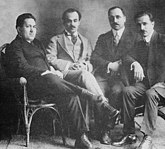
Arab nationalism emerged as a major movement in the early 20th century, with many Arab intellectuals, artists, and political leaders seeking to promote unity and independence for the Arab world.[264] This movement gained momentum after World War II, leading to the formation of the Arab League and the creation of several new Arab states. Pan-Arabism that emerged in the early 20th century and aimed to unite all Arabs into a single nation or state. It emphasized on a shared ancestry, culture, history, language and identity and sought to create a sense of pan-Arab identity and solidarity.[265][266]
The roots of pan-Arabism can be traced back to the Arab Renaissance or Al-Nahda movement of the late 19th century, which saw a revival of Arab culture, literature, and intellectual thought. The movement emphasized the importance of Arab unity and the need to resist colonialism and foreign domination. One of the key figures in the development of pan-Arabism was the Egyptian statesman and intellectual, Gamal Abdel Nasser, who led the 1952 revolution in Egypt and became the country's president in 1954. Nasser promoted pan-Arabism as a means of strengthening Arab solidarity and resisting Western imperialism. He also supported the idea of Arab socialism, which sought to combine pan-Arabism with socialist principles. Similar attempts were made by other Arab leaders, such as Hafiz al-Assad, Ahmed Hassan al-Bakr, Faisal I of Iraq, Muammar Gaddafi, Saddam Hussein, Gaafar Nimeiry and Anwar Sadat.[267]

Many proposed unions aimed to create a unified Arab entity that would promote cooperation and integration among Arab countries. However, the initiatives faced numerous challenges and obstacles, including political divisions, regional conflicts, and economic disparities.[268] The United Arab Republic (UAR) was a political union formed between Egypt and Syria in 1958, with the goal of creating a federal structure that would allow each member state to retain its identity and institutions. However, by 1961, Syria had withdrawn from the UAR due to political differences, and Egypt continued to call itself the UAR until 1971, when it became the Arab Republic of Egypt. In the same year the UAR was formed, another proposed political union, the Arab Federation, was established between Jordan and Iraq, but it collapsed after only six months due to tensions with the UAR and the 14 July Revolution. A confederation called the United Arab States, which included the UAR and the Mutawakkilite Kingdom of Yemen, was also created in 1958 but dissolved in 1961.[269] Later attempts to create a political and economic union among Arab countries included the Federation of Arab Republics, which was formed by Egypt, Libya, and Syria in the 1970s but dissolved after five years due to political and economic challenges. Muammar Gaddafi, the leader of Libya, also proposed the Arab Islamic Republic with Tunisia, aiming to include Algeria and Morocco,[270] instead the Arab Maghreb Union was formed in 1989.[271]
During the latter half of the 20th century, many Arab countries experienced political upheaval and conflicts, including, revolutions. The Arab-Israeli conflict remains a major issue in the region, and has resulted in ongoing tensions and periodic outbreaks of violence. In recent years, the Arab world has faced new challenges, including economic and social inequalities, demographic changes, and the impact of globalization.[272] The Arab Spring was a series of pro-democracy uprisings and protests that swept across several countries in the Arab world in 2010 and 2011. The uprisings were sparked by a combination of political, economic, and social grievances and called for democratic reforms and an end to authoritarian rule. While the protests resulted in the downfall of some long-time authoritarian leaders, they also led to ongoing conflicts and political instability in other countries.[273]
Identity
Arab identity is defined independently of religious identity, and pre-dates the spread of Islam, with historically attested Arab Christian kingdoms and Arab Jewish tribes. Today, however, most Arabs are Muslim, with a minority adhering to other faiths, largely Christianity, but also Druze and Baháʼí.[274][275] Paternal descent has traditionally been considered the main source of affiliation in the Arab world when it comes to membership into an ethnic group or clan.[276]
Arab identity is shaped by a range of factors, including ancestry, history, language, customs, and traditions.[277] Arab identity has been shaped by a rich history that includes the rise and fall of empires, colonization, and political turmoil. Despite the challenges faced by Arab communities, their shared cultural heritage has helped to maintain a sense of unity and pride in their identity.[278] Today, Arab identity continues to evolve as Arab communities navigate complex political, social, and economic landscapes. Despite this, the Arab identity remains an important aspect of the cultural and historical fabric of the Arab world, and continues to be celebrated and preserved by communities around the world.[279]
Subgroups

Arab tribes are prevalent in the Arabian Peninsula, Mesopotamia, Levant, Egypt, Maghreb, the Sudan region and Horn Africa.[280][278][281]
The Arabs of the Levant are traditionally divided into Qays and Yaman tribes. The distinction between Qays and Yaman dates back to the pre-Islamic era and was based on tribal affiliations and geographic locations.; they include Banu Kalb, Kinda, Ghassanids, and Lakhmids.[282] The Qays were made up of tribes such as Banu Kilab, Banu Tayy, Banu Hanifa, and Banu Tamim, among others. The Yaman, on the other hand, were composed of tribes such as Banu Hashim, Banu Makhzum, Banu Umayya, and Banu Zuhra, among others.
There are also many Arab tribes indigenous to Mesopotamia (Iraq) and Iran, including from well before the Arab conquest of Persia in 633 CE.[283] The largest group of Iranian Arabs are the Ahwazi Arabs, including Banu Ka'b, Bani Turuf and the Musha'sha'iyyah sect. Smaller groups are the Khamseh nomads in Fars Province and the Arabs in Khorasan.As a result of the centuries-long Arab migration to the Maghreb, various Arab tribes (including Banu Hilal, Banu Sulaym and Maqil) also settled in the Maghreb and formed the sub-tribes which exist to present-day. The Banu Hilal spent almost a century in Egypt before moving to Libya, Tunisia and Algeria, and another century later moved to Morocco.[284]
According to Arab traditions, tribes are divided into different divisions called Arab skulls, which are described in the traditional custom of strength, abundance, victory, and honor. A number of them branched out, which later became independent tribes (sub-tribes). The majority of Arab tribes are descended from these major tribes.[285][286][287][288][289]
They are:[287]
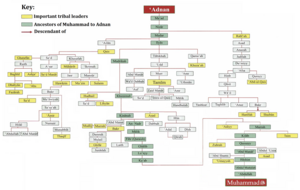
- Bakr, has descendants in Arabia and Iraq.[290]
- Kinanah, has descendants in Arabia, Iraq, Egypt, Sudan, Palestine, Tunisia, Morocco, and Syria.[291]
- Hawazin, has descendants in Arabia, Libya, Algeria, Morocco, Sudan, and Iraq.[292][293][294]
- Tamim, has descendants in Arabia, Iraq, Iran, Palestine, Algeria, and Morocco[295]
- Azd, has descendants in Arabia, Iraq, Levant, and North Africa.[296]
- Ghatafan, has descendants in Arabia and the Maghreb.[297]
- Madhhij, has descendants in Arabia and Iraq.[298]
- Abd al-Qays, has descendants in Arabia.
- Al Qays (القيس), has descendants in Arabia.
- Quda'a, has descendants in Arabia, Syria, and North Africa.
Geographic distribution
Arab homeland
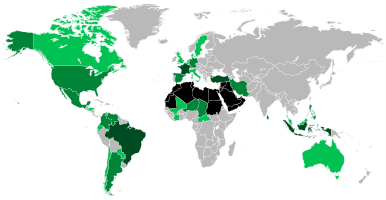
The total number of Arabs living in the Arab nations is estimated at 366 million by the CIA Factbook (as of 2014). The estimated number of Arabs in countries outside the Arab League is estimated at 17.5 million, yielding a total of close to 384 million. The Arab world stretches around 13,000,000 square kilometres (5,000,000 sq mi), from the Atlantic Ocean in the west to the Arabian Sea in the east and from the Mediterranean Sea in the north to the Horn of Africa and the Indian Ocean in the southeast.
Arab diaspora
Arab diaspora refers to descendants of the Arab immigrants who, voluntarily or as refugees, emigrated from their native lands in non-Arab countries, primarily in East Africa, South America, Europe, North America, Australia and parts of South Asia, Southeast Asia, the Caribbean, and West Africa. According to the International Organization for Migration, there are 13 million first-generation Arab migrants in the world, of which 5.8 million reside in Arab countries. Arab expatriates contribute to the circulation of financial and human capital in the region and thus significantly promote regional development. In 2009, Arab countries received a total of US$35.1 billion in remittance in-flows and remittances sent to Jordan, Egypt and Lebanon from other Arab countries are 40 to 190 per cent higher than trade revenues between these and other Arab countries.[299] The 250,000 strong Lebanese community in West Africa is the largest non-African group in the region.[300][301] Arab traders have long operated in Southeast Asia and along the East Africa's Swahili coast. Zanzibar was once ruled by Omani Arabs.[302] Most of the prominent Indonesians, Malaysians, and Singaporeans of Arab descent are Hadhrami people with origins in southern Arabia in the Hadramawt coastal region.[303]
Europe
There are millions of Arabs living in Europe, mostly concentrated in France (about 6,000,000 in 2005[304]). Most Arabs in France are from the Maghreb but some also come from the Mashreq areas of the Arab world. Arabs in France form the second largest ethnic group after French people.[305] In Italy, Arabs first arrived on the southern island of Sicily in the 9th century. The largest modern societies on the island from the Arab world are Tunisians and Moroccans, who make up 10.9% and 8% respectively of the foreign population of Sicily, which in itself constitutes 3.9% of the island's total population.[306] The modern Arab population of Spain numbers 1,800,000,[307][308][309][310] and there have been Arabs in Spain since the early 8th century when the Muslim conquest of Hispania created the state of Al-Andalus.[311][312][313] Arabs In Germany the Arab population numbers over 1,401,950.[314][315] in the United Kingdom between 366,769[316] and 500,000,[317] and in Greece between 250,000 and 750,000[318]). In addition, Greece is home to people from Arab countries who have the status of refugees (e.g. refugees of the Syrian civil war).[319] In the Netherlands 180,000,[38] and in Denmark 121,000. Other countries are also home to Arab populations, including Norway, Austria, Bulgaria, Switzerland, North Macedonia, Romania and Serbia.[320] As of late 2015, Turkey had a total population of 78.7 million, with Syrian refugees accounting for 3.1% of that figure based on conservative estimates. Demographics indicated that the country previously had 1,500,000[321] to 2,000,000 Arab residents,[12] Turkey's Arab population is now 4.5 to 5.1% of the total population, or approximately 4–5 million people.[12][322]
Americas
Arab immigration to the United States began in larger numbers during the 1880s, and today, an estimated 3.7 million Americans have some Arabic background.[14][323][324] Arab Americans are found in every state, but more than two thirds of them live in just ten states, and one-third live in Los Angeles, Detroit, and New York City specifically.[14][325] Most Arab Americans were born in the US, and nearly 82% of US-based Arabs are citizens.[326][327][328][329]
Arabs immigrants began to arrive in Canada in small numbers in 1882. Their immigration was relatively limited until 1945, after which time it increased progressively, particularly in the 1960s and thereafter.[330] According to the website "Who are Arab Canadians", Montreal, the Canadian city with the largest Arab population, has approximately 267,000 Arab inhabitants.[331]
Latin America has the largest Arab population outside of the Arab World.[332] Latin America is home to anywhere from 17–25 to 30 million people of Arab descent, which is more than any other diaspora region in the world.[333][334] The Brazilian and Lebanese governments claim there are 7 million Brazilians of Lebanese descent.[335][336] Also, the Brazilian government claims there are 4 million Brazilians of Syrian descent.[335][7][337][338][339][340] Other large Arab communities includes Argentina (about 3,500,000[15][341][342])
The interethnic marriage in the Arab community, regardless of religious affiliation, is very high; most community members have only one parent who has Arab ethnicity.[343] Colombia (over 3,200,000[344][345][346]), Venezuela (over 1,600,000),[25][347] Mexico (over 1,100,000),[348] Chile (over 800,000),[349][350][351] and Central America, particularly El Salvador, and Honduras (between 150,000 and 200,000).[352][31][32] Arab Haitians (257,000[353]) a large number of whom live in the capital are more often than not, concentrated in financial areas where the majority of them establish businesses.[354]
Caucasus
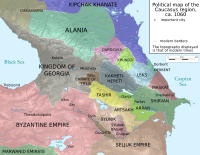
In 1728, a Russian officer described a group of Arab nomads who populated the Caspian shores of Mughan (in present-day Azerbaijan) and spoke a mixed Turkic-Arabic language.[355] It is believed that these groups migrated to the South Caucasus in the 16th century.[356] The 1888 edition of Encyclopædia Britannica also mentioned a certain number of Arabs populating the Baku Governorate of the Russian Empire.[357] They retained an Arabic dialect at least into the mid-19th century,[358] there are nearly 30 settlements still holding the name Arab (for example, Arabgadim, Arabojaghy, Arab-Yengija, etc.). From the time of the Arab conquest of the South Caucasus, continuous small-scale Arab migration from various parts of the Arab world occurred in Dagestan. The majority of these lived in the village of Darvag, to the north-west of Derbent. The latest of these accounts dates to the 1930s.[356] Most Arab communities in southern Dagestan underwent linguistic Turkicisation, thus nowadays Darvag is a majority-Azeri village.[359][360]
Central, South, East and Southeast Asia
According to the History of Ibn Khaldun, the Arabs that were once in Central Asia have been either killed or have fled the Tatar invasion of the region, leaving only the locals.[361] However, today many people in Central Asia identify as Arabs. Most Arabs of Central Asia are fully integrated into local populations, and sometimes call themselves the same as locals (for example, Tajiks, Uzbeks) but they use special titles to show their Arab origin such as Sayyid, Khoja or Siddiqui.[362]
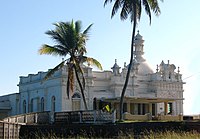
There are only two communities in India which claim Arab descent, the Chaush of the Deccan region and the Chavuse of Gujarat.[364][365] These groups are largely descended from Hadhrami migrants who settled in these two regions in the 18th century. However, neither community still speaks Arabic, although the Chaush have seen re-immigration to Eastern Arabia and thus a re-adoption of Arabic.[366] In South Asia, where Arab ancestry is considered prestigious, some communities have origin myths that claim Arab ancestry. Several communities following the Shafi'i madhab (in contrast to other South Asian Muslims who follow the Hanafi madhab) claim descent from Arab traders like the Konkani Muslims of the Konkan region, the Mappilla of Kerala, and the Labbai and Marakkar of Tamil Nadu and a few Christian groups in India that claim and have Arab roots are situated in the state of Kerala.[367] South Asian Iraqi biradri may have records of their ancestors who migrated from Iraq in historical documents. The Sri Lankan Moors are the third largest ethnic group in Sri Lanka, constituting 9.23% of the country's total population.[368] Some sources trace the ancestry of the Sri Lankan Moors to Arab traders who settled in Sri Lanka at some time between the 8th and 15th centuries.[369][370][371] There are about 5,000,000 Native Indonesians with Arab ancestry,[372] of Hadrami descent.[373][373]
Sub-Saharan Africa
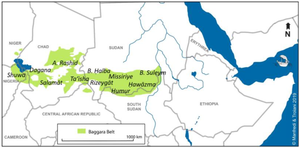
Afro-Arabs are individuals and groups from Africa who are of partial Arab descent. Most Afro-Arabs inhabit the Swahili Coast in the African Great Lakes region, although some can also be found in parts of the Arab world.[374][375] Large numbers of Arabs migrated to West Africa, particularly Côte d'Ivoire (home to over 100,000 Lebanese),[376] Senegal (roughly 30,000 Lebanese),[377] Sierra Leone (roughly 10,000 Lebanese today; about 30,000 prior to the outbreak of civil war in 1991), Liberia, and Nigeria.[378] Since the end of the civil war in 2002, Lebanese traders have become re-established in Sierra Leone.[379][380][381] The Arabs of Chad occupy northern Cameroon and Nigeria (where they are sometimes known as Shuwa), and extend as a belt across Chad and into Sudan, where they are called the Baggara grouping of Arab ethnic groups inhabiting the portion of Africa's Sahel. There are 171,000 in Cameroon, 150,000 in Niger[382]), and 107,000 in the Central African Republic.[383]
Religion
Arabs are mostly Muslims with a Sunni majority and a Shia minority, one exception being the Ibadis, who predominate in Oman.[384] Arab Christians generally follow Eastern Churches such as the Greek Orthodox and Greek Catholic churches, though a minority of Protestant Church followers also exists.[385] There are also Arab communities consisting of Druze and Baháʼís.[386][387] Historically, there were also sizeable populations of Arab Jews around the Arab World.
Before the coming of Islam, most Arabs followed a pagan religion with a number of deities, including Hubal,[388] Wadd, Allāt,[389] Manat, and Uzza. A few individuals, the hanifs, had apparently rejected polytheism in favor of monotheism unaffiliated with any particular religion. Some tribes had converted to Christianity or Judaism. The most prominent Arab Christian kingdoms were the Ghassanid and Lakhmid kingdoms.[390] When the Himyarite king converted to Judaism in the late 4th century,[391] the elites of the other prominent Arab kingdom, the Kindites, being Himyirite vassals, apparently also converted (at least partly). With the expansion of Islam, polytheistic Arabs were rapidly Islamized, and polytheistic traditions gradually disappeared.[392][393]
Today, Sunni Islam dominates in most areas, vastly so in Levant, North Africa, West Africa and the Horn of Africa. Shia Islam is dominant in Bahrain and southern Iraq while northern Iraq is mostly Sunni. Substantial Shia populations exist in Lebanon, Yemen, Kuwait, Saudi Arabia,[394] northern Syria and Al-Batinah Region in Oman. There are small numbers of Ibadi and non-denominational Muslims too.[384] The Druze community is concentrated in Levant.[395]
Christianity had a prominent presence In pre-Islamic Arabia among several Arab communities, including the Bahrani people of Eastern Arabia, the Christian community of Najran, in parts of Yemen, and among certain northern Arabian tribes such as the Ghassanids, Lakhmids, Taghlib, Banu Amela, Banu Judham, Tanukhids and Tayy. In the early Christian centuries, Arabia was sometimes known as Arabia heretica, due to its being "well known as a breeding-ground for heterodox interpretations of Christianity."[396] Christians make up 5.5% of the population of Western Asia and North Africa.[397] In Lebanon, Christians number about 40.5% of the population.[398] In Syria, Christians make up 10% of the population.[399] Christians in Palestine make up 8% and 0.7% of the populations, respectively.[400][401] In Egypt, Christians number about 10% of the population. In Iraq, Christians constitute 0.1% of the population.[402]
In Israel, Arab Christians constitute 2.1% (roughly 9% of the Arab population).[403] Arab Christians make up 8% of the population of Jordan.[404] Most North and South American Arabs are Christian,[405] so are about half of the Arabs in Australia who come particularly from Lebanon, Syria and Palestine. One well known member of this religious and ethnic community is Saint Abo, martyr and the patron saint of Tbilisi, Georgia.[406] Arab Christians also live in holy Christian cities such as Nazareth, Bethlehem and the Christian Quarter of the Old City of Jerusalem and many other villages with holy Christian sites.
Culture
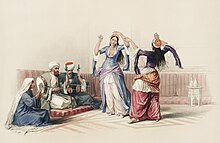
Arab culture is shaped by a long and rich history that spans thousands of years, from the Atlantic Ocean in the west to the Arabian Sea in the east, and from the Mediterranean Sea in the north to the Horn of Africa and the Indian Ocean in the southeast. The various religions the Arabs have adopted throughout their history and the various empires and kingdoms that have ruled and took lead of the Arabic civilization have contributed to the ethnogenesis and formation of modern Arab culture. Language, literature, gastronomy, art, architecture, music, spirituality, philosophy and mysticism are all part of the cultural heritage of the Arabs.[407]
Language

Arabic is a Semitic language of the Afro-Asiatic Family.[408] The first evidence for the emergence of the language appears in military accounts from 853 BCE. Today it has developed widely used as a lingua franca for more than 500 million people. It is also a liturgical language for 1.7 billion Muslims.[409][410] Arabic is one of six official languages of the United Nations,[411] and is revered in Islam as the language of the Quran.[409][412]
Arabic has two main registers. Classical Arabic is the form of the Arabic language used in literary texts from Umayyad and Abbasid times (7th to 9th centuries). It is based on the medieval dialects of Arab tribes. Modern Standard Arabic (MSA) is the direct descendant used today throughout the Arab world in writing and in formal speaking, for example, prepared speeches, some radio broadcasts, and non-entertainment content,[413] while the lexis and stylistics of Modern Standard Arabic are different from Classical Arabic. There are also various regional dialects of colloquial spoken Arabic that both vary greatly from both each other and from the formal written and spoken forms of Arabic.[414]
Mythology

Arabic mythology comprises the ancient beliefs of the Arabs. Prior to Islam the Kaaba of Mecca was covered in symbols representing the myriad demons, djinn, demigods, or simply tribal gods and other assorted deities which represented the polytheistic culture of pre-Islamic. It has been inferred from this plurality an exceptionally broad context in which mythology could flourish.[415][416]
The most popular beasts and demons of Arabian mythology are Bahamut, Dandan, Falak, Ghoul, Hinn, Jinn, Karkadann, Marid, Nasnas, Qareen, Roc, Shadhavar, Werehyena and other assorted creatures which represented the profoundly polytheistic environment of pre-Islamic.[417]
The most prominent symbol of Arabian mythology is the Jinn or genie.[418] Jinns are supernatural beings that can be good or evil.[419][420] They are not purely spiritual, but are also physical in nature, being able to interact in a tactile manner with people and objects and likewise be acted upon. The jinn, humans, and angels make up the known sapient creations of God.[421]
Ghouls also feature in the mythology as a monster or evil spirit associated with graveyards and consuming human flesh.[422][423] In Arabic folklore, ghouls belonged to a diabolic class of jinn and were said to be the offspring of Iblīs, the prince of darkness in Islam. They were capable of constantly changing form, but always retained donkey's hooves.[424]
Literature
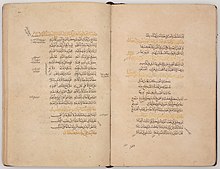
The Quran, the main holy book of Islam, had a significant influence on the Arabic language, and marked the beginning of Arabic literature. Muslims believe it was transcribed in the Arabic dialect of the Quraysh, the tribe of Muhammad.[425][426] As Islam spread, the Quran had the effect of unifying and standardizing Arabic.[425]
Not only is the Quran the first work of any significant length written in the language, but it also has a far more complicated structure than the earlier literary works with its 114 suwar (chapters) which contain 6,236 ayat (verses). It contains injunctions, narratives, homilies, parables, direct addresses from God, instructions and even comments on how the Quran will be received and understood. It is also admired for its layers of metaphor as well as its clarity, a feature which is mentioned in An-Nahl, the 16th surah.
Al-Jahiz (born 776, in Basra – December 868/January 869) was an Arab prose writer and author of works of literature, Mu'tazili theology, and politico-religious polemics. A leading scholar in the Abbasid Caliphate, his canon includes two hundred books on various subjects, including Arabic grammar, zoology, poetry, lexicography, and rhetoric. Of his writings, only thirty books survive. Al-Jāḥiẓ was also one of the first Arabian writers to suggest a complete overhaul of the language's grammatical system, though this would not be undertaken until his fellow linguist Ibn Maḍāʾ took up the matter two hundred years later.[427]
There is a small remnant of pre-Islamic poetry, but Arabic literature predominantly emerges in the Middle Ages, during the Golden Age of Islam.[428] Imru' al-Qais was a king and poet in the 6th century, he was the last king of Kindite. He is among the finest Arabic poetry to date, as well sometimes considered the father of Arabic poetry.[429] Kitab al-Aghani by Abul-Faraj was called by the 14th-century historian Ibn Khaldun the register of the Arabs.[430] Literary Arabic is derived from Classical Arabic, based on the language of the Quran as it was analyzed by Arabic grammarians beginning in the 8th century.[431]

A large portion of Arabic literature before the 20th century is in the form of poetry, and even prose from this period is either filled with snippets of poetry or is in the form of saj or rhymed prose.[432] The ghazal or love poem had a long history being at times tender and chaste and at other times rather explicit.[433] In the Sufi tradition the love poem would take on a wider, mystical and religious importance.
Arabic epic literature was much less common than poetry, and presumably originates in oral tradition, written down from the 14th century or so. Maqama or rhymed prose is intermediate between poetry and prose, and also between fiction and non-fiction.[434] Maqama was an incredibly popular form of Arabic literature, being one of the few forms which continued to be written during the decline of Arabic in the 17th and 18th centuries.[435]
Arabic literature and culture declined significantly after the 13th century, to the benefit of Turkish and Persian. A modern revival took place beginning in the 19th century, alongside resistance against Ottoman rule. The literary revival is known as al-Nahda in Arabic, and was centered in Egypt and Lebanon. Two distinct trends can be found in the nahda period of revival.[436]
The first was a neo-classical movement which sought to rediscover the literary traditions of the past, and was influenced by traditional literary genres—such as the maqama—and works like One Thousand and One Nights. In contrast, a modernist movement began by translating Western modernist works—primarily novels—into Arabic.[437] A tradition of modern Arabic poetry was established by writers such as Francis Marrash, Ahmad Shawqi and Hafiz Ibrahim. Iraqi poet Badr Shakir al-Sayyab is considered to be the originator of free verse in Arabic poetry.[438][439][440]
Cuisine
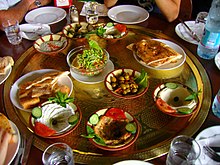
Arab cuisine is largely divided into Khaleeji cuisine, Levantine cuisine and Maghrebi cuisine.[441] Arab cuisine has influenced other cuisines various cultures, including Ottoman, Persian, and Andalusian.
It is characterized by a variety of herbs and spices, including cumin, coriander, cinnamon, sumac, za'atar, cardamom, mint, saffron, sesame, thyme turmeric and parsley.[442][443] Arab cuisine is also known for its sweets and desserts, such as Knafeh, Baklava, Halva, and Qatayef. Arabic coffee, or qahwa, is a traditional drink that is served with dates.
Art
Arabic art has taken various forms, including, among other things, jewelry, textiles and architecture.[444][445] Arabic script has also traditionally been heavily embellished with often colorful Arabic calligraphy, with one notable and widely used example being Kufic script.[446] Arabic miniatures (Arabic: الْمُنَمْنَمَات الْعَرَبِيَّة, Al-Munamnamāt al-ʿArabīyah) are small paintings on paper, usually book or manuscript illustrations but also sometimes separate artworks that occupy entire pages. The earliest example dates from around 690 CE, with a flourishing of the art from between 1000 and 1200 CE in the Abbasid caliphate. The art form went through several stages of evolution while witnessing the fall and rise of several Arab caliphates.
Arab miniaturists got totally assimilated and subsequently disappeared due to the Ottoman occupation of the Arab world. Nearly all forms of Islamic miniatures (Persian miniatures, Ottoman miniatures and Mughal miniatures) owe their existences to Arabic miniatures, as Arab patrons were the first to demand the production of illuminated manuscripts in the Caliphate, it was not until the 14th century that the artistic skill reached the non-Arab regions of the Caliphate.[447][448][449][450][451]
Despite the considerable changes in Arabic miniature style and technique, even during their last decades, the early Umayyad Arab influence could still be noticed. Arabic miniature artists include Ismail al-Jazari, who illustrated his own Book of Knowledge of Ingenious Mechanical Devices.[452]
The Abbasid artist, Yahya Al-Wasiti, who probably lived in Baghdad in the late Abbasid era (12th to 13th-centuries), was one of the pre-eminent exponents of the Baghdad school. In the period 1236–1237, he transcribed and illustrated the book Maqamat (also known as the Assemblies or the Sessions), a series of anecdotes of social satire written by Al-Hariri of Basra.[453] The narrative concerns the travels of a middle-aged man as he uses his charm and eloquence to swindle his way across the Arabic world.[454]

With most surviving Arabic manuscripts in western museums,[455] Arabic miniatures occupy very little space in modern Arab culture.[456] Arabesque is a form of artistic decoration consisting of "surface decorations based on rhythmic linear patterns of scrolling and interlacing foliage, tendrils" or plain lines,[457] often combined with other elements. Another definition is "Foliate ornament, typically using leaves, derived from stylised half-palmettes, which were combined with spiralling stems".[458] It usually consists of a single design which can be 'tiled' or seamlessly repeated as many times as desired.[459][460]
Architecture
The Arab world is home to around 8%[461] of UNESCO World Heritage Sites (List of World Heritage Sites in the Arab states). The oldest examples of architecture include those of pre-Islamic Arabia,[462] as well as Nabataean architecture that developed in the ancient kingdom of the Nabataeans, a nomadic Arab tribe that controlled a significant portion of the Middle East from the 4th century BCE to the 2nd century CE.[463][464] The Nabataeans were known for their skill in carving out elaborate buildings, tombs, and other structures from the sandstone cliffs of the region. One of the most famous examples of Nabataean architecture is the city of Petra, which is located in modern-day Jordan, was the capital of the Nabataean kingdom and is renowned for its impressive rock-cut architecture.[465]
Prior to the start of the Arab conquests, Arab tribal client states, the Lakhmids and Ghassanids, were located on the borders of the Sassanid and Byzantine empires and were exposed to the cultural and architectural influences of both.[466][467] They most likely played a significant role in transmitting and adapting the architectural traditions of these two empires to the later Arab Islamic dynasties.[468][469]
The Arab empire expanded rapidly, and with it, came a diverse range of architectural influences. One of the most notable architectural achievements of the Arab Empire is the Great Mosque of Damascus in Syria, which was built in the early 8th century, was constructed on the site of a Christian basilica and incorporated elements of Byzantine and Roman architecture, such as arches, columns, and intricate mosaics. Another important architectural is the Al-Aqsa Mosque in Jerusalem, which was built in the late 7th century. The mosque features an impressive dome and a large prayer hall, as well as intricate geometric patterns and calligraphy on the walls.[470][471]
Music
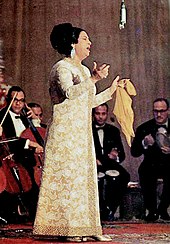
Arabic music, while independent and flourishing in the 2010s, has a long history of interaction with many other regional musical styles and genres. It is an amalgam of the music of the Arab people in the Arabian Peninsula and the music of all the peoples that make up the Arab world today.[473] Pre-Islamic Arab music was similar to that of Ancient Middle Eastern music. Most historians agree that there existed distinct forms of music in the Arabian peninsula in the pre-Islamic period between the 5th and 7th century CE. Arab poets of that "Jahili poets", meaning "the poets of the period of ignorance"—used to recite poems with a high notes.[474] It was believed that Jinns revealed poems to poets and music to musicians.[474] By the 11th century, Islamic Iberia had become a center for the manufacture of instruments. These goods spread gradually throughout France, influencing French troubadours, and eventually reaching the rest of Europe. The English words lute, rebec, and naker are derived from Arabic oud, rabab, and naqareh.[475][476]
A number of musical instruments used in classical music are believed to have been derived from Arabic musical instruments: the lute was derived from the Oud, the rebec (ancestor of violin) from the Maghreb rebab, the guitar from qitara, which in turn was derived from the Persian Tar, naker from naqareh, adufe from al-duff, alboka from al-buq, anafil from al-nafir, exabeba from al-shabbaba (flute), atabal (bass drum) from al-tabl, atambal from al-tinbal,[477] the balaban, the castanet from kasatan, sonajas de azófar from sunuj al-sufr, the conical bore wind instruments,[478] the xelami from the sulami or fistula (flute or musical pipe),[479] the shawm and dulzaina from the reed instruments zamr and al-zurna,[480] the gaita from the ghaita, rackett from iraqya or iraqiyya,[481] geige (violin) from ghichak,[482] and the theorbo from the tarab.[483]
During the 1950s and the 1960s, Arabic music began to take on a more Western tone – artists Umm Kulthum, Abdel Halim Hafez, and Shadia along with composers Mohamed Abd al-Wahab and Baligh Hamdi pioneered the use of western instruments in Egyptian music. By the 1970s several other singers had followed suit and a strand of Arabic pop was born. Arabic pop usually consists of Western styled songs with Arabic instruments and lyrics. Melodies are often a mix between Eastern and Western. Beginning in the mid-1980s, Lydia Canaan, musical pioneer widely regarded as the first rock star of the Middle East[484][485]
Spirituality
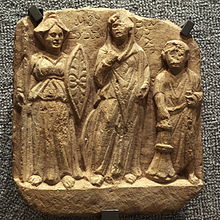
Arab polytheism was the dominant religion in pre-Islamic Arabia. Gods and goddesses, including Hubal and the goddesses al-Lāt, Al-'Uzzá and Manāt, were worshipped at local shrines, such as the Kaaba in Mecca, whilst Arabs in the south, in what is today's Yemen, worshipped various gods, some of which represented the Sun or Moon. Different theories have been proposed regarding the role of Allah in Meccan religion.[486][487][488] Many of the physical descriptions of the pre-Islamic gods are traced to idols, especially near the Kaaba, which is said to have contained up to 360 of them.[489] Until about the fourth century, almost all Arabs practised polytheistic religions.[490] Although significant Jewish and Christian minorities developed, polytheism remained the dominant belief system in pre-Islamic Arabia.[491]
The religious beliefs and practices of the nomadic bedouin were distinct from those of the settled tribes of towns such as Mecca.[492] Nomadic religious belief systems and practices are believed to have included fetishism, totemism and veneration of the dead but were connected principally with immediate concerns and problems and did not consider larger philosophical questions such as the afterlife.[492] Settled urban Arabs, on the other hand, are thought to have believed in a more complex pantheon of deities.[492] While the Meccans and the other settled inhabitants of the Hejaz worshipped their gods at permanent shrines in towns and oases, the bedouin practised their religion on the move.[493]
Most notable Arab gods and goddesses: 'Amm, A'ra, Abgal, Allah, Al-Lat, Al-Qaum, Almaqah, Anbay, ʿAṯtar, Basamum, Dhu l-Khalasa, Dushara, Haukim, Hubal, Isāf and Nā'ila, Manaf, Manāt, Nasr, Nuha, Quzah, Ruda, Sa'd, Shams, Samas, Syn, Suwa', Ta'lab, Theandrios, al-‘Uzzá, Wadd, Ya'uq, Yaghūth, Yatha, Aglibol, Astarte, Atargatis, Baalshamin, Bēl, Bes, Ēl, Ilāh, Inanna/Ishtar, Malakbel, Nabū, Nebo, Nergal, Yarhibol.
Philosophy
The philosophical thought in the Arab world is heavily influenced by Arabic Philosophy. Schools of Arabic/Islamic thought include Avicennism and Averroism. The first great Arab thinker in the Islamic tradition is widely regarded to be al-Kindi (801–873 A.D.), a Neo-Platonic philosopher, mathematician and scientist who lived in Kufa and Baghdad (modern day Iraq). After being appointed by the Abbasid Caliphs to translate Greek scientific and philosophical texts into Arabic, he wrote a number of original treatises of his own on a range of subjects, from metaphysics and ethics to mathematics and pharmacology.[494]
Much of his philosophical output focuses on theological subjects such as the nature of God, the soul and prophetic knowledge. Doctrines of the Arabic philosophers of the 9th–12th century who influenced medieval Scholasticism in Europe. The Arabic tradition combines Aristotelianism and Neoplatonism with other ideas introduced through Islam. Influential thinkers include the non-Arabs al-Farabi and Avicenna. The Arabic philosophic literature was translated into Hebrew and Latin, this contributed to the development of modern European philosophy. The Arabic tradition was developed by Moses Maimonides and Ibn Khaldun.[495][496]
Science

Arabic science underwent considerable development during the Middle Ages (8th to 13th centuries CE), a source of knowledge that later spread throughout Medieval Europe and greatly influenced both medical practice and education. The language of recorded science was Arabic. Scientific treatises were composed by thinkers originating from across the Muslim world. These accomplishments occurred after Muhammad united the Arab tribes and the spread of Islam beyond the Arabian peninsula.[497]
Within a century after Muhammed's death (632 CE), an empire ruled by Arabs was established. It encompassed a large part of the planet, stretching from southern Europe to North Africa to Central Asia and on to India. In 711 CE, Arab Muslims invaded southern Spain; al-Andalus was a center of Arabic scientific accomplishment. Soon after, Sicily too joined the greater Islamic world. Another center emerged in Baghdad from the Abbasids, who ruled part of the Islamic world during a historic period later characterized as the "Golden Age" (~750 to 1258 CE).[498]
This era can be identified as the years between 692 and 945,[499] and ended when the caliphate was marginalized by local Muslim rulers in Baghdad – its traditional seat of power. From 945 onward until the sacking of Baghdad by the Mongols in 1258, the Caliph continued on as a figurehead, with power devolving more to local subordinates.[500] The pious scholars of Islam, men and women collectively known as the ulama, were the most influential element of society in the fields of Sharia law, speculative thought and theology.[501] Arabic scientific achievement is not as yet fully understood, but is very large.[502] These achievements encompass a wide range of subject areas, especially mathematics, astronomy, and medicine.[502] Other subjects of scientific inquiry included physics, alchemy and chemistry, cosmology, ophthalmology, geography and cartography, sociology, and psychology.[503][504]

Al-Battani was an astronomer, astrologer and mathematician of the Islamic Golden Age. His work is considered instrumental in the development of science and astronomy. One of Al-Battani's best-known achievements in astronomy was the determination of the solar year as being 365 days, 5 hours, 46 minutes and 24 seconds which is only 2 minutes and 22 seconds off.[505] In mathematics, al-Battānī produced a number of trigonometrical relationships.[505] Al-Zahrawi, regarded by many as the greatest surgeon of the Middle Ages.[506] His surgical treatise "De chirurgia" is the first illustrated surgical guide ever written. It remained the primary source for surgical procedures and instruments in Europe for the next 500 years.[507] The book helped lay the foundation to establish surgery as a scientific discipline independent from medicine, earning al-Zahrawi his name as one of the founders of this field.[508]
Other notable Arabic contributions include among other things: the pioneering of organic chemistry by Jābir ibn Hayyān,[509] establishing the science of cryptology and cryptanalysis by al-Kindi,[510][511][512] the development of analytic geometry by Ibn al-Haytham,[513][514] who has been described as the "world's first true scientist",[515] the discovery of the pulmonary circulation by Ibn al-Nafis,[516][517] the discovery of the itch mite parasite by Ibn Zuhr,[518] the first use of irrational numbers as an algebraic objects by Abū Kāmil,[519] the first use of the positional decimal fractions by al-Uqlidisi,[520][521] the development of the Arabic numerals and an early algebraic symbolism in the Maghreb,[522][523] the Thabit number and Thābit theorem by Thābit ibn Qurra,[524] the discovery of several new trigonometric identities by Ibn Yunus and al-Battani,[525][526] the mathematical proof for Ceva's theorem by Ibn Hűd,[527] the first accurate lunar model by Ibn al-Shatir,[528] the invention of the torquetum by Jabir ibn Aflah,[529] the invention of the universal astrolabe and the equatorium by al-Zarqali,[530][531] the first description of the crankshaft by al-Jazari,[532] the anticipation of the inertia concept by Averroes,[533] the discovery of the physical reaction by Avempace,[534] the identification of more than 200 new plants by Ibn al-Baitar[535] the Arab Agricultural Revolution, and the Tabula Rogeriana, which was the most accurate world map in pre-modern times by al-Idrisi.[536]
The birth of the University institution can be traced to this development, as several universities and educational institutions of the Arab world such as the University of Al Quaraouiyine, Al Azhar University, and Al Zaytuna University are considered to be the oldest in the world. Founded by Fatima al Fihri in 859 as a mosque, the University of Al Quaraouiyine in Fez is the oldest existing, continually operating and the first degree awarding educational institution in the world according to UNESCO and Guinness World Records[537][538] and is sometimes referred to as the oldest university.[539]
There are many scientific Arabic loanwords in Western European languages, including English, mostly via Old French.[540] This includes traditional star names such as Aldebaran, scientific terms like alchemy (whence also chemistry), algebra, algorithm, alcohol, alkali, cipher, zenith, etc.
Under Ottoman rule, cultural life and science in the Arab world declined. In the 20th and 21st centuries, Arabs who have won important science prizes include Ahmed Zewail and Elias Corey (Nobel Prize), Michael DeBakey and Alim Benabid (Lasker Award), Omar M. Yaghi (Wolf Prize), Huda Zoghbi (Shaw Prize), Zaha Hadid (Pritzker Prize), and Michael Atiyah (both Fields Medal and Abel Prize). Rachid Yazami was one of the co-inventors of the lithium-ion battery,[541] and Tony Fadell was important in the development of the iPod and the iPhone.[542]
Theatre
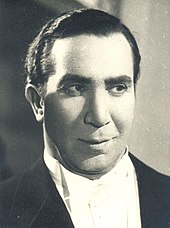
Arab theatre is a rich and diverse cultural form that encompasses a wide range of styles, genres, and historical influences. Its roots in the pre-Islamic era, when poetry, storytelling, and musical performances were the main forms of artistic expressionIt refers to theatrical performances that are created by Arab playwrights, actors, and directors. The roots of Arab theatre can be traced back to ancient Arabic poetry and storytelling, which often incorporated music and dance. In the early Arabic period, storytelling evolved into a more formalized art form that was performed in public gatherings and festivals.[543][544]
During the Islamic Golden Age in the 8th and 9th centuries, the city of Baghdad emerged as a hub of intellectual and artistic activity, including theatre. The court of the Abbasid Caliphate was home to many influential playwrights and performers, who helped to develop and popularize theatre throughout the Islamic world. Arab theatre has a long tradition of incorporating comedy and satire into its performances, often using humor to address social and political issues.[545]
Arab theatre encompasses a wide range of dramatic genres, including tragedy, melodrama, and historical plays. Many Arab playwrights have used drama to address contemporary issues, the role of women in Arab society, and the challenges facing young people in the modern world. In recent decades, many Arab theatre artists have pushed the boundaries of the form, experimenting with new styles and techniques. This has led to the emergence of a vibrant contemporary theatre scene in many Arab countries, with innovative productions and performances that challenge traditional notions of Arab identity and culture.[546]
Fashion
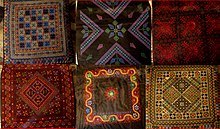
Arab fashion and design have a rich history and cultural significance that spans centuries, each with its unique fashion and design traditions. One of the most notable aspects of Arab fashion is the use of luxurious fabrics and intricate embroidery. Traditional garments, such as the Abaya and Thobe, are often made from high-quality fabrics like silk, satin, brocade, and are embellished with intricate embroidery and beading.[547] In recent years, Arab fashion has gained global recognition, with designers like Elie Saab, Zuhair Murad, and Reem Acra showcasing their designs on international runways.[548]
These designers incorporate traditional Arab design elements into their collections, such as ornate patterns, luxurious fabrics, and intricate embellishments. In addition to fashion, Arab design is also characterized by its intricate geometric patterns, calligraphy, and use of vibrant colors. Arabic art and architecture, with their intricate geometric patterns and motifs, have influenced Arab design for centuries.[549] Arab designers also incorporate traditional motifs, such as the paisley and the arabesque, into their work. Overall, Arab fashion elements are rooted in the rich cultural heritage of the Arab world and continue to inspire designers today.[550]
Wedding and marriage
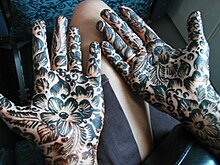
Arabic weddings have changed greatly in the past 100 years. Original traditional Arabic weddings are supposed to be very similar to modern-day Bedouin weddings and rural weddings, and they are in some cases unique from one region to another, even within the same country. The practice of marrying of relatives is a common feature of Arab culture.[551]
In the Arab world today between 40% and 50% of all marriages are consanguineous or between close family members, though these figures may vary among Arab nations.[552][553] In Egypt, around 40% of the population marry a cousin. A 1992 survey in Jordan found that 32% were married to a first cousin; a further 17.3% were married to more distant relatives.[554] 67% of marriages in Saudi Arabia are between close relatives as are 54% of all marriages in Kuwait, whereas 18% of all Lebanese were between blood relatives.[555] Due to the actions of Muhammad and the Rightly Guided Caliphs, marriage between cousins is explicitly allowed in Islam and the Quran itself does not discourage or forbid the practice.[556] Nevertheless, opinions vary on whether the phenomenon should be seen as exclusively based on Islamic practices as a 1992 study among Arabs in Jordan did not show significant differences between Christian Arabs or Muslim Arabs when comparing the occurrence of consanguinity.[555]
Genetics
Arabs are diverse genetically as a result of their intermarriage and mixing with indigenous people of the pre-Islamic Middle East and North Africa following the Islamic expansion.[557][558] Genetic ancestry components related to the Arabian Peninsula display an increasing frequency pattern from west to east over North Africa. A similar frequency pattern exist across northeastern Africa with decreasing genetic affinities to groups of the Arabian Peninsula along the Nile river valley across Sudan and South Sudan the more they go south.[559] This genetic cline of admixture is dated to the time of Arab expansion and immigration to the Maghreb and northeast Africa.[559] Genetic research has indicated that Palestinian Arabs and Jews share common genetic ancestry and are closely related.[560][561][562][563][564][565][566][567]
See also
References
Notes
- ^ Including 1–2 million native Arabs[12] and 3,763,565 registered Syrian refugees.[13]
- ^ singular: Arab; singular Arabic: عَرَبِيٌّ, DIN 31635 (Classical Arabic): ʿarabiyyun, Arabic pronunciation: [ʕɑ.rɑˈbɪj.jʊn]
- ^ Sources stating Arabs are an ethnic group:[56][57][58][59][60][61][62][63][64][65][66][67][68][69][70][71]
- Arabs share a strong bond through their ethnic, linguistic, and cultural heritage. This connection encompasses their history, nationalism, and geographic ties. Religion also influences it, contributing to its distinct customs, arts, cuisine, and societal identity.[72][73]
- Arab identity concentrating on ethnic identity is another way of defining Arab identity, which can be subdivided into linguistic, cultural, social, historical, political, national, or genealogical terms.
Citations
- ^ Lorenzo Kamel (31 March 2017). The Frailty of Authority: Borders, Non-State Actors and Power Vacuums in a Changing Middle East. Edizioni Nuova Cultura. p. 25. ISBN 978-88-6812-828-9.
- ^ Kail C. Ellis (12 January 2018). Secular Nationalism and Citizenship in Muslim Countries: Arab Christians in the Levant. Springer. p. 159. ISBN 978-3-319-71204-8.
- ^ Margaret K. Nydell (26 July 2018). Understanding Arabs: A Guide for Modern Times. John Murray Press. p. 11. ISBN 978-1-4736-9091-2.
- ^ Neil Caplan (4 September 2019). The Israel-Palestine Conflict: Contested Histories. John Wiley & Sons. p. 23. ISBN 978-1-119-52387-1.
- ^ Jump up to: Jump up to: a b total population 450 million; CIA Factbook2030 estimates an Arab population of 450 million, see article text.
- ^ Jump up to: Jump up to: a b "World Arabic Language Day | United Nations Educational, Scientific and Cultural Organization". Unesco.org. 15 December 2016. Retrieved 18 December 2017.
- ^ Jump up to: Jump up to: a b IBGE. IBGE | Biblioteca | Detalhes | Características étnico-raciais da população : classificações e identidades IBGE: Características Étnico-Raciais da População.
- ^ Silvia Ferabolli (25 September 2014). Arab Regionalism: A Post-Structural Perspective. Routledge. p. 151. ISBN 978-1-317-65803-0.
According to estimates by the Brazilian Institute of Geography and Statistics (IBGE), countersigned by the League of Arab States, Brazil has the largest Arab colony outside their countries of origin. There are estimated 15 million Arabs living in Brazil today, with some researchers suggesting numbers around 20 million.
- ^ Paul Amar (15 July 2014). The Middle East and Brazil: Perspectives on the New Global South. Indiana University Press. p. 40. ISBN 978-0-253-01496-2.
there are, according to the Ministry of Foreign Affairs, more than sixteen million Arabs and descendants of Arabs in Brazil, constituting the largest community of Arabs descent outside the Middle East.
- ^ Crumley, Bruce (24 March 2009), "Should France Count Its Minority Population?", Time, retrieved 11 October 2014
- ^ "To count or not to count". The Economist. 26 March 2009. ISSN 0013-0613. Retrieved 30 January 2019.
- ^ Jump up to: Jump up to: a b c d "Turkey's demographic challenge". www.aljazeera.com.
- ^ "UNHCR Situation Syria Regional Refugee Response – Turkey". Government of Turkey. 11 November 2021. Retrieved 17 November 2021.
- ^ Jump up to: Jump up to: a b c "Demographics". Arab American Institute. Archived from the original on 23 October 2016. Retrieved 18 December 2017.
- ^ Jump up to: Jump up to: a b "Inmigración sirio-libanesa en Argentina" (in Spanish). Fearab.org.ar. Archived from the original on 20 June 2010. Retrieved 13 April 2010.
- ^ "Colombia y Medio Oriente". 26 April 2022. Retrieved 2 July 2022.
- ^ "Brazil-Arab News Agency - Colombia awakens to the Arab world". 6 July 2011. Archived from the original on 6 July 2011. Retrieved 17 June 2022.
- ^ Tiempo, Casa Editorial El (7 March 2019). "Los palestinos que encontraron un segundo hogar en el centro de Bogotá". El Tiempo (in Spanish). Retrieved 18 June 2022.
- ^ "Estimación de la mortalidad, 1985-2005" [Estimation of mortality, 1985-2005] (PDF). Postcensal Studies (in Spanish). Bogotá, Colombia: DANE. March 2010. Archived from the original (PDF) on 23 November 2007. Retrieved 29 March 2016.
- ^ "Proyecciones nacionales y departamentales de población. 2006-2020" [National and departmental population projections. 2006-2020] (PDF) (in Spanish). DANE National Statistical Service, Colombia. September 2007. Archived from the original (PDF) on 23 November 2007. Retrieved 22 September 2015.
- ^ "Demographic characteristics - definitions and explanations (translation from Hebrerw into English)". Israel Central Bureau of Statistics. Retrieved 6 January 2024.
- ^ "Chad". The World Factbook (2024 ed.). Central Intelligence Agency. Retrieved 3 April 2019. (Archived 2019 edition.)
- ^ "Iran". The World Factbook (2024 ed.). Central Intelligence Agency. Retrieved 3 August 2013. (Archived 2013 edition.)
- ^ "Arabs". Minority Rights Group. 19 June 2015. Retrieved 26 October 2023.
- ^ Jump up to: Jump up to: a b Margolis, Mac (15 September 2013). "Abdel el-Zabayar: From Parliament to the Frontlines". The Daily Beast.
- ^ "Anzahl der Ausländer in Deutschland nach Herkunftsland in den Jahren 2015 und 2016". statista (in German).
- ^ "Los musulmanes en España superan los 1,8 millones". www.europapress.es (in Spanish). 30 March 2015. Retrieved 25 April 2017.
- ^ Redaction (9 October 2012). "La cifra de musulmanes en España alcanza los 1,6 millones, de los que casi un tercio viven en Cataluña". www.alertadigital.com (in Spanish). Archived from the original on 1 December 2017. Retrieved 25 April 2017.
- ^ Sierra, Mauricio (16 June 2021). "Arab Ancestry in Latin America". Berkeley High Jacket. Retrieved 15 February 2022.
Arab Mexicans are an important group within Mexican society. There are around 1,100,000 Mexican citizens of Arab descent, primarily of Lebanese, Syrian, Iraqi and Palestinian heritage.
- ^ "Aurora | Aurora". www.aurora-israel.co.il. Archived from the original on 18 March 2012.
- ^ Jump up to: Jump up to: a b "Chile: Palestinian refugees arrive to warm welcome". Adnkronos.com. 7 April 2003. Archived from the original on 19 September 2011. Retrieved 17 September 2011.
- ^ Jump up to: Jump up to: a b "500,000 descendientes de primera y segunda generación de palestinos en Chile". Laventana.casa.cult.cu. Archived from the original on 22 July 2009. Retrieved 17 September 2011.
- ^ «Канадский арабский институт :: 750 925 канадцев родом из арабских стран» . www.canadianarabinstitute.org . Архивировано из оригинала 19 марта 2017 года . Проверено 19 октября 2019 г.
- ^ «Иностранные граждане в Италии – 2021» . tuttoitalia.it .
- ^ «Население по стране рождения, возрасту и полу. 2000 – 2020 годы» . Проверено 19 сентября 2019 г.
- ^ Энтони Макрой. «Британский араб» . Национальная ассоциация британских арабов. Архивировано из оригинала 3 января 2015 года . Проверено 17 апреля 2012 г.
- ^ «australianarab.org/about-us» . Архивировано из оригинала 30 октября 2016 года.
- ↑ Перейти обратно: Перейти обратно: а б «Голландские СМИ воспринимаются как гораздо более предвзятые, чем арабские СМИ – Отчет о СМИ и гражданстве, проведенный Утрехтским университетом» (PDF) , Утрехтский университет , 10 сентября 2010 г., заархивировано из оригинала (PDF) 28 февраля 2019 г. , получено 29 ноября 2010 г.
- ^ «Кот-д'Ивуар» . Группа по правам меньшинств . 30 января 2018 г.
- ^ Х. Эспин-Окампо (2020). Происхождение и эволюция палестинской общины в Чили . Том 1. стр. 113–132. дои : 10.15359/ri.93-1.5 . ISSN 1018-0583 . S2CID 241082525 .
{{cite book}}:|work=игнорируется ( помогите ) - ^ 2020, 16 октября (16 октября 2020 г.). «Гуаякиль, принявший иностранных мигрантов» . Телеграф . Проверено 16 апреля 2022 г.
{{cite web}}: CS1 maint: числовые имена: список авторов ( ссылка ) - ^ «Африка | Арабы Нигера борются с изгнанием» . Новости Би-би-си . 25 октября 2006 г. Проверено 1 июня 2020 г.
- ^ «Демография и этнические группы Дании» . Мировой Атлас . 8 июля 2019 года . Проверено 27 октября 2023 г.
- ^ Хартоно, Суньярити (2015). Анализ и оценка законодательства, касающегося колониального наследия (Нидерланды и Япония) (PDF) . Джакарта: Национальное агентство правового развития, Министерство юстиции и прав человека Индонезии. стр. 25–26. IOS1-INLIS000000000683886.
- ^ «Почему в Сальвадоре живет так много палестинцев | AJ+» . newsvideo.su . Архивировано из оригинала 13 ноября 2019 года . Проверено 13 ноября 2019 г. .
- ^ «Географическое распространение ливанской диаспоры по всему миру» . Архивировано из оригинала 14 февраля 2021 года . Проверено 16 октября 2018 г.
- ^ Зилгер, Мэтью. «Сальвадор: Центральноамериканская Палестина Запада?» . Дейли Стар . Проверено 27 мая 2015 г.
- ^ «AJ Plus: Палестинцы Сальвадора» . Архивировано из оригинала 13 ноября 2019 года . Проверено 13 ноября 2019 г. .
- ^ Деллиос, Хью. «Голосование в Сальвадоре разделяет два арабских клана» . Чикаго Трибьюн .
- ^ «Языки Эритреи» . Этнолог . Проверено 21 октября 2023 г.
- ^ 2014, 25 июня (24 ноября 2017). «Более 10 миллионов ливанцев являются движущей силой социального и экономического роста Латинской Америки» . infobae (на европейском испанском языке) . Проверено 15 февраля 2022 г.
{{cite web}}: CS1 maint: числовые имена: список авторов ( ссылка ) - ^ «История и информация Танзании – Информация о сафари в Танзании» . www.eyesonafrica.net . Проверено 28 мая 2020 г.
- ^ «Перепись населения и жилищного фонда Кении, том IV, 2019 год: Распределение населения по социально-экономическим характеристикам» (PDF) . Национальное статистическое бюро Кении . Архивировано (PDF) из оригинала 9 октября 2022 г. Проверено 2 мая 2021 г.
- ^ «Сомали» , The World Factbook , Центральное разведывательное управление, 17 октября 2023 г. , дата обращения 22 октября 2023 г.
- ^ Мбарек, Хамди; Исмаил, Саид И. (7 декабря 2022 г.). «Картирование арабского генома» . Природная генетика . 54 (12): 1761–1763. дои : 10.1038/s41588-022-01239-0 . PMID 36446885 .
- ^ Макинтош-Смит, Тим (30 апреля 2019 г.). Арабы: 3000-летняя история народов, племен и империй . Издательство Йельского университета. ISBN 978-0-300-18235-4 .
- ^ Левинсон, Дэвид (1998). Этнические группы во всем мире: Готовый справочник . Орикс Пресс. ISBN 978-1-57356-019-1 .
- ^ Шакри, Омния Эль (20 октября 2020 г.). Понимание и преподавание современного Ближнего Востока . Университет Висконсина Pres. ISBN 978-0-299-32760-6 .
- ^ Ахрари, Мохаммед Э. (1994). Ближний Восток в переходный период: Учебное пособие . Южный центр международных исследований. ISBN 978-0-935082-19-7 .
- ^ Хитти, Филип К. (1996). Арабы: краткая история . Вашингтон, округ Колумбия: Паб Regnery. ISBN 0895267063 .
- ^ Роган, Юджин (2011). Арабы: история (1-е изд. ПБК). Нью-Йорк, штат Нью-Йорк: Основные книги. ISBN 978-0465025046 .
- ^ Хаусс, Чарльз (июль 2005 г.). Т.е. сравнительная политика . Уодсворт. ISBN 978-0-495-06294-3 .
- ^ Ф., Эйкельман, Дейл (сентябрь 2013 г.). «Арабы (антропология)». Энциклопедия ислама . Том. Три.
{{cite encyclopedia}}: CS1 maint: несколько имен: список авторов ( ссылка ) - ^ Шуп, Джон А. (31 октября 2011 г.). Этнические группы Африки и Ближнего Востока: Энциклопедия . АВС-КЛИО. ISBN 9781598843620 .
- ^ Баракат, Халим (1993). Арабское мировое общество, культура и государство . Беркли: Издательство Калифорнийского университета. ISBN 0520914422 .
- ^ Рейнольдс, Дуайт Ф. (2 апреля 2015 г.). Кембриджский спутник современной арабской культуры . Издательство Кембриджского университета. ISBN 9780521898072 .
- ^ Джандт, Фред Э. (2 февраля 2012 г.). Введение в межкультурную коммуникацию: идентичности в глобальном сообществе . Публикации SAGE. ISBN 9781412992879 .
- ^ Крайдер, Кайл Л.; Балдино, Томас Дж. (2016). Голосование меньшинства в США . Санта-Барбара: Прегер. ISBN 978-1440830242 .
- ^ Эпштейн, Стивен (2007). Потерянная чистота: переход границ в Восточном Средиземноморье, 10:00–1400 . Джу Пресс. ISBN 978-0-8018-8484-9 .
- ^ «АРАБ». Энциклопедия Ираника .
- ^ «Арабы» . MSN Энкарта . 28 октября 2009 г. Архивировано из оригинала 28 октября 2009 г.
- ^ *
- ^
- «Культура и традиции в арабских странах» . www.habiba.org .
- «Арабская культура и традиции – онлайн-ресурсы | Подход Пимслера™» . www.pimsleurapproach.com .
- Эль-Шами, Хасан М. (1995). Народные традиции арабского мира: руководство по классификации мотивов (1. [Др.]. Изд.). Блумингтон UA: Университет Индианы. Нажимать. ISBN 0253352223 .
- ^ Буреш, Ярослав (2008). Основная характеристика и тенденции развития миграции в арабском мире . Прага: Институт международных отношений. ISBN 978-80-86506-71-5 .
- ^ * «ИСТОРИЯ АРАБОВ» . www.historyworld.net . Проверено 1 мая 2023 г.
- Эфал, Израиль (1982). Древние арабы: кочевники плодородного полумесяца . Иерусалим Лейден: Магнес пресса Еврейского университета Э. Дж. Брилла. ISBN 978-965-223-400-1 .
- Макинтош-Смит, Тим (30 апреля 2019 г.). Арабы: 3000-летняя история народов, племен и империй . Издательство Йельского университета. ISBN 978-0-300-18235-4 .
- ^ * Майерс, Е.А. (11 февраля 2010 г.). Итурийцы и римский Ближний Восток: переоценка источников . Издательство Кембриджского университета. п. 18. ISBN 978-1-139-48481-7 .
- Хойланд, Роберт Г. (2001). Аравия и арабы . Рутледж. стр. 11 МЕТОДОЛОГИЯ (современная Саудовская Аравия за вычетом восточного побережья, пустынь Синай и Негев, а также частей современной Иордании, Сирии и Ирака). ISBN 0-203-76392-0 .
- ^ * Смит, Сильвия (21 мая 2013 г.). «Раскопки в Бахрейне раскрывают одну из древнейших цивилизаций» . Новости Би-би-си . Би-би-си .
- «Калъат-эль-Бахрейн – древняя гавань и столица Дилмуна» . ЮНЕСКО . Архивировано из оригинала 5 апреля 2012 года . Проверено 17 августа 2011 г.
- ^ * Боуман, Алан К.; Чамплин, Эдвард; Линтотт, Эндрю (8 февраля 1996 г.). Кембриджская древняя история . Издательство Кембриджского университета. ISBN 978-0-521-26430-3 .
- Ретсо, Ян (октябрь 2010 г.). «Арабы (исторические)» . Энциклопедия ислама, Три .
- «Происхождение слова «араб» » . Исмаилиты.нет . Проверено 18 декабря 2017 г.
- ^ Вернер Даум (1987). Йемен: 3000 лет искусства и цивилизации в Аравии Феликс . Пингвин-Верлаг. п. 73. ИСБН 3701622922 .
- ^ Фишер, Грег; Вуд, Филип (июль 2015 г.). Арабы и империи до ислама . Издательство Оксфордского университета. п. 368. ИСБН 9780191799730 . Проверено 3 августа 2023 г.
Ориген в третьем веке был первым христианином, который отождествил измаильтян с арабами, но сделал это лишь бегло.
- ^ «Тамуд | История, племя и местоположение | Британника» . www.britanica.com . Проверено 7 апреля 2023 г.
- ^ Уорик Болл (2002). Рим на Востоке: трансформация империи . Рутледж. п. 80. ИСБН 9781134823871 .
- ↑ Перейти обратно: Перейти обратно: а б Берндт Шаллер, Итурея , стр.1492.
- ^ де Йонг, Альберт (2013). «Хатра и Парфянское государство» . Восток и Запад – Группа 21 : 143–161.
- Эллерброк, Уве (2021). Парфяне: Забытая империя . Оксфорд: Рутледж. ISBN 978-0367481902 .
- ^ Жюльен, Кристель (22 марта 2018 г.), «Бет Арабае» , Оксфордский словарь поздней античности , Oxford University Press, doi : 10.1093/acref/9780198662778.001.0001 , ISBN 978-0-19-866277-8 , получено 20 апреля 2023 г.
- ↑ Перейти обратно: Перейти обратно: а б Жюльен, Кристель (2018). «Бет Арабае» . Николсон, Оливер (ред.). Оксфордский словарь поздней античности . Оксфорд: Издательство Оксфордского университета. ISBN 978-0-19-866277-8 .
- ^ Боуман, Алан; Гарнси, Питер; Кэмерон, Аверил (2005). Кембриджская древняя история: Том 12, Кризис империи, 193–337 гг . Издательство Кембриджского университета. ISBN 9780521301992 . ; Хорнблауэр, Саймон; Спофорт, Энтони; Эйдинов, Эстер (2012). Оксфордский классический словарь . ОУП Оксфорд. ISBN 9780199545568 . ; Бернс, Джаспер (2006). Великие женщины императорского Рима: матери и жены цезарей . Рутледж. ISBN 9781134131853 . ; Прадо, Леонардо де Аррисабалага и (2017). Varian Studies Volume One: Varius . Издательство Кембриджских ученых. ISBN 9781443893855 . ; Шахид, Ирфан (1984). Рим и арабы: Пролегомен к изучению Византии и арабов . Думбартон-Оукс. п. 37. ИСБН 0884021157 . ; Фрейзенбрух, Аннелиза (2011). Жены цезарей: секс, власть и политика в Римской империи . Саймон и Шустер. ISBN 9781416583059 .
- ^ * Бауэрсок, GW , Питер Браун и Олег Грабарь , ред. 1999. Поздняя античность: Путеводитель по постклассическому миру (2-е изд.). Кембридж, Массачусетс: Belknap Press . ISBN 978-0-674-51173-6 .
- Кэмерон, Аверил (29 апреля 2015 г.). Средиземноморский мир в поздней античности: 395–700 гг . н.э. Рутледж. ISBN 978-1-136-67305-4 .
- «Лахмиды». Энциклопедия Ираника . Проверено 18 декабря 2017 г.
- ^ * «Ислам, Арабская империя Омейядов» . сайт History-World.org . Архивировано из оригинала 15 декабря 2014 года . Проверено 21 января 2017 г.
- «Арабская империя | Мухаммед | История империи Омейядов» . Historybits.com . Проверено 18 декабря 2017 г.
- «10 величайших империй в истории» . Листверс . 22 июня 2010 г.
- Пиллаламарри, Ахилеш (22 февраля 2015 г.). «5 самых могущественных империй в истории» . Национальный интерес .
- «10 величайших империй в мировой истории» . Десять лучших списков . 24 марта 2010 г. Архивировано из оригинала 2 февраля 2017 г. . Проверено 24 января 2017 г.
- ^ * « Арабское восстание, 1916–1818 | Османская империя ». История Новой Зеландии . Министерство культуры и наследия . 30 июля 2014 г.
- Макмикин, Шон . 2012. Экспресс Берлин-Багдад . Белкнап Пресс . ISBN 0-674-06432-1 . стр. 288, 297.
- Роган, Юджин Л. (2004). Границы государства в поздней Османской империи: Трансиордания, 1850–1921 гг . Издательство Кембриджского университета. ISBN 978-0-521-89223-0 . OCLC 826413749 .
- Оксенвальд, Уильям Л. 1968. «Сирийский вилайет, 1901–1914: пересмотр дипломатических документов как источников». Ближневосточный журнал 22 (1). п. 73.* Создана Лига арабских государств | Этот день в истории — 22 марта 1945 года ». ИСТОРИЯ . США: A&E Television Networks . 2010. Проверено 28 апреля 2014 года.
- Макдональд, Роберт В. (8 декабря 2015 г.). Лига арабских государств: исследование динамики региональной организации . Издательство Принстонского университета. ISBN 978-1-4008-7528-3 .
- Лига арабских государств из Энциклопедии Колумбии, 6-е изд. , заархивировано из оригинала 13 мая 2019 г. [ ISBN отсутствует ]
- ^ * «Кто такой араб?» . al-bab.com .
- Фрэнсис М. Денг (1 октября 2011 г.). Война видений: конфликт идентичностей в Судане . Издательство Брукингского института. п. 405. ИСБН 978-0-8157-2369-1 .
- ^ Рабаса, Ангел; Ваксман, Мэтью; Ларсон, Эрик В.; Маркам, Шерил Ю. (17 ноября 2004 г.). Мусульманский мир после 11 сентября . Корпорация Рэнд. п. 31. ISBN 978-0-8330-3755-8 .
- ^ * «Культура и традиции в арабских странах» . Хабиба.орг . Проверено 18 декабря 2017 г.
- «Арабская культура и традиции» . Подход Пимслера . Проверено 18 декабря 2017 г. [ постоянная мертвая ссылка ]
- Эль-Шами, Хасан М. (1995). Народные традиции арабского мира: Руководство по классификации мотивов . Том. 2. Блумингтон, Индиана: Издательство Университета Индианы. ISBN 978-0-253-35222-4 .
- ^ * «Арабская цивилизация» . Alhewar.org . Архивировано из оригинала 24 октября 2017 года . Проверено 1 ноября 2017 г.
- Холт, ПМ 2013. Исследования по истории Ближнего Востока . п. 28. 113627331X: «Он занимал этот пост до своей смерти в 1624 году, и его сменил его бывший ученик Джеймс Голиус (1596–1667). Эрпениус и Голиус внесли выдающийся вклад в развитие арабистики своим преподаванием и подготовкой текстов. ,..."
- ^ * Портер Берки, Джонатан (2003). Формирование ислама: религия и общество на Ближнем Востоке, 600–1800 гг . Издательство Кембриджского университета . п. 42 . ISBN 978-0-521-58813-3 .
- Робинсон, Нил (2013). Ислам: краткое введение . Рутледж. ISBN 978-1-136-81773-1 .
- ^ «Арабы». Энциклопедия.com . 21 апреля 2018 года . Проверено 9 мая 2018 г.
- Фарес, Валид (2001). «Арабские христиане: Введение» . Арабское библейское служение.
- «Большинство и меньшинства в арабском мире: отсутствие объединяющего повествования» . Иерусалимский центр по связям с общественностью . * «Религиозное разнообразие во всем мире – Исследовательский центр Пью» . Проект «Религия и общественная жизнь» исследовательского центра Pew . 4 апреля 2014 г.
- ↑ Перейти обратно: Перейти обратно: а б Ретсо, январь (2003). Арабы в древности: их история от ассирийцев до Омейядов . Психология Пресс. ISBN 978-0-7007-1679-1 . стр. 105, 119, 125–27.
- ^ Вер, Ганс и Дж. М. Коуэн. Словарь современного письменного арабского языка (3-е изд.) Итака, Нью-Йорк: Службы разговорного языка. п. 601.
- ^ ABADY_Йемен_Археология_9_12 . стр. 127 , 128.
- ^ Боуден, Уильям; Лаван, Люк; Мачадо, Карлос (2004). Недавние исследования сельской местности поздней античности . Брилл. п. 91. ИСБН 978-90-04-13607-6 .
- ^ Ира М. Лапидус (2014). История исламских обществ . Издательство Кембриджского университета. п. 29. ISBN 978-0-521-51430-9 .
- ^ Саллес, Жан-Франсуа; Хили, Дж. Ф. (22 декабря 2015 г.). «Арабы». Оксфордская исследовательская энциклопедия классической литературы . дои : 10.1093/акр/9780199381135.013.644 . ISBN 978-0-19-938113-5 .
- ^ «Значение арабской земли в исторических источниках» . Архивировано из оригинала 15 марта 2010 года.
- ^ Грей, Луи Герберт (2006) Введение в семитскую сравнительную лингвистику
- ^ Кортни, Джеймс Джон (2009) Язык Палестины и прилегающих регионов
- ^ Киенаст, Буркхарт. (2001). Историческая семитская лингвистика
- ^ Бромили, Джеффри В. (1995) Международная стандартная библейская энциклопедия
- ^ Муртонен, А. (1967). Ранний семитский: диахроническое исследование связи эфиопского языка с другими так называемыми юго-восточными семитскими языками . Архив Брилла.
- ↑ Перейти обратно: Перейти обратно: а б Постгейт, Дж. Н. (2007). Языки Ирака, древние и современные . Британская школа археологии в Ираке. ISBN 978-0-903472-21-0 .
- ^ Джаллад, Ахмад (2018). «Самые ранние этапы арабского языка и его лингвистическая классификация» .
{{cite journal}}: Для цитирования журнала требуется|journal=( помощь ) - ^ Аарон Д. Рубин (2008). «Подгруппа семитских языков» . Язык и лингвистический компас . 2 (1): 61–84. дои : 10.1111/j.1749-818x.2007.00044.x .
- ^ Джаллад, Ахмад (2018). «Самые ранние этапы арабского языка и его лингвистическая классификация» . В Элаббасе Бенмамуне; Рим Бассиуни (ред.). Справочник Рутледжа по арабской лингвистике . Лондон: Рутледж.
- ^ Кухня, А.; Эрет, К.; Ассефа, С.; Маллиган, CJ (29 апреля 2009 г.). «Байесовский филогенетический анализ семитских языков выявил происхождение семитских языков на Ближнем Востоке в раннем бронзовом веке» . Труды Королевского общества B: Биологические науки . 276 (1668): 2703–2710. дои : 10.1098/rspb.2009.0408 . ПМЦ 2839953 . ПМИД 19403539 .
- ^ Сабатино Москати (январь 2001 г.). Финикийцы . ИБ Таурис. п. 654. ISBN 978-1-85043-533-4 .
- ^ Джонс, Линдси (2005). Энциклопедия религии . Справочник Macmillan США. ISBN 978-0-02-865740-0 .
- ^ Фредрик Э. Гриншпан (2005). «Измаил». В Линдси Джонс (ред.). Энциклопедия религии . Том. 7. Справочник Macmillan США. стр. 4551–4552. ISBN 9780028657400 .
ИШМАИЛ, или, по-еврейски, Ишмаэль; старший сын Авраама. Матерью Измаила была Агарь, египетская рабыня, которую Сара взяла в качестве служанки и в конечном итоге подарила Аврааму, потому что эта царская чета была престарелой и бездетной, но они тогда не знали о Божьем плане и Израиле; в соответствии с месопотамским законом потомство от такого союза будет зачислено Сарре (Быт. 16:2). Имя Йишмаэль известно из различных древних семитских культур и означает «Бог услышал», что позволяет предположить, что ребенок, названный так, считался ответом на просьбу. Измаил был обрезан Авраамом в тринадцатилетнем возрасте и изгнан вместе со своей матерью Агарью по наущению Сарры, жены Авраама, которая хотела гарантировать, что Исаак станет наследником Авраама (Быт. 21). В Новом Завете Павел использует этот случай, чтобы символизировать отношения между иудаизмом и христианством (Гал. 4:21–31). В книге Бытия Бог благословил Измаила, пообещав, что он станет основателем великого народа и «диким ослом», всегда враждующим с другими (Быт. 16:12). И Авраам встал утром, взял хлеб и мех воды, положил ей на плечо, родил мальчика и отпустил ее. И пошла она и странствовала по пустыне Берсаби. [15] И когда вода в бутыли закончилась, она бросила мальчика под одно из деревьев, которые были там. Бытие, глава 21: [16] И пошла она, и села против него на большом расстоянии, насколько может унести лук, ибо она сказала: не хочу, чтобы мальчик умирал; и, сев против него, она подняла ее голос и заплакала. [17] И услышал Бог голос мальчика, и ангел Божий воззвал к Агарю с неба, говоря: что ты делаешь, Агар? Не бойтесь, ибо услышал Бог голос отрока с того места, где он. [18] Встань, возьми отрока и возьми его за руку, ибо Я произведу от него великий народ. [19] И открыл Бог глаза ей, и увидела она колодезь с водой, и пошла, и наполнила мех, и дала пить мальчику. [20] И Бог был с ним, и он вырос, и поселился в пустыне, и стал юношей, стрелком из лука. (21) И жил он в пустыне Фаран, и мать его взяла ему жену из земли Египетской. [22] В то же время Авимелех и Фихол, военачальник его, сказали Аврааму: Бог с тобою во всем, что ты делаешь. [23] Итак поклянись Богом, что ты не причинишь зла ни мне, ни потомству моему, ни потомству моему; но по доброте, которую я сделал тебе, сделай мне и земле, на которой ты жил, незнакомец. [24] И сказал Авраам: я клянусь. (25) И упрекнул Авимелеха за колодезь с водой, который слуги его силой отобрали. (26) И ответил Авимелех: я не знал, кто это сделал, и ты не сказал мне, и я не слышал об этом до сегодняшнего дня. (27) И взял Авраам овец и волов, и отдал их Авимелеху, и заключили они оба союз. [28] И отделил Авраам семь овец из стада. [29] И сказал ему Авимелех: что значат эти семь овец, которых ты отделил? [30] Но он сказал: возьми семь овец из рук моих, чтобы они были мне свидетельством, что я выкопал этот колодец. [31] Поэтому место то и было названо Берсаби, потому что там они оба клялись. (32) И заключили союз к клятвенному колодцу. (33) И встал Авимелех и Фихол, военачальник войска его, и возвратились в землю Палестинскую. Но Авраам насадил рощу в Берсаби и призвал там имя Господа Бога Вечного. [34] И пробыл он в земле Палестинской много дней. [Бытие 21:1-34] Библия Дуэ Реймса. Ему приписывают двенадцать сыновей, описанных как «князья по коленам своим» (Быт. 25:16), представляющие, возможно, древнюю конфедерацию. Его потомками, по-видимому, считались измаильтяне, бродячие торговцы, близкие к мадианитянам. Тот факт, что жена и мать Измаила, как говорят, были египтянками, предполагает тесные связи между измаильтянами и Египтом. Согласно Бытию 25:17, Измаил дожил до 137 лет. Исламская традиция склонна приписывать Измаилу большую роль, чем Библия. Он считается пророком и, по мнению некоторых богословов, потомком, которого Аврааму было приказано принести в жертву (хотя сура Иудаизм обычно считала его нечестивцем, хотя ему также приписывают покаяние. Согласно некоторым раввинским традициям, двумя его женами были Аиша и Фатима, чьи имена совпадают с именами жены и дочери Мухаммеда. И иудаизм, и ислам считают его предком арабских народов. Библиография Обзор патриархальных повествований Библии можно найти в книге Наума М. Сарны «Понимание Бытия» (Нью-Йорк, США). 1966). Постбиблейские традиции со ссылкой на христианские и исламские взгляды собраны в исчерпывающем издании Луи Гинзберга «Легенды евреев», 2-е изд., 2 тома, в переводе Генриетты Сольд и Пола Радина (Филадельфия, 2003). (1987 и 2005 годы)
- Ногель, Скотт Б.; Уилер, Брэннон М. (апрель 2010 г.). Пророки от А до Я в исламе и иудаизме . Пугало Пресс. ISBN 9781461718956 .
- «Измаил и Исаак» . www.therefinersfire.org .
- ^ А-Я пророков в исламе и иудаизме , Уиллер, Измаил
- ^ Саджади, Садек (2015) [2008]. «Авраам». В Маделунге, Уилферд; Дафтари, Фархад (ред.). Исламская энциклопедия . Том. 1. Перевод Негабана, Фарзина. Лейден и Бостон : Издательство Brill . дои : 10.1163/1875-9831_isla_COM_0028 . ISBN 978-90-04-16860-2 . ISSN 1875-9823 .
- ^ Сиддики, Мона . «Ибрагим – мусульманский взгляд на Ибрагима» . Религии . Би-би-си . Проверено 3 февраля 2013 г.
- ^ Что касается Измаила, я прислушался к вам. Настоящим я благословляю его. Я сделаю его плодородным и чрезвычайно многочисленным. Он будет отцом двенадцати вождей, и Я произведу от него великий народ. 17:21
- ^ Бытие 17:20
- ^ «Бытие 17:20 – Завет обрезания» . Библейский хаб . Проверено 1 мая 2023 г.
- ^ «12. Испытание Божьих обещаний (Бытие 21) | Bible.org» . библия.орг . Проверено 1 мая 2023 г.
- ^ Бытие 17:20 , Версия короля Иакова.
- ^ «Бытие, глава 17 – Откройте для себя книги Библии» . Проверено 1 мая 2023 г.
- ^ Стейси, Аиша. [2013] 2020. « Признаки пророчества в благородной жизни Пророка Мухаммеда (часть 1 из 2): Ранняя жизнь Пророка Мухаммеда ». Религия Ислам . Проверено 18 декабря 2017 г. § 18, с. 215.
- Гибб, Гамильтон А.Р. и Дж.Х. Крамерс . 1965. Краткая энциклопедия ислама . Итака, Нью-Йорк: Издательство Корнельского университета . стр. 191–98
- Маалуф, Тони. Арабы в тени Израиля: развитие Божьего пророческого плана для линии Измаила . Крегель академик. ISBN 978-0-8254-9363-8 .
- Урбен, Оливье (2008). Музыка и трансформация конфликтов: гармонии и диссонансы в геополитике . ИБТаурис. ISBN 978-1-84511-528-9 .
- ^ «Levity.com, Ислам» . Levity.com . Проверено 13 апреля 2010 г.
- ^ Коран 6:86
- ^ Коран 14:37
- ^ Гастер, Моисей (1927). «Восьмой» . Асатир: самаритянская книга Моисея . Лондон: Королевское азиатское общество. OCLC 540827714 .
- ^ Гастер, Моисей (1927). Асатир [микроформа] самаритянской книги «Тайны Моисея» . Интернет-архив. Лондон: Королевское азиатское общество.
- ^ Иосиф Флавий, Тит Флавий (1683). «гл. 12: Измаила, сына Авраама, и потомства арабов». . Древности евреев (на древнегреческом языке). Том. Книга 1: От сотворения до смерти Исаака. OCLC 70357552 .
- ^ Иосиф Флавий, «Книга I» , «Иудейские древности» , получено 2 мая 2023 г.
- ^ Онкелос . «Раздел V. Чайей Сара» . Таргум Онкелос (на арамейском языке).
{{cite book}}:|website=игнорируется ( помогите ) - ^ «JCR — Comp. JPS, Таргумс Онкелос, Палестина, Иерусалим — Бытие 25» . сайт juchre.org . Проверено 2 мая 2023 г.
- ^ «ИСТОРИЯ АРАБОВ» . www.historyworld.net . Проверено 1 мая 2023 г.
- ^ Ноубл, Джон Трэвис. 2013. «Пусть Измаил живёт перед тобой!» Поиск места Сыну Агари в священнической традиции. Докторская диссертация, Гарвардский университет.
- ^ Деличше (1912). Ассирийские ткани для чтения . Лейпциг. ОКЛК 2008786 .
{{cite book}}: CS1 maint: отсутствует местоположение издателя ( ссылка ) - ^ Монтгомери (1934). Аравия и Библия . Филадельфия: Университет Пенсильвании. OCLC 639516 .
- ^ Виннет (1970). Древние записи из Северной Аравии . Университет Торонто Пресс. стр. 51, 52. ISBN. 978-0-8020-5219-3 . OCLC 79767 .
царь Кедара (кедариты) в ассирийских надписях попеременно назван царем измаильтян и царем арабов.
- ^ Стеткевич (2000). Мухаммед и Золотая ветвь . Издательство Университета Индианы. ISBN 978-0-253-33208-0 .
Ассирийские записи документируют измаильтян как кедаритов и арабов.
- ^ Гамильтон, Виктор П. (1990). Книга Бытия ([Начдр.] ред.). Гранд-Рапидс, Мичиган: Уильям Б. Эрдманс. ISBN 978-0-8028-2309-0 .
- ^ «Арабы Северной Аравии в более поздние доисламские времена: Кедар, Невайот и другие» . Исследовательский исследователь Манчестерского университета . Проверено 29 мая 2023 г.
- ^ Зариньш, Юрис. «Археологический фонд» . Археологический фонд . Архивировано из оригинала 1 августа 2022 года . Проверено 30 ноября 2021 г.
- ^ М. Редха Бхакер и Бернадетт Бхакер. «Раскопки в земле Магана» . Археологический институт Америки .
- ^ Девер, WG (2006), Кем были первые израильтяне и откуда они пришли? , Издательство Уильяма Б. Эрдманс , с. 34, ISBN 978-0-8028-4416-3
- ^ «Бытие 25: 1–2» . Библейский шлюз . Версия короля Якова.
- ^ Первая энциклопедия ислама Э. Дж. Брилла 1913-1936 гг . Том. 1. Брилл . 1987. с. 121. ИСБН 90-04-08265-4 .
- ^ Ф. Буль, «Ад», в Энциклопедии ислама , изд. Пола Бирмана и других, 2-е изд., 12 томов (Лейден: Брилл, 1960–2005), дои : 10.1163/1573-3912_islam_SIM_0290 , ISBN 9789004161214 .
- ^ Первая энциклопедия ислама Э. Дж. Брилла 1913-1936 гг . Том. 8. Брилл. 1987. с. 1074. ИСБН 90-04-08265-4 .
- ^ «Иосиф: Иудейские древности, Книга XV» . penelope.uchicago.edu . Проверено 30 апреля 2023 г.
- ^ «КАК СПРАВИТЬСЯ С ОППОЗИЦИЕЙ» . abidanshah.com . 23 февраля 2013 года . Проверено 30 апреля 2023 г.
- ^ «ГЕШЕМ АРАБСКИЙ — JewishEncyclepedia.com» . www.jewishencyclepedia.com . Проверено 1 мая 2023 г.
- ^ «Гешем, Гашму | Энциклопедия.com» . www.энциклопедия.com . Проверено 1 мая 2023 г.
- ^ Ретсо, январь (2003). Арабы в древности: их история от ассирийцев до Омейядов . Лондон: RoutledgeCurzon. ISBN 978-1-315-02953-5 . OCLC 857081715 .
- ^ «Очевидец истории» . Сайт Eyewitnesstohistory.com . Архивировано из оригинала 2 апреля 2010 года . Проверено 13 апреля 2010 г.
- ^ «Ибн Халдун и миф об «арабском нашествии» » . Версо . Проверено 1 мая 2023 г.
- ^ «ИСТОРИЯ АРАБОВ» . www.historyworld.net . Проверено 1 мая 2023 г.
- ^ «гл. 83: О царе измаильтянах » . Кебра Нагаст (в Боже).
{{cite book}}:|website=игнорируется ( помогите ) - ^ «таблетка» . Британский музей .
- ^ Транскрипция: «CDLI-Архивный просмотр» . cdli.ucla.edu .
- ↑ Перейти обратно: Перейти обратно: а б Йеспер Эйдема, Флемминг Хойлундб (1993). «Торговля или дипломатия? Ассирия и Дильмун в восемнадцатом веке до нашей эры». Мировая археология . 24 (3): 441–448. дои : 10.1080/00438243.1993.9980218 .
- ^ Райс, Майкл (1991). Становление Египта: Истоки Древнего Египта 5000–2000 гг . до н.э. Рутледж. п. 230. ИСБН 9781134492633 .
{{cite book}}:|work=игнорируется ( помогите ) - ^ «Раскопки в Бахрейне раскрывают одну из древнейших цивилизаций» . Новости Би-би-си . 21 мая 2013 г. Архивировано из оригинала 13 ноября 2014 г. . Проверено 11 декабря 2014 г.
- ^ «Калъат-эль-Бахрейн – древняя гавань и столица Дилмуна» . ЮНЕСКО . Архивировано из оригинала 5 апреля 2012 года . Проверено 17 августа 2011 г.
- ^ Кесслер, П.Л. «Королевства арабов — Кедар/кедариты» . Файлы истории . Проверено 31 марта 2023 г.
- ^ «Достопримечательности древнего царства Саба, Мариб» . Центр всемирного наследия ЮНЕСКО . Проверено 23 марта 2023 г.
- ↑ Перейти обратно: Перейти обратно: а б Коран 27:6-93
- ↑ Перейти обратно: Перейти обратно: а б Коран 34:15-18
- ↑ Перейти обратно: Перейти обратно: а б «Британский музей – Королевства древней Южной Аравии» . 4 мая 2015 года. Архивировано из оригинала 4 мая 2015 года . Проверено 25 марта 2023 г.
- ^ «Саба | История, царство и сабеи | Британника» . www.britanica.com . Проверено 25 марта 2023 г.
- ^ Финкельштейн, Израиль; Зильберман, Нил Ашер, Дэвид и Соломон: В поисках библейских священных царей и корней западной традиции , с. 171
- ^ Уилер, Брэннон (18 июня 2002 г.). Пророки в Коране: Введение в Коран и мусульманская экзегеза . А&С Черный. ISBN 978-0-8264-4956-6 .
- ^ Уилер, Брэннон М. (2002). Пророки в Коране: Введение в Коран и мусульманская экзегеза . Международная издательская группа «Континуум». п. 166. ИСБН 0-8264-4956-5 – через Google Книги .
- ^ Коран 44:37
- ^ Коран 50:12-14.
- ^ Заиди, Асгар (24 октября 2017 г.), «Концептуализация благополучия пожилых людей» , Благополучие пожилых людей в стареющих обществах , Routledge, стр. 33–53, doi : 10.4324/9781315234182-2 , ISBN 9781315234182 , получено 25 марта 2023 г.
- ^ Кеннет А. Китчен. Серия «Мир «Древней Аравии» . Документация по Древней Аравии. Часть I. Хронологические рамки и исторические источники стр.110
- ↑ Перейти обратно: Перейти обратно: а б «Лихян - ДРЕВНЕЕ ЦАРСТВО, АРАВИЯ» . Британника . Проверено 7 марта 2017 г.
- ^ «Львиные гробницы Дедана» . www.saudiarabiatourismguide.com . Проверено 31 марта 2023 г.
- ^ Натанель бен Исайя (1983). Сефер Меор ха-Афела (на иврите). Перевод Йосефа Кафиха . Кирьят Оно: Мехон Моше. п. 119. OCLC 970925649 .
- ^ Росси, Ирен (2014). «Минейцы за Маином» . Материалы семинара по арабистике . 44 : 111–123. ISSN 0308-8421 . JSTOR 43782855 .
- ^ Веймар, Джейсон (ноябрь 2021 г.). «Минейцы после Маина? Последний датируемый минойский текст и Бог Маина» . Арабская археология и эпиграфика . 32 (С1): 376–387. дои : 10.1111/aae.12176 . ISSN 0905-7196 . S2CID 233780447 .
- ^ «Маин | История, минейцы и храм | Британника» . www.britanica.com . Проверено 23 марта 2023 г.
- ↑ Перейти обратно: Перейти обратно: а б с д и Ван Бик 1997 .
- ↑ Перейти обратно: Перейти обратно: а б с д Брайс 2009 , с. 578.
- ↑ Перейти обратно: Перейти обратно: а б с Кухня 2001 , с. 123.
- ^ Хойланд 2002 , с. 48.
- ^ Шьеткетатте 2017 .
- ^ Хойланд 2002 , с. 46.
- ^ Хойланд 2002 , с. 42.
- ^ Хойланд 2002 , с. 47.
- ^ Седов Александр Владимирович; Батайи, Ахмад (1994). «Храмы Древнего Хадрамаута» . Материалы семинара по арабистике . 24 : 183–196. ISSN 0308-8421 . JSTOR 41223417 .
- ^ «Хадрамаут | Йемен, история и факты | Британника» . www.britanica.com . Проверено 26 марта 2023 г.
- ^ «Аравийский полуостров, 1–500 гг. н.э. | Хронология | Хайльбрунн Хронология истории искусств | Метрополитен-музей» . Хронология истории искусств Метрополитен-Хайльбрунна . Проверено 26 марта 2023 г.
- ^ «Хадрамаут | Энциклопедия.com» . www.энциклопедия.com . Проверено 26 марта 2023 г.
- ^ «История Аравии | Люди, география и империя | Британника» . www.britanica.com . Проверено 7 июня 2023 г.
- ↑ Перейти обратно: Перейти обратно: а б Плейфэр, полковник (1867). «О химьяритских надписях, недавно привезенных в Англию из Южной Аравии». Труды Лондонского этнологического общества . 5 : 174–177. дои : 10.2307/3014224 . JSTOR 3014224 .
- ^ Энциклопедия народов Африки и Ближнего Востока . Издательство информационной базы. 2009. ISBN 9781438126760 .
- ^ * Ирод в Британской энциклопедии : «Ирод родился на юге Палестины. Его отец, Антипатр, был идумеянином (семитским народом, который некоторые ученые идентифицируют как арабов, принявшим иудаизм во 2 веке до нашей эры). Антипатр был человеком. большого влияния и богатства, которые увеличились оба благодаря женитьбе на дочери дворянина из Петры (на юго-западе Иордании), в то время столицы растущего арабского Набатейского царства. Таким образом, Ирод был арабского происхождения, хотя и был практикующим евреем. "
- Пероун, Стюарт Генри (25 июня 2015 г.). «Ирод – царь Иудеи» . Британская энциклопедия . Архивировано из оригинала 25 июня 2015 года . Проверено 22 ноября 2020 г.
{{cite web}}: CS1 maint: неподходящий URL ( ссылка )
- Пероун, Стюарт Генри (25 июня 2015 г.). «Ирод – царь Иудеи» . Британская энциклопедия . Архивировано из оригинала 25 июня 2015 года . Проверено 22 ноября 2020 г.
- ^ «Ирод | Биография и факты» . Британская энциклопедия . 10 августа 2023 г.
- ^ Катервуд, Кристофер (2011). Краткая история Ближнего Востока . Литтл, Группа Брауновой книги. ISBN 9781849018074 .
- ^ Брайс 2014 , с. 278 .
- ^ Брайс 2014 , с. 359 .
- ^ Дэвид Ф. Граф (2003). «Арабы в Сирии: демография и эпиграфия» . Топои. Восток-Запад . 4 (1). Топои. Восток-Запад. Приложение: 319–340.
- ^ Ирфан Шахид (1984). Рим и арабы: Пролегомен к изучению Византии и арабов (изд. В твердом переплете). Думбартон-Оукс. п. 5. ISBN 978-0884021155 .
- ^ Марк А. Ченси (2002). Миф о язычнике Галилее (серия монографий Общества изучения Нового Завета) (изд. в твердом переплете). Издательство Кембриджского университета. п. 44. ИСБН 0-521-81487-1 .
- ^ Зулейка Роджерс; Маргарет Дейли-Дентон; Энн Фицпатрик-МакКинли (2009). Странствующий галилеянин: Очерки в честь Шона Фрейна (Приложения к журналу по изучению иудаизма) (изд. В твердом переплете). Брилл. п. 207. ИСБН 978-90-04-17355-2 .
- ^ Стив Мейсон, Жизнь Иосифа Флавия, Брилл, 2007, стр.54, №306.
- ^ Болл, Уорик (2001), Рим на Востоке: трансформация империи, Routledge, ISBN 0-415-11376-8 стр. 98-102
- ^ Боуман, Алан; Гарнси, Питер; Кэмерон, Аверил (2005). Кембриджская древняя история: Том 12, Кризис империи, 193–337 гг . Издательство Кембриджского университета. ISBN 9780521301992 .
- ^ «Осроэн | Ближний Восток, Сирия, Армения | Британника» . www.britanica.com .
- ^ Скольник, Фред; Беренбаум, Майкл (2007). Энциклопедия иудаизма Справочник Macmillan США. ISBN 9780028659435 .
- ^ «Арабы» в Энциклопедии Ираника
Однако слава Эдессы в истории основана главным образом на ее утверждениях о том, что она была первым королевством, принявшим христианство в качестве своей официальной религии. Согласно легенде, веками ходившей по всему цивилизованному миру, Абгар Уккама написал Иисусу, приглашая его навестить его в Эдессе, чтобы исцелить от болезни. Взамен он получил благословение Иисуса и впоследствии был обращен евангелистом Аддаем. Однако фактических свидетельств существования христианства в Эдессе до правления Авгаря Великого, 150 лет спустя, нет. Ученые в целом согласны с тем, что легенда спутала двух Абгаров. Невозможно доказать, что Авгарь Великий принял христианство; но его друг Вардаисан был инославным христианином, и в 201 году в Эдессе была церковь. О личности Авгаря Великого свидетельствует то, что традиция приписывает ему ведущую роль в евангелизации Эдессы.
- ^ Кольцо, Стивен. «История сирийских текстов и сирийского христианства – Таблица 1» . www.syriac.talktalk.net . Архивировано из оригинала 27 февраля 2018 года . Проверено 26 февраля 2018 г.
- ^ де Йонг, Альберт (2013). «Хатра и Парфянское государство» . Восток и Запад – Группа 21 : 143–161.
- ^ Якут , Географический словарь , ii. 263; Пейн-Смит, Тезаурус Сирийский , под «Хадьябом»; Хоффманн, Выдержки из сирийских файлов , стр. 241, 243.
- ^ Киа 2016 , с. 54.
- ^ Бруннер (1983b) , с. 750.
- ^ Рэпп (2014) , с. 28.
- ^ Боуман, Алан; Гарнси, Питер; Кэмерон, Аверил (2005). Кембриджская древняя история: Том 12, Кризис империи, 193–337 гг . Издательство Кембриджского университета. ISBN 9780521301992 . ; Хорнблауэр, Саймон; Спофорт, Энтони; Эйдинов, Эстер (2012). Оксфордский классический словарь . ОУП Оксфорд. ISBN 9780199545568 . ; Бал 2000 ; Бернс, Джаспер (2006). Великие женщины императорского Рима: матери и жены цезарей . Рутледж. ISBN 9781134131853 . ; Прадо, Леонардо де Аррисабалага и (2017). Varian Studies Volume One: Varius . Издательство Кембриджских ученых. ISBN 9781443893855 . ; Бирли 2002 ; Шахид, Ирфан (1984). Рим и арабы: Пролегомен к изучению Византии и арабов . Думбартон-Оукс. п. 37. ИСБН 0884021157 . ; Фрейзенбрух, Аннелиза (2011). Жены цезарей: секс, власть и политика в Римской империи . Саймон и Шустер. ISBN 9781416583059 .
- ^ «Дионисий Перигет» . Картографические изображения.net . Архивировано из оригинала 14 сентября 2018 года . Проверено 18 декабря 2017 г.
- ^ Гарольд Бейли Кембриджская история Ирана: Селевкидский, парфянский и сасанидский периоды , Том 1, Cambridge University Press, 1983, ISBN 0-521-20092-X с. 59
- ^ Гани, Мохаммад Хафиз. Абу Бакр: Возлюбленный моего возлюбленного . Мохаммад Хафиз Гани. ISBN 9798411225921 . Архивировано из оригинала 17 января 2023 года . Проверено 9 марта 2022 г.
- ^ Баркер, Джон В. (1 апреля 1996 г.). «Византия и арабы в пятом веке» . Журнал Американского восточного общества . 116 (2): 304–306. дои : 10.2307/605736 . JSTOR 605736 . Архивировано из оригинала 2 ноября 2023 года.
- ↑ Перейти обратно: Перейти обратно: а б Веннер, Манфред В. (1980). «Арабское/мусульманское присутствие в средневековой Центральной Европе» . Международный журнал исследований Ближнего Востока . 12 (1): 59–79. дои : 10.1017/S0020743800027136 . ISSN 0020-7438 . JSTOR 163627 . S2CID 162537404 .
- ↑ Перейти обратно: Перейти обратно: а б «Золотой век арабской культуры» . unesdoc.unesco.org . Проверено 26 марта 2023 г.
- ^ Коллинз Раннее Средневековье, Европа, стр. 142–143, 150, 160.
- ↑ Перейти обратно: Перейти обратно: а б Канлифф Европа между океанами, стр. 421–423.
- ^ Браун «Трансформация римского Средиземноморья» Оксфордская иллюстрированная история средневековой Европы с. 15
- ↑ Коллинз Раннее Средневековье, Европа, стр. 376–377.
- ↑ Перейти обратно: Перейти обратно: а б с CTR Хевер; Аллан Андерсон (2006). Понимание ислама: первые десять шагов (иллюстрированное издание). ООО «Гимны древние и современные» с. 37. ИСБН 9780334040323 .
- ^ Триана, Мэри (2017). Управление разнообразием в организациях: глобальная перспектива . Тейлор и Фрэнсис. п. 159. ИСБН 9781317423683 .
- ^ Азюмарди Азра (2006). Индонезия, ислам и демократия: динамика в глобальном контексте . Издательство Equinox (Лондон) . п. 9. ISBN 9789799988812 .
- ↑ Перейти обратно: Перейти обратно: а б Лунде, Пол (2002). Ислам . Нью-Йорк: Издательство Дорлинг Киндерсли. стр. 50–52. ISBN 978-0-7894-8797-1 .
- ^ Джон Джозеф Сондерс, История средневекового ислама , Routledge, 1965, стр. 13.
- ^ Клиффорд Эдмунд Босворт Исторические города исламского мира , Брилл, Лейд, 2007, ISBN 90-04-15388-8 стр. 264
- ^ Вартан Грегорян, «Ислам: мозаика, а не монолит», Brookings Institution Press, 2003, стр. 26–38. ISBN 0-8157-3283-X
- ^ Краткая шиитская энциклопедия, Автор: Хасан аль-Амин, «Династия Фатимидов в Египте» . Архивировано из оригинала 16 июня 2010 года . Проверено 5 октября 2010 г.
- ^ Зейн Н. Зейн (1973) Возникновение арабского национализма (3-е изд.). Дельмар, Нью-Йорк: Caravan Books Inc. ISBN 0882060007 . стр. 60–61, 83–92.
- ^ Шуэйри, стр. 166–168.
- ^ Уильям Истерли, Бремя белого человека , (2006) стр. 295
- ^ Джереми Уилсон (1989) Лоуренс Аравийский: Официальная биография Т. Э. Лоуренса . Уильям Хайнеманн. ISBN 978-0-434-87235-0 . п. 548
- ^ Микаберидзе, Александр (2011). Конфликт и завоевания в исламском мире: Историческая энциклопедия, Том 1 . АВС-КЛИО. стр. 799–802. ISBN 978-1598843361 .
- ^ Салиба, Джордж (1994). История арабской астрономии: планетарные теории в золотой век ислама . Издательство Нью-Йоркского университета . стр. 245, 250, 256–257. ISBN 0-8147-8023-7 .
- ^ Кинг, Дэвид А. (1983). «Астрономия мамлюков». Исида . 74 (4): 531–55. дои : 10.1086/353360 . S2CID 144315162 .
- ^ Хасан, Ахмад Ю. (1996). «Факторы упадка исламской науки после шестнадцатого века» . В Шарифе Шифе Аль-Аттасе (ред.). Ислам и вызов современности, Материалы первого симпозиума «Ислам и вызов современности: исторический и современный контекст», Куала-Лумпур, 1–5 августа 1994 г. Международный институт исламской мысли и цивилизации (ISTAC). стр. 351–99. Архивировано из оригинала 2 апреля 2015 года.
- ^ Исламский радикализм и мультикультурная политика . Тейлор и Фрэнсис . 1 марта 2011 г. с. 9. ISBN 978-1-136-95960-8 . Проверено 26 августа 2012 г.
- ^ «Университетские библиотеки | Университет Айовы» . Проверено 25 апреля 2023 г.
- ^ Аль-Тамими, Айменн Джавад (13 мая 2022 г.). «Текст XIII века рассказывает нам об арабах и европейцах» . Журнал «Новые линии» . Проверено 26 марта 2023 г.
- ^ «Биология — Арабский мир и европейское средневековье | Британника» . www.britanica.com . Проверено 26 марта 2023 г.
- ^ Веннер, Манфред В. (август 1980 г.). «Арабское/мусульманское присутствие в средневековой Центральной Европе» . Международный журнал исследований Ближнего Востока . 12 (1): 59–79. дои : 10.1017/S0020743800027136 . ISSN 1471-6380 . S2CID 162537404 .
- ^ Дионисий А. Агиус; Ричард Хичкок, ред. (1996). Арабское влияние в средневековой Европе (1-е изд. ПБК). Ридинг, Великобритания: Итака Пресс. ISBN 0-86372-213-Х . OCLC 38255663 .
- ^ Али, Самер М. (2010). Арабские литературные салоны в исламском средневековье: поэзия, публичные выступления и представление прошлого . Нотр-Дам, Индиана: Издательство Университета Нотр-Дам. ISBN 978-0-268-07465-4 . OCLC 794925469 .
- ^ Perry, Marvin; Jacob, Margaret; Jacob, James; Chase, Myrna; Laue, Theodore Von (29 October 2008). Western Civilization: Ideas, Politics, and Society, Comprehensive Edition. Cengage Learning. ISBN 978-0-547-14701-7.
- ^ Carney, R (6 June 2021). "Timurid Architecture and the Timurid Renaissance". Architecture of Cities. Retrieved 29 May 2023.
- ^ Stephen Sheehi, Foundations of Modern Arab Identity. Gainesville: University Press of Florida, 2004 [1]
- ^ Adnan A. Musallam, Arab Press, Society and Politics at the End of The Ottoman Era Archived 19 July 2011 at the Wayback Machine
- ^ Pacini, Andrea (1998). Christian Communities in the Arab Middle East: The Challenge of the Future. Clarendon Press. pp. 38, 55. ISBN 978-0-19-829388-0. Archived from the original on 10 March 2021. Retrieved 21 October 2016.
- ^ "Ottoman Empire – The decline of the Ottoman Empire, 1566–1807". Encyclopedia Britannica. Retrieved 7 July 2021.
- ^ "Geography of the Modern Middle East and North Africa | Middle East Teaching Tools". Archived from the original on 9 July 2021. Retrieved 7 July 2021.
- ^ Teitelbaum, Joshua (1998). "Sharif Husayn ibn Ali and the Hashemite Vision of the Post-Ottoman Order: From Chieftaincy to Suzerainty". Middle Eastern Studies. 34 (1): 103–122. doi:10.1080/00263209808701212. ISSN 0026-3206. JSTOR 4283920.
- ^ Hans Wehr. Dictionary of Modern Written Arabic (4th ed.). p. 1195.
- ^ "Requiem for Arab Nationalism" by Adeed Dawisha, Middle East Quarterly, Winter 2003
- ^ Charles Smith, The Arab-Israeli Conflict, in International Relations in the Middle East by Louise Fawcett, p. 220.
- ^ Sela, 151
- ^ "The Rise and Fall of Pan-Arabism | IHEID". www.graduateinstitute.ch. Retrieved 27 March 2023.
- ^ "Egypt, Syria Union Aim at Arab Unity". The San Francisco Examiner. Associated Press. 2 February 1958.
- ^ "Arab Unity." The Continuum Political Encyclopedia of the Middle East. Ed. Avraham Sela. New York: Continuum, 2002. pp. 160–166.
- ^ Aghrout, A. & Sutton, K. (1990). Regional Economic Union in the Maghrib. The Journal of Modern African Studies, 28(1), 115
- ^ "Africa Research Bulletin". Blackwell. 7 August 1973 – via Google Books.
- ^ "The Arab-Israeli conflict is fading". The Economist. 19 September 2020.
- ^ "Uprisings in the region and ignored indicators". Payvand. Archived from the original on 25 April 2013. Retrieved 31 March 2023.
- ^ Ori Stendel (1996). The Arabs in Israel. Sussex Academic Press. p. 45. ISBN 978-1-898723-24-0. Retrieved 4 March 2014.
- ^ Khalil, Mohammad Hassan (31 January 2013). Between Heaven and Hell: Islam, Salvation, and the Fate of Others. Oxford University Press. p. 297. ISBN 978-0-19-994541-2. Retrieved 1 March 2014.
- ^ Parolin, Gianluca Paolo (2009). Citizenship in the Arab World: Kin, Religion and Nation-state. Amsterdam University Press. ISBN 978-90-8964-045-1.
- ^ Phillips, Christopher (2013). Everyday Arab identity : the daily reproduction of the Arab world. Abingdon, Oxon: Routledge. ISBN 978-0-203-09674-1. OCLC 1058434843.
- ^ Jump up to: Jump up to: a b Webb, Peter (2016). Imagining the Arabs : Arab identity and the rise of Islam. Edinburgh, UK. ISBN 978-1-4744-0827-1. OCLC 964933606.
{{cite book}}: CS1 maint: location missing publisher (link) - ^ Carmichael, Joel (2016). The shaping of the Arabs : a study in ethnic identity. London. ISBN 978-1-000-11333-4. OCLC 1198893560.
{{cite book}}: CS1 maint: location missing publisher (link) - ^ "ص204 - كتاب الأعلام للزركلي - يعلى بن أمية - المكتبة الشاملة الحديثة". maktaba.org. 2 October 2021. Archived from the original on 2 October 2021. Retrieved 21 August 2022.
- ^ * Hourani, Albert (2010). A history of the Arab peoples (1st Harvard Press paperback ed.). Cambridge, Mass.: Belknap Press of Harvard University Press. ISBN 978-0-674-05819-4.
- "HISTORY OF MIGRATION". Historyworld.net. Retrieved 18 December 2017.
- Power, Bethany G. "The Emergence and Expansion of Islam to 1500." Education 613: MTEL Guide. University of Massachusetts. Archived from the original on 3 September 2016.
- "History of the Arabs (book)". Historyworld.net. Retrieved 18 December 2017.
- ^ Hugh Kennedy The Armies of the Caliphs: Military and Society in the Early Islamic State p.33 Routledge, 17 June 2013 ISBN 1-134-53113-3
- ^ Daniel, E. L. "Arab settlements in Iran". Encyclopædia Iranica. Archived from the original on 29 April 2011. Retrieved 9 April 2011.
- ^ Clio. "François Decret, Les invasions hilaliennes en Ifrîqiya – Clio – Voyage Culturel". www.clio.fr. Retrieved 28 September 2015.
- ^ Al Andulsi, Ibn Abd Rabuh (939). Al Aqid Al Fareed.
- ^ Аль-Ктами, Хмуд (1985). К северу от Хиджаза . Джидда: Дар Аль Баян. п. 235.
- ↑ Перейти обратно: Перейти обратно: а б Али, Джавад (2001). «Подробный отчет об истории арабов до ислама» . Цифровая библиотека Аль-Мадины . Дар Аль Саки. Архивировано из оригинала 4 марта 2016 года . Проверено 11 сентября 2020 г.
- ^ Аль Зибеди, Муртати (1965). Тадж Аль Ароос и Джевел Аль Камус
- ^ Аль Хашими, Мухаммед ибн Хабиб ибн Омая ибн Амир (859). Аль Махбар . Бейрут: Дар Аль Афаак.
- ^ Труди Ринг, Ноэль Уотсон, Пол Шеллингер. 1995. Международный словарь исторических мест. Том. 3 Южная Европа. Рутледж. стр.190.
- ^ М. Че. Хоутсма, изд. (1993). «Кинана». Первая энциклопедия ислама Э. Дж. Брилла, 1913–1936, том 4 . Брилл. стр. 1017–1018. ISBN 9789004097902 .
- ^ «Конец арабизма в знании генеалогии арабов • Официальный сайт Комплексной библиотеки » . 26 февраля 2018 г. Архивировано из оригинала 26 февраля 2018 г. Проверено 21 августа 2022 г.
- ^ «Энциклопедия истории арабского Магриба — Абд аль-Фаттах Миклад Гунайми, Абд аль-Фаттах Мукаллид аль-Гунайми — Google Books » . 3 сентября 2019 года. Архивировано из оригинала 26 августа 2022 года . Проверено 21 августа 2022 г.
- ^ «Энциклопедия иракских племен — Тамир Абд аль-Хасан Амири — Google Книги » . 17 декабря 2019 года. Архивировано из оригинала 26 августа 2022 года . Проверено 21 августа 2022 г.
- ^ «Страница 204 — Китаб аль-А’лам Аль-Зиракли — Йа’ла бин Умайя — Современная комплексная библиотека » . 2 октября 2021 г. Архивировано из оригинала 2 октября 2021 г. Проверено 21 августа 2022 г.
- ^ «Обширная энциклопедия — Ожерелья Джумана в представлении о племенах арабов времени » . Архивировано из оригинала 24 марта 2018 года . Проверено 21 августа 2022 г.
- ^ Fück, JW (24 апреля 2012 г.), «G̲h̲aṭafān» , Энциклопедия ислама, второе издание , Брилл, заархивировано из оригинала 14 марта 2022 г. , получено 21 августа 2022 г.
- ^ Иракские кланы - Аббас аль-Аззави
- ^ Внутрирегиональная трудовая мобильность в арабском мире. Архивировано 7 мая 2016 года в Wayback Machine , Международная организация по миграции (МОМ), Каир.
- ^ «Ливанцы в Западной Африке: Вдали от дома» . Экономист . 20 мая 2011 г.
- ^ «Упорство и риск – ливанцы в Западной Африке» . Новости Би-би-си . 10 января 2010 г.
- ^ «Профиль Занзибара» . Новости Би-би-си . 18 июля 2012 г.
- ^ « Успешные диаспоры мира ». Managementtoday.co.uk. 3 апреля 2007 г.
- ^ «Французско-арабская битва стереотипов - новости развлечений, французское кино, СМИ» . Разнообразие . 29 января 2008 г. Архивировано из оригинала 21 февраля 2010 г. Проверено 22 августа 2010 г.
- ^ Этнические меньшинства Франции: считать или не считать . Экономист (26 марта 2009 г.). Проверено 12 июля 2013 г.
- ^ «Иностранные граждане 2020 – Сицилия» . Tuttitalia.it (на итальянском языке) . Проверено 9 сентября 2021 г.
- ^ «Сколько мусульман в Испании?» . Исламтодей.com Архивировано из оригинала 9 июня. 4 декабря 2013 г. Получено 18 декабря.
- ^ Медина, Мигель Анхель. «Мусульмане составляют 3,6% населения Испании (1,7 миллиона человек)» . Блоги.elpais.com . Проверено 18 декабря 2017 г.
- ^ «Мусульман в Испании превышает 1,8 миллиона человек» . Europapress.es . 30 марта 2015 г. Проверено 18 декабря 2017 г.
- ^ «Число мусульман в Испании достигает 1,6 миллиона, из которых почти треть проживает в Каталонии» . DigitalAlert.com . 9 октября 2012 года. Архивировано из оригинала 1 декабря 2017 года . Проверено 18 декабря 2017 г.
- ^ «испанская недвижимость» . Villa.spain-property-costa-blanca.com . Архивировано из оригинала 29 ноября 2017 года . Проверено 18 декабря 2017 г.
- ^ «Арабское влияние на испанский язык и культуру | Дон Кихот» . ДонКихот .
- ^ «BBC – Религии – Ислам: Мусульманская Испания (711–1492)» . Би-би-си .
- ^ «Количество иностранцев в Германии по странам происхождения в 2015 и 2016 годах» . статистика (на немецком языке).
- ^ «Арабская Кристен в Германии» . Архивировано из оригинала 30 декабря 2013 года . Проверено 27 сентября 2014 г.
- ^ «ОТЧЕТ О ПЕРЕПИСИ 2011 ГОДА – МАЙ 2013 ГОДА – Арабы и население Лиги арабских государств в Великобритании» . Национальная ассоциация британских арабов. Архивировано из оригинала 8 октября 2014 года . Проверено 9 апреля 2015 г.
- ^ «Британские арабы» . Наба.org.uk. Архивировано из оригинала 3 января 2015 года . Проверено 18 декабря 2017 г.
- ^ «Количество беженцев и мигрантов в Греции в среду достигло 54 574 человек» . Катимерини . 19 мая 2016 года . Проверено 19 мая 2016 г.
- ^ Ханнес Книффка (июнь 1995 г.). Элементы культурно-контрастной лингвистики . П. Ланг. п. 244. ИСБН 978-0-8204-2927-4 .
- ^ Внутрирегиональная мобильность рабочей силы в арабском мире, факты и цифры (PDF) , Международная организация по миграции, 2010 г., заархивировано из оригинала (PDF) 7 мая 2016 г. , получено 21 июля 2010 г.
- ^ «Турция – арабы» . Countrystudies.us .
- ^ «Влияние сирийских беженцев на Турцию» . www.washingtoninstitute.org .
- ^ Кайяли, Ранда (2006). Американцы арабского происхождения . Гринвуд Пресс. п. 26.
- ^ Кайяли, Ранда (2006). Американцы арабского происхождения . Гринвуд Пресс. п. 27.
- ^ Кайяли, Ранда (2006). Американцы арабского происхождения . Гринвуд Пресс. п. 35.
- ^ Орфалея, Грегори (2006). Американцы арабского происхождения: история . Пресса Олив Бранч. п. 189 .
- ^ «Основные показатели арабского населения Америки» (PDF) . Архивировано из оригинала (PDF) 23 июля 2011 года . Проверено 7 июля 2011 г. Арабско-американское население: основные моменты Фонд Арабско-Американского института
- ^ де ла Крус, Г. Патрисия; Анджела Бриттингем (декабрь 2003 г.). «Арабское население: 2000 г.» (PDF) . Бюро переписи населения США . Архивировано (PDF) из оригинала 9 октября 2022 года . Проверено 17 октября 2016 г.
- ^ «Сайт переписи населения США» . Бюро статистики США . Проверено 18 марта 2015 г.
- ^ «Арабское сообщество в Канаде» . Statcan.gc.ca . Проверено 18 декабря 2017 г.
- ^ "Дом" . Канадцы арабского происхождения – кто они? . 12 марта 2015 г.
- ^ «За пределами БВСА: девять городов, которые арабская диаспора называет своим домом» . Аль Баваба . 8 мая 2015 г.
- ^ «Арабские корни глубоко укоренились в богатом плавильном котле Бразилии» . Вашингтон Таймс . Проверено 17 апреля 2016 г.
- ^ «Происхождение и назначение левантийских иммигрантов» . ИБГЕ . Проверено 11 апреля 2016 г.
- ↑ Перейти обратно: Перейти обратно: а б «Ливанская Республика» . Itamaraty.gov.br . Архивировано из оригинала 23 сентября 2015 года . Проверено 18 декабря 2017 г.
- ^ «Ливан: География» . Посольство Ливана в Бразилии (на португальском языке). 1996. Архивировано из оригинала 29 мая 2008 года.
- ^ «Арабы Бразилии» . Саудовская Арамко Мир . Проверено 17 сентября 2011 г.
- ^ «Слейман встречается с бразильским коллегой и ливанским сообществом» . Дейли Стар . 23 апреля 2010 г.
- ^ «Ливан: География» [Ливан: География] (на португальском языке). Посольство Ливана в Бразилии. 1996. Архивировано из оригинала 12 ноября 2010 года.
- ^ «Эстадан-де-Хойе» . Estadao.com.br. Архивировано из оригинала 1 января 2013 года . Проверено 17 сентября 2011 г.
- ^ «Сириос, турки и ливанцы» [сирийцы, турки и ливанцы] (на испанском языке). oni.escuelas.edu.ar. Архивировано из оригинала 11 декабря 2008 года.
- ^ «Картирование мирового мусульманского населения: отчет о размере и распределении мусульманского населения в мире» (PDF) . Исследовательский центр Пью. Октябрь 2009. с. 24. Архивировано из оригинала (PDF) 19 июня 2018 года . Проверено 4 ноября 2016 г.
- ^ Баррос, Каролина (23 августа 2012 г.). «Сирийцы Аргентины» . www.buenosairesherald.com . Проверено 4 ноября 2016 г.
- ^ «Колумбия и Ближний Восток» . Diario La República (на испанском языке). 26 апреля 2022 г. Проверено 12 июля 2022 г.
- ^ «Бразильско-арабское агентство новостей - Колумбия пробуждается к арабскому миру» . 6 июля 2011 года. Архивировано из оригинала 6 июля 2011 года . Проверено 19 июня 2022 г.
- ^ «Палестинцы, нашедшие второй дом в центре Боготы» . Эль Тьемпо (на испанском языке). 7 марта 2019 года . Проверено 19 июня 2022 г.
- ^ Хабиб Саллум, «Арабы, оставляющие свой след в Латинской Америке: поколения иммигрантов в Колумбии, Венесуэле и Мексике» , Аль-Джадид , Том. 6, нет. 30 (зима 2000 г.).
- ^ Сьерра, Маурисио (16 июня 2021 г.). «Арабское происхождение в Латинской Америке» . Высокая куртка Беркли . Проверено 15 февраля 2022 г.
Мексиканцы арабского происхождения являются важной группой в мексиканском обществе. В Мексике проживает около 1 100 000 граждан арабского происхождения.
- ^ «Залакетт ставит Чили в качестве модели палестинско-еврейского сосуществования» . Нация . Архивировано из оригинала 8 марта 2016 года.
- ^ Арабские и еврейские иммигранты в Латинской Америке : образы и реалии, Игнасио Клих, Джефф Лессер, 1998, стр. 165.
- ^ Неми, Энид (14 сентября 1969 г.). «В обществе Сантьяго никого не волнует, зовут ли вас Кэри или де Ирарразаваль» . Нью-Йорк Таймс .
- ^ «Арабы Гондураса» . Saudiaramcoworld.com. 27 июня 1936 года . Проверено 17 сентября 2011 г.
- ^ «Краткая история Гаити как места назначения для групп, ищущих убежища» . Гаитянские Таймс . 19 мая 2022 г.
- ^ «От Ливана до Гаити: история, возвращающаяся в XIX век» . Проверено 30 января 2014 г.
- ^ Генко, А. Арабский язык и кавказоведение . Изд. АН СССР. Москва-Ленинград. 8–109
- ↑ Перейти обратно: Перейти обратно: а б Зелкина, Анна. Арабский язык как язык меньшинства . Уолтер де Грюйтер, 2000 г.; ISBN 3-11-016578-3 с. 101
- ^ Бэйнс, Томас Спенсер (ред.). «Закавказье». Британская энциклопедия. 1888. с. 514
- ^ Golestan-i Iram by Abbasgulu Bakikhanov . Translated by Ziya Bunyadov . Baku: 1991, p. 21
- ^ Seferbekov, Ruslan. Characters Персонажи традиционных религиозных представлений азербайджанцев Табасарана. Archived 16 December 2008 at the Wayback Machine
- ^ Стивен Адольф Вурм и др. Атлас языков межкультурного общения . Уолтер де Грюйтер, 1996 г.; п. 966
- ^ История Ибн Халдуна
- ^ Арабский как язык меньшинства Джонатан Оуэнс, стр. 184
- ^ Джаявардена, Дулип (13 марта 2018 г.). «Коммунальное насилие и политическая нестабильность в Шри-Ланке» . Ежедневное зеркало . Проверено 20 мая 2020 г.
- ^ Люди Индии: Том. XIII: Андхра-Прадеш (набор из 3 частей) под редакцией Д.Л. Прасада Рао, НВК Рао и С. Ясина Сахеба, Affiliated East-West Press
- ^ Люди Индии: Том XXII: Гуджарат (набор из 3 частей): под редакцией Р.Б. Лала, PBSV Падманабхама, Гопала Кришана и доктора медицины. Азиз Мохидден, Популярный Пракашан для ASI, 2003 г.
- ^ Мусульманское общество в переходный период Джавед, Арифа Кулсум ISBN 81-7169-096-3
- ^ Границы встроенных мусульманских общин в Индии / редактор Винод К. Джайрат ISBN 978-0-415-66888-0
- ^ «А2: Численность населения по этническим группам по районам, 2012 г.» . Перепись населения и жилищного фонда, 2011 г. Департамент переписи и статистики Шри-Ланки. Архивировано из оригинала 28 апреля 2017 года . Проверено 19 декабря 2016 г.
- ^ «Раса в Шри-Ланке. О чем нам говорят генетические данные» . Проверено 20 июля 2014 г.
- ^ де Мунк, Виктор (2005). «Исламское православие и суфизм в Шри-Ланке». Антропос . 100 (2): 401–414 [403]. дои : 10.5771/0257-9774-2005-2-401 . JSTOR 40466546 .
- ^ Махруф, МММ (1995). «Разговорные тамильские диалекты мусульман Шри-Ланки: язык как классификатор идентичности». Исламские исследования . 34 (4): 407–426 [408]. JSTOR 20836916 .
- ^ Шахаб, Алви (21 января 1996 г.). «Арабское сообщество в Пекоджане и Крукуте: от большинства к меньшинству» (на индонезийском языке). Архивировано из оригинала 9 августа 2008 года . Проверено 19 апреля 2015 г.
- ↑ Перейти обратно: Перейти обратно: а б Крибб и Кахин 2004 , стр. 18–19.
- ^ Ромеро, Патрисия В. (1997). Ламу . Маркус Винер. стр. 7. ISBN 978-1-55876-106-3 . Проверено 25 ноября 2014 г.
- ^ Сорбо, Гуннар М; Ахмед, Абдель Гаффар Мухаммад (2013). Разделенный Судан: продолжающийся конфликт в оспариваемом государстве . Пэлгрейв Макмиллан. п. 90. ИСБН 978-1-137-33824-2 . Проверено 25 ноября 2014 г.
- ^ «Берег Слоновой Кости – Левантийское сообщество» . Countrystudies.us . Проверено 17 сентября 2011 г.
- ↑ Ливанские иммигранты стимулируют торговлю в Западной Африке , Наоми Шварц, voanews.com, 10 июля 2007 г.
- ↑ В Нигерии застрелен ливанец , BBC News
- ^ «Саммит Африканского союза» . Архивировано из оригинала 7 марта 2012 года.
- ^ Рэндалл, Колин (19 ноября 2004 г.). «На ночных жителей Запада охотились за то, что они белые» . «Дейли телеграф» . Лондон. Архивировано из оригинала 10 января 2022 года . Проверено 26 июня 2009 г.
- ^ Хэндлофф, Роберт Э., изд. (1988). «Левантийское сообщество» . Кот-д'Ивуар: страновое исследование . Страноведение. Вашингтон, округ Колумбия: Генеральный офис Библиотеки Конгресса .
- ^ «Арабы Нигера будут бороться с изгнанием» . Новости Би-би-си . 25 октября 2006 г. Проверено 18 декабря 2017 г.
- ^ «Центральноафриканская Республика» , The World Factbook , Центральное разведывательное управление, 22 марта 2023 г. , получено 28 марта 2023 г.
- ↑ Перейти обратно: Перейти обратно: а б См., например:
- Стендель, Ори (1996). Арабы в Израиле . Сассекс Академик Пресс. п. 45. ИСБН 978-1-898723-24-0 . Проверено 4 марта 2014 г.
- Мохаммад Хасан Халил (31 января 2013 г.). Между раем и адом: ислам, спасение и судьба других . Издательство Оксфордского университета. п. 297. ИСБН 978-0-19-994541-2 . Проверено 1 марта 2014 г.
- ^ «Христиане (в арабском мире)» . Медея.be. Архивировано из оригинала 11 июня 2010 года . Проверено 13 апреля 2010 г.
- ^ Всемирный центр бахаи: координатор глобального сообщества , Международное сообщество бахаи, заархивировано из оригинала 29 июня 2007 г. , получено 2 июля 2007 г.
- ^ « Шишакли и друзы: интеграция и непримиримость »
- ^ «Хубал — то же самое, что Аллах?» . Исламское сознание.org. Архивировано из оригинала 25 марта 2010 года . Проверено 13 апреля 2010 г.
- ^ Словарь древних божеств . Издательство Оксфордского университета. 2001. ISBN 978-0-19-514504-5 .
- ^ «От Мариба, столицы Савеев, до Карантании» . Баззл.com. Архивировано из оригинала 16 марта 2009 года . Проверено 13 апреля 2010 г.
- ^ Запись в MSN Encarta о химьяритах . Архивировано из оригинала 4 июля 2004 года . Проверено 10 апреля 2009 г.
- ^ «История ислама» . Мнсу.edu. 6 января 2009 года. Архивировано из оригинала 31 мая 2010 года . Проверено 13 апреля 2010 г.
- ^ «Энциклопедия политики и религии» . Cqpress.com. Архивировано из оригинала 28 апреля 2010 года . Проверено 13 апреля 2010 г.
- ^ Бинер, Лайонел. «Мусульмане-шииты на Ближнем Востоке» . Cfr.org. Архивировано из оригинала 11 апреля 2010 года . Проверено 13 апреля 2010 г.
- ^ К. Хелд, Кольбер (2008). Модели Ближнего Востока: места, люди и политика . Рутледж. п. 109. ИСБН 9780429962004 .
Во всем мире их насчитывается около миллиона человек, из них от 45 до 50 процентов в Сирии, от 35 до 40 процентов в Ливане и менее 10 процентов в Израиле. В последнее время растет диаспора друзов.
- ^ Камаль С. Салиби (2003). Дом многих особняков: пересмотренная история Ливана (иллюстрировано, переиздание, исправленное издание). ИБТаурис. п. 88. ИСБН 978-1-86064-912-7 .
- ^ Андреа Пачини, изд. (1998). Христианские общины на Ближнем Востоке . Издательство Оксфордского университета. ISBN 978-0-19-829388-0 .
- ^ «Ливан» . Всемирная книга фактов (изд. 2024 г.). Центральное разведывательное управление .
- ^ «Сирия» . Всемирная книга фактов (изд. 2024 г.). Центральное разведывательное управление .
- ^ «Сектор Газа» . Всемирная книга фактов (изд. 2024 г.). Центральное разведывательное управление .
- ^ «Западный берег» . Всемирная книга фактов (изд. 2024 г.). Центральное разведывательное управление .
- ^ Арабские христиане - Кто они? Архивировано 6 декабря 2010 года в Wayback Machine . Arabbible.com. Проверено 3 января 2011 г.
- ^ «Израиль» . Всемирная книга фактов (изд. 2024 г.). Центральное разведывательное управление . Проверено 18 июля 2011 г. (Архивное издание 2011 г.)
- ^ «Иордания» . Всемирная книга фактов (изд. 2024 г.). Центральное разведывательное управление . Проверено 18 июля 2011 г. (Архивное издание 2011 г.)
- ^ «Арабско-американский институт | Американцы арабского происхождения» . Aaiusa.org. Архивировано из оригинала 3 апреля 2010 года . Проверено 10 марта 2010 г.
- ^ Мгалоблишвили, Тамила (1998). Древнее христианство на Кавказе . Рутледж. п. 272. ИСБН 978-0-7007-0633-4 .
- ^ Беренс-Абусейф, Дорис (1 января 1999 г.). Красота в арабской культуре . Издательство Маркуса Винера. ISBN 978-1558761995 . OCLC 40043536 .
- ^ «Аль-Джаллад. Самые ранние этапы арабского языка и его лингвистическая классификация (Справочник Рутледжа по арабской лингвистике, готовится к печати)» . Академия.edu . Проверено 27 октября 2016 г.
- ↑ Перейти обратно: Перейти обратно: а б "Управляющее резюме" . Будущее мирового мусульманского населения . Исследовательский центр Пью. 27 января 2011 года . Проверено 22 декабря 2011 г.
- ^ «Таблица: Мусульманское население по странам | Проект «Религия и общественная жизнь» Исследовательского центра Pew» . Проект «Религия и общественная жизнь» исследовательского центра Pew . Features.pewforum.org. 27 января 2011 года . Проверено 18 мая 2014 г.
- ^ «Официальные языки ООН» . Объединенные Нации . Un.org . Проверено 18 октября 2015 г.
- ^ «Таблица: Мусульманское население по странам | Проект «Религия и общественная жизнь» Исследовательского центра Pew» . Features.pewforum.org. 27 января 2011 года . Проверено 18 мая 2014 г.
- ^ Бин-Мукбиль 2006 , с. 14.
- ^ «Арабы: факты, информация, изображения | Статьи Encyclepedia.com об арабах» . Энциклопедия.com . Проверено 18 декабря 2017 г.
- ^ Стеткевич, Ярослав (2000). Мухаммед и Золотая ветвь: реконструкция арабского мифа . Издательство Университета Индианы. ISBN 978-0-253-21413-3 .
- ^ Арабская мифология, Ноев ковчег, Хафаза, Иисус, Хидр, Зуль-Карнайн, Исра и Мирадж, Лукман, Дьявол, Трон Божий . Общие книги. 2011. ISBN 978-1-233-18051-6 .
- ^ Лиминг, Дэвид (2004). Ревнивые боги и избранный народ: Мифология Ближнего Востока . Издательство Оксфордского университета. п. 119 . ISBN 978-0-19-534899-6 .
- ^ «джинны | Арабская мифология» . Британская энциклопедия . 2 января 2024 г.
- ^ Бенджамин В. МакКроу, Философские подходы к демонологии, Роберт Арп Рутледж, 2017 г. ISBN 978-1-315-46675-0
- ^ Коран 55:15
- ^ Амира Эль-Зейн Ислам, арабы и интеллектуальный мир издательства Джинна Сиракузского университета, 2009 г. ISBN 978-0-8156-5070-6 стр. 19
- ^ «История Сиди-Нумана» . Проверено 5 июля 2012 г.
- ^ «Вурдалак Факты, информация, изображения | Статьи Энциклопедии.com о вурдалаке» . Энциклопедия.com . Проверено 23 марта 2011 г.
- ^ «гуль | Арабская мифология» . Британская энциклопедия .
- ↑ Перейти обратно: Перейти обратно: а б Ван Браммелен, Глен (2013). «В поисках Божественного на Земле: направление молитвы в исламе» . Математические горизонты . 21 (1): 15–17. дои : 10.4169/mathhorizons.21.1.15 . JSTOR 10.4169/mathhorizons.21.1.15 . S2CID 218543141 – через JSTOR.
- ^ «Документальный фильм открывает папку «арабского языка » . Документальный фильм Аль-Джазиры (на арабском языке). 8 сентября 2019 года . Проверено 18 июня 2020 г.
- ^ Шауки Даиф Ибн Мады , Введение в «Опровержение грамматиков» , стр. 48. Каир, 1947 год.
- ^ «Арабская литература» . энциклопедия Британская
- ^ Пендергаст, Том (2003). Справочник по мировой литературе . Сент-Джеймс Пресс. п. 30. ISBN 978-1-55862-490-0 .
- ^ Сава, Георгий Дмитрий (2016). Эротика, любовь и юмор в Аравии: пикантные истории из «Книги песен» аль-Исфахани . МакФарланд и компания . п. 2. ISBN 9781476663654 .
- ^ «Литература» . Library.cornell.edu . Архивировано из оригинала 2 января 2017 года.
- ^ «Арабская литература» . Infoplease.com . Проверено 18 декабря 2017 г.
- ^ Ричардс, DS (2006). Аллен, Роджер (ред.). Арабская литература в постклассический период (1-е изд.). Кембридж, Великобритания: Издательство Кембриджского университета. ISBN 978-1-139-05399-0 .
- ^ Ирвин, Роберт, изд. (2002). Ночь, лошади и пустыня: антология классической арабской литературы (1-е изд. Anchor Books). Нью-Йорк: Anchor Books. ISBN 978-0-385-72155-4 .
- ^ «Исламская история в Аравии и на Ближнем Востоке» . Исламизм.com . Проверено 18 декабря 2017 г.
- ^ «Арабская литература» . Сайт коренных народов . Проверено 18 декабря 2017 г.
- ^ Гелдер, Герт Ян Ван (1 января 2012 г.). Классическая арабская литература . Нью-Йорк Пресс. ISBN 978-0-8147-4511-3 .
- ^ «Арабская литература» . Slideshare.net . 17 сентября 2013 г.
- ^ Бадави, ММ, изд. (1992). Современная арабская литература (1-е изд.). Кембридж [ua]: Cambridge Univ. Нажимать. ISBN 978-0-521-33197-5 .
- ^ Качия, Пьер (2002). Арабская литература: обзор (1-е изд.). Нью-Йорк: RoutledgeCurzon. ISBN 978-0-7007-1725-5 .
- ^ Фландрен, Жан-Луи; Монтанари, Массимо; Зонненфельд, Альберт, ред. (1999). Еда: кулинарная история от античности до наших дней . Перевод Клариссы Ботсфорд (английское издание). Нью-Йорк: Книги Пингвина. ISBN 978-0-231-11154-6 .
- ^ «Еда и рецепты» . al-bab.com .
- ^ «Арабская кухня» . Canadianarabcommunity.com . Архивировано из оригинала 25 декабря 2017 года . Проверено 18 декабря 2017 г.
- ^ д'Авенн, Присс (1 января 1978 г.). Арабское искусство в цвете . Курьерская корпорация. ISBN 978-0-486-23658-2 .
- ^ Арабское искусство: по памятникам Каира . Авантюрин. 1 января 2007 г. ISBN. 978-2-914199-60-5 . OCLC 216662541 .
- ^ «Краткая история арабского искусства: описание различных форм арабского искусства» . Яркий хаб образования . 25 апреля 2011 г.
- ^ Михрам, Даниэль. «Исследовательские руководства: средневековые исследования и исследования: Рукописи: искусство и методы» . libguides.usc.edu . Проверено 27 мая 2022 г.
- ^ «Живопись в миниатюре» . Коллекция Дэвида . Проверено 30 декабря 2017 г.
- ^ «Исламская миниатюрная живопись и книжная иллюминация» (PDF) . Бюллетень Метрополитен-музея . 28 (10): 166–171. Октябрь 1933 года. Архивировано из оригинала (PDF) 6 апреля 2012 года . Проверено 28 июня 2022 г.
- ^ Даттон, Ясин (2016). «Обзор Корана Омейядов: первый обзор (Лейденские исследования ислама и общества), Франсуа Дерош» . Журнал коранических исследований . 18 (1): 153–157. дои : 10.3366/jqs.2016.0227 . ISSN 1465-3591 . JSTOR 44031130 .
- ^ Арабская живопись
- ^ аль-Джазари, Книга знаний об изобретательных механических устройствах, пер. & анно. Дональд Р. Хилл . (1973), Springer Science + Business Media .
- ^ «Багдадская школа – Исламское искусство» . Британника . www.britanica.com . Проверено 23 мая 2022 г.
- ^ Эсану, Октавиан, изд. (22 ноября 2017 г.). Искусство, пробуждение и современность на Ближнем Востоке . Рутледж. дои : 10.4324/9781315121970 . ISBN 978-1-315-12197-0 .
- ^ «Потерянные сокровища… так самые знаменитые арабские рукописи были переданы в различные библиотеки мира » . Саша Пост . 30 августа 2017 года. Архивировано из оригинала 5 октября 2022 года . Проверено 27 мая 2022 г.
- ^ Сабит, Махмуд; Альбин, Майкл В. (1977). «Трагедия арабских рукописей, (1)» . Примечания MELA (12): 16–19. ISSN 0364-2410 . JSTOR 29785032 .
- ^ Флеминг, Джон; Честь, Хью (1977). Словарь декоративного искусства . Пингвин. ISBN 978-0-670-82047-4 .
- ^ Роусон, 236
- ^ Робинсон, Фрэнсис (1996). Кембриджская иллюстрированная история исламского мира . Издательство Кембриджского университета. ISBN 978-0-521-66993-1 .
- ^ «Искусство исламского мира (статья)» . Ханская академия .
- ^ «Количество объектов всемирного наследия по регионам» . Конвенция о всемирном наследии . ЮНЕСКО . Проверено 21 ноября 2023 г.
- ^ Финстер, Барбара (2009). «Аравийский полуостров, искусство и архитектура». Во флоте, Кейт; Кремер, Гудрун; Матринг, Денис; Навас, Джон; Роусон, Эверетт (ред.). Энциклопедия ислама, Три . Брилл. ISBN 9789004161658 .
- ^ «Набатейская архитектурная идентичность и ее влияние на современную архитектуру Иордании» , Дирасат, Технические науки .
- ^ «Набатейское царство и Петра | Очерк | Метрополитен-музей | Хронология истории искусств Хайльбрунна» .
- ^ Блум, Джонатан; Блэр, Шейла С. (14 мая 2009 г.). Энциклопедия исламского искусства и архитектуры Grove: трехтомный набор . ОУП США. ISBN 978-0-19-530991-1 .
- ^ Шахид 1995a , стр. 401–403.
- ^ Flood & Necipoğlu 2017 , с. 58.
- ^ Шахид 1995a , стр. 391, 402.
- ^ Эттингхаузен, Грабар и Дженкинс-Мадина 2001 , стр. 4–5.
- ^ Флетчер, Банистер. История архитектуры сравнительного метода, 4-е издание, Лондон, стр. 476.
- ^ Краутхаймер, Ричард. Раннехристианская и византийская архитектура. Издательство Йельского университета. История искусства Пеликана, Penguin Books Ltd., 1965, стр. 285.
- ^ Журнал Rolling Stone включил культовую певицу Умм Кульсум в число 200 величайших певиц всех времен. , 8 января 2023 г.
- ^ Тома, Хабиб Хасан (1972). «[Обзор Das arabische Tonsystem im Mittelalter от Liberty Manik]». Рецензии на книги. Этномузыкология . 16 (1): 140–144. дои : 10.2307/850449 . JSTOR 850449 .
- ↑ Перейти обратно: Перейти обратно: а б «Пение в доисламскую эпоху » . 16 декабря 2004 г.
- ^ Смит, Дуглас Элтон (2002). История лютни от античности до эпохи Возрождения . Лютневое общество Америки. ISBN 978-0-9714071-0-7 .
- ^ «Азиатская музыка, племенная музыка Индии, 32, 1, осень 2000 г. / зима 2001 г.» . 20 декабря 2008 г. Архивировано из оригинала 20 декабря 2008 г. Проверено 18 декабря 2017 г.
- ^ Фармер, Генри Джордж (1988), Исторические факты арабского музыкального влияния , Ayer Publishing, ISBN 0-405-08496-Х , OCLC 220811631 . Страница 137
- ^ Фермер 1988 , с. 140
- ^ Фермер 1988 , стр. 140–41.
- ^ Фермер 1988 , с. 141
- ^ Фермер 1988 , с. 142
- ^ Фермер 1988 , с. 143
- ^ Фермер 1988 , с. 144
- ^ О'Коннор, Том. «Лидия Ханаан на шаг ближе к Залу славы рок-н-ролла». Архивировано 29 апреля 2016 года в Wayback Machine , The Daily Star , Бейрут, 27 апреля 2016 года.
- ^ «Лидия Ханаан: первая рок-звезда Ближнего Востока | Новости, Новости Ливана | THE DAILY STAR» . www.dailystar.com.lb . Архивировано из оригинала 5 мая 2015 года . Проверено 8 мая 2015 г.
- ^ Робинсон, Нил (5 ноября 2013 г.). Ислам: краткое введение . Рутледж. п. 75. ИСБН 978-1-136-81773-1 .
- ^ Питерс, Фрэнсис Э. (1994). Мухаммед и истоки ислама . СУНИ Пресс. п. 110. ИСБН 978-0-7914-1875-8 .
- ^ Петерсон, Дэниел К. (26 февраля 2007 г.). Мухаммад, Пророк Божий . Вм. Издательство Б. Эрдманс. п. 21. ISBN 978-0-8028-0754-0 .
- ^ Армстронг, Карен (2000). Ислам: Краткая история . Издательство Random House. п. 11 . ISBN 978-0-8129-6618-3 .
- ^ Хойланд 2002 , с. 139.
- ^ Николь, Дэвид (20 июня 2012 г.). Великие исламские завоевания 632–750 гг. н.э. Издательство Оспри. п. 19. ISBN 978-1-78096-998-5 .
- ↑ Перейти обратно: Перейти обратно: а б с Аслан, Реза (2 декабря 2008 г.). Нет Бога, кроме Бога: Истоки, эволюция и будущее ислама . Случайный дом. п. 6. ISBN 978-1-4070-0928-5 .
- ^ Питерс, Фрэнсис Э. (1994). Мухаммед и истоки ислама . СУНИ Пресс. п. 105. ИСБН 978-0-7914-1875-8 .
- ^ «Арабская философия» . Британская энциклопедия . 28 января 2024 г.
- ^ Стрит, Тони (1 января 2015 г.). Арабская и исламская философия языка и логики . Лаборатория метафизических исследований Стэнфордского университета.
{{cite book}}:|work=игнорируется ( помогите ) - ^ «Арабская и исламская философия – Библиография – PhilPapers» . philpapers.org .
- ^ Фалагас, Мэтью Э.; Заркадулия, Эффи А.; Самонис, Джордж (1 августа 2006 г.). «Арабская наука в золотой век (750–1258 гг. Н. Э.) и сегодня» . Журнал ФАСЭБ . 20 (10): 1581–1586. дои : 10.1096/fj.06-0803ufm . ISSN 0892-6638 . ПМИД 16873881 . S2CID 40960150 .
- ^ «Открытие заново арабской науки | Мусульманское наследие» . Сайт мусульманского наследия.com . Архивировано из оригинала 20 декабря 2016 года . Проверено 18 декабря 2016 г.
- ^ Маршалл Ходжсон , Предприятие ислама; Совесть и история в мировой цивилизации Том 1 . Чикагский университет , 1974, стр. 234.
- ^ Маршалл Ходжсон , Предприятие ислама; Совесть и история в мировой цивилизации Том 1 . Чикагский университет , 1974, стр. 233.
- ^ Маршалл Ходжсон , Предприятие ислама; Совесть и история в мировой цивилизации Том 1 . Чикагский университет , 1974, стр. 238.
- ↑ Перейти обратно: Перейти обратно: а б Робинсон, Фрэнсис, изд. (1996). Кембриджская иллюстрированная история исламского мира . Издательство Кембриджского университета. стр. 228–229.
- ^ «Арабские науки и философия | Кембриджское ядро» . Кембриджское ядро . Проверено 18 декабря 2016 г.
- ^ «Истоки исламской науки | Мусульманское наследие» . Сайт мусульманского наследия.com . 30 августа 2010 г. Проверено 18 декабря 2016 г.
- ↑ Перейти обратно: Перейти обратно: а б О'Коннор, Джон Дж.; Робертсон, Эдмунд Ф. , «Абу Абдалла Мохаммад ибн Джабир аль-Баттани» , Архив истории математики MacTutor , Университет Сент-Эндрюс
- ^ Вайнберг, Стивен (2015). Объяснить мир: открытия современной науки . Пингвин Букс Лимитед. ISBN 978-0-241-19665-6 .
- ^ Кребс, Роберт Э. (2004). Новаторские научные эксперименты, изобретения и открытия средневековья и эпохи Возрождения . Издательская группа Гринвуд. ISBN 978-0-313-32433-8 .
- ^ Кребс, Роберт Э. (2004). Новаторские научные эксперименты, изобретения и открытия средневековья и эпохи Возрождения . Издательская группа Гринвуд. ISBN 978-0-313-32433-8 .
- ^ Стэплтон, Генри Э .; Азо, РФ; Хидаят Хусейн, М. (1927). «Химия в Ираке и Персии в десятом веке нашей эры» Мемуары Азиатского общества Бенгалии . VIII (6): 317–418. OCLC 706947607 . стр. 338–340; Краус, Пауль (1942–1943). Джабир ибн Хайян: Вклад в историю научных идей в исламе. I. Корпус джабирских сочинений. II. Джабир и греческая наука . Каир: Французский институт восточной археологии. ISBN 978-3-487-09115-0 . OCLC 468740510 . том. II, стр. 41–42. Обратите внимание, что Джабир ибн Хайян, если он вообще когда-либо существовал, возможно, также был неарабским клиентом арабского племени Азд : см. Kraus 1942–1943 , vol. я, с. xli, примечание 1, и далее Джабир ибн Хайян#Биография .
- ^ Кан, Дэвид (1996). Взломщики кодов: всеобъемлющая история тайной связи с Интернетом с древних времен . Саймон и Шустер. ISBN 978-1-4391-0355-5 .
Криптология зародилась среди арабов. Они первыми открыли и записали методы криптоанализа.
- ^ Борда, Моника (2011). Основы теории информации и кодирования . Springer Science & Business Media. п. 122. ИСБН 978-3-642-20347-3 .
Аль-Кинди, арабский ученый 9-го века, считается отцом криптологии, его книга на эту тему на данный момент является самой старой из доступных.
- ^ «Арабские взломщики кодов | Саймон Сингх» . simonsingh.net .
- ^ Глик, Томас Ф.; Ливси, Стивен; Уоллис, Фейт (2014). Средневековая наука, технологии и медицина: энциклопедия. Рутледж. п. 237.
- ^ Калин, Ибрагим (2014). Оксфордская энциклопедия философии, науки и технологий в исламе. Издательство Оксфордского университета. п. 321.
- ^ Аль-Халили, Джим (4 января 2009 г.). «Новости Би-би-си» . Проверено 11 апреля 2014 г.
- ^ Киддер, Дэвид С.; Оппенгейм, Ной Д. (2010). Интеллектуальные преданные биографии: оживите свой разум, завершите образование и познакомьтесь с величайшими личностями мира . Родейл. ISBN 978-1-60529-088-1 .
- ^ «Ибн ан-Нафис | Мусульманский врач» . Британская энциклопедия . 14 марта 2024 г.
- ^ Глик, Томас Ф.; Ливси, Стивен; Уоллис, Фейт (2014). Средневековая наука, технология и медицина: энциклопедия . Рутледж. ISBN 978-1-135-45932-1 .
- ^ Акьемпонг, Эммануэль Кваку; Нивен, г-н Стивен Дж (1970). Словарь африканской биографии. 1-е изд.; 1970 год . Упс США. ISBN 978-0-19-538207-5 .
- ^ «Биография Аль-Уклидиси» . www-history.mcs.st-andrews.ac.uk .
- ^ Селин, Хелейн (2013). Энциклопедия истории науки, технологий и медицины в незападных культурах . Springer Science & Business Media. п. 69. ИСБН 978-94-017-1416-7 .
Историк Дж. Л. Берггрен, например, заключает, что, хотя индусы были первыми, кто использовал «зашифрованную десятичную позиционную систему», арабы первыми расширили эту систему, чтобы «представлять части единицы десятичной дробью».
- ^ Селин, Хелейн (2013). Энциклопедия истории науки, технологий и медицины в незападных культурах . Springer Science & Business Media. ISBN 978-94-017-1416-7 .
- ^ «Биография Аль-Каласади» . www-history.mcs.st-andrews.ac.uk .
- ^ Рашед, Рошди (1994). Развитие арабской математики: между арифметикой и алгеброй . Том. 156. Дордрехт, Бостон, Лондон: Kluwer Academic Publishers. п. 278 279. ISBN 978-0-7923-2565-9 .
- ^ Тониас, Элиас К.; Тониас, Константин Н. (2016). Геометрические процедуры для инженеров-строителей . Спрингер. ISBN 978-3-319-24295-8 .
- ^ Бен-Менахем, Ари (2009). Историческая энциклопедия естественных и математических наук . Springer Science & Business Media. ISBN 978-3-540-68831-0 .
- ^ Холм, Аудун (2010). Геометрия: наше культурное наследие . Спрингер. п. 210 . ISBN 978-3-642-14440-0 .
- ^ Салиба 1994b , стр. 100–100. 233–234 и 240.
- ^ Лорх, Р.П. (1976). «Астрономические инструменты Джабира ибн Афлы и Торкетум». Центавр . 20 (1): 11–34. Бибкод : 1976Cent...20...11L . дои : 10.1111/j.1600-0498.1976.tb00214.x .
- ^ Дубей, НБ (2009). Управление офисом: развитие навыков для бесперебойной работы . Глобальные публикации Индии. ISBN 978-93-80228-16-7 .
- ^ Мэй, Эндрю (2017). Телескопический путеводитель по Луне . Спрингер. ISBN 978-3-319-60741-2 .
- ^ «Аль-Джазари | Арабский изобретатель» . Британская энциклопедия . 30 апреля 2024 г.
- ^ Руни, Энн (2014). Рассказ о физике . Издательство Арктур. ISBN 978-1-78404-071-0 .
- ^ Франко, Абель Б.. «Avempace, движение снаряда и теория импульса». Журнал истории идей . Том. 64(4): 543.
- ^ «Ибн аль-Байтар - Словарное определение Ибн аль-Байтара | Encyclepedia.com: БЕСПЛАТНЫЙ онлайн-словарь» . www.энциклопедия.com .
- ^ Бахарах, 2006, с. 140.
- ^ «Старейший университет» . Guinnessworldrecords.com . Проверено 18 декабря 2017 г.
- ^ «Медина Феса» . Центр всемирного наследия ЮНЕСКО . ЮНЕСКО . Проверено 7 апреля 2016 г.
- ^ Верже, Жак: «Узоры», в: Риддер-Симоенс, Хильда де (ред.): История университета в Европе. Том. I: Университеты в средние века , Издательство Кембриджского университета, 2003, ISBN 978-0-521-54113-8 , стр. 35–76 (35)
- ^ Лебедель, стр.113
- ^ «Джон Б. Гуденаф из UT в Остине удостоен высшей инженерной награды за разработку литий-ионных аккумуляторов» . Новости ЮТ | Техасский университет в Остине . 6 января 2014 г. Архивировано из оригинала 14 мая 2016 г. . Проверено 18 декабря 2018 г.
- ^ Солтер, Джессика (14 ноября 2014 г.). «Тони Фаделл, отец iPod, iPhone и Nest, о том, почему он приносит Google 3,2 миллиарда долларов» . Архивировано из оригинала 14 июня 2014 года.
- ^ «Арабский театр» . al-bab.com . Проверено 19 марта 2023 г.
- ^ Хамдан, Масуд (2006). Поэтика, политика и протест в арабском театре: горькая чаша и священный дождь . Брайтон [Англия]: Sussex Academic Press. ISBN 1-84519-106-4 . OCLC 60697132 .
- ^ Го, Ли (2020). Арабский театр теней, 1300-1900: справочник . Лейден. ISBN 978-90-04-43615-2 . OCLC 1157810700 .
{{cite book}}: CS1 maint: отсутствует местоположение издателя ( ссылка ) - ^ Малех, Гассан (1997). «Рождение современного арабского театра» . Курьер ЮНЕСКО . Проверено 31 марта 2023 г.
- ^ Форман, Лиза. «Визионеры, модернизирующие арабскую моду» . www.bbc.com . Проверено 19 марта 2023 г.
- ^ «Эволюция арабской моды» . Шикарная икона . 9 февраля 2022 г. Проверено 19 марта 2023 г.
- ^ «Неделя арабской моды | MENA» . Европа Регина . Проверено 19 марта 2023 г.
- ^ Педро Мачадо; Сара Фи; Гвин Кэмпбелл, ред. (2018). Текстильная торговля, потребительские культуры и материальные миры Индийского океана: океан ткани . Чам. ISBN 978-3-319-58265-8 . OCLC 1029071537 .
{{cite book}}: CS1 maint: отсутствует местоположение издателя ( ссылка ) - ^ Джихад, Аль-Омари (1 января 2008 г.). Понимание арабской культуры: практическое межкультурное руководство по работе в арабском мире . Как писать книги. ISBN 978-1-84803-646-8 . OCLC 408662262 .
- ^ «Журнал о здоровье Ближнего Востока» . Middleeasthealthmag.com . Архивировано из оригинала 10 октября 2017 года . Проверено 18 декабря 2017 г.
- ^ Бенер А., Дафиа Э.Э., Самсон Н. (2012). «Повышает ли кровное родство риск шизофрении? Исследование, основанное на посещениях центров первичной медико-санитарной помощи» . Ment Health Fam Med . 9 (4): 241–8. ПМК 3721918 . ПМИД 24294299 .
- ^ Родственный брак: сохраняем его в семье . Экономист, 27 февраля 2016 г.
- ↑ Перейти обратно: Перейти обратно: а б «Инбридинг» . As.wvu.edu . Архивировано из оригинала 20 декабря 2017 года . Проверено 18 декабря 2017 г.
- ↑ Сура, глава 4, стих 23.
- ^ Хаджедж, Абдельхафид; Алмави, Вассим Ю.; Арнаис-Виллена, Антонио; Хаттаб, Ласмар; Хмида, Слама (9 марта 2018 г.). «Генетическая гетерогенность арабского населения, выведенная из генов HLA» . ПЛОС ОДИН . 13 (3): e0192269. Бибкод : 2018PLoSO..1392269H . дои : 10.1371/journal.pone.0192269 . ISSN 1932-6203 . ПМЦ 5844529 . ПМИД 29522542 .
- ^ Тиби, Ахмад С.; Тиби, Саид А. (2005). «Генетическое разнообразие среди арабов» . Общественная генетика . 8 (1): 21–26. дои : 10.1159/000083333 . ISSN 1422-2795 . JSTOR 26679441 . ПМИД 15767750 . S2CID 21134947 .
- ↑ Перейти обратно: Перейти обратно: а б Шлебуш, Карина М.; Якобссон, Маттиас (31 августа 2018 г.). «Сказки о миграции, смешении и отборе людей в Африке» . Ежегодный обзор геномики и генетики человека . 19 (1): 405–428. doi : 10.1146/annurev-genom-083117-021759 . ISSN 1527-8204 . ПМИД 29727585 . S2CID 19155657 .
- ^ «Евреи и арабы имеют общее недавнее происхождение» . www.science.org . Проверено 8 июня 2023 г.
- ^ «Подтвержденные двоюродные братья, евреи и арабы, генетически и древние связанные | Израиль - между строк» . 4 июня 2020 г. Проверено 8 июня 2023 г.
- ^ Небель, Альмут; Филон, Двора; Вайс, Дебора А.; Уил, Майкл; Фаерман, Марина; Оппенгейм, Ариэлла; Томас, Марк Г. (декабрь 2000 г.). «Гаплотипы Y-хромосомы высокого разрешения израильских и палестинских арабов демонстрируют географическую субструктуру и существенное совпадение с гаплотипами евреев» (PDF) . Генетика человека . 107 (6): 630–641. дои : 10.1007/s004390000426 . ПМИД 11153918 . S2CID 8136092 .
Согласно историческим данным, часть или, возможно, большинство арабов-мусульман в этой стране произошли от местных жителей, в основном христиан и евреев, которые обратились в ислам после исламского завоевания в седьмом веке нашей эры (Shaban 1971; Mc Graw Donner 1981). Эти местные жители, в свою очередь, были потомками основного населения, жившего в этом районе на протяжении нескольких столетий, некоторые даже с доисторических времен (Gil 1992)... Таким образом, наши выводы хорошо согласуются с историческими данными...
- ^ Дорон М. Бехар; Баязит Юнусбаев; Мейт Метспалу; Эне Мецпалу; Сахарон Россе; Юрий Виг; Сири Рутс; Гьянешвер Чаубей; Ильдус Кутуев; Геннадий Юдковский; Эльза К. Хуснутдинова; Олег Балановский; Ольга Балаганская; Орнелла Семино; Луиза Перейра; Дэвид Комас; Дэвид Гурвиц; Батшева Бонне-Тамир; Тюдор Парфитт; Майкл Ф. Хаммер; Карл Скорецкий; Ричард Виллемс (июль 2010 г.). «Полногеномная структура еврейского народа» . Природа . 466 (7303): 238–42. Бибкод : 2010Natur.466..238B . дои : 10.1038/nature09103 . ПМИД 20531471 . S2CID 4307824 .
- ^ Ацмон, Г; и др. (2010). «Дети Авраама в эпоху генома: основные популяции еврейской диаспоры составляют отдельные генетические кластеры с общим ближневосточным происхождением» . Американский журнал генетики человека . 86 (6): 850–859. дои : 10.1016/j.ajhg.2010.04.015 . ПМК 3032072 . ПМИД 20560205 .
- ^ Небель (2000), цитата: К пятому веку нашей эры большинство неевреев и евреев стали христианами путем обращения ( Bachi 1974). Первое тысячелетие нашей эры было отмечено иммиграцией арабских племен, достигшей своего апогея с мусульманским завоеванием Аравийского полуострова (633–640 гг. Н. Э.). За этим последовал медленный процесс исламизации местного населения, как христиан, так и евреев (Shaban 1971; Mc Graw Donner 1981). Дополнительные незначительные демографические изменения могли быть вызваны последующими вторжениями сельджуков, крестоносцев, монголов, мамлюков и турок-османов. Недавний поток генов из различного географического происхождения отражен, например, в гетерогенном спектре мутаций глобина среди израильских арабов (Filon et al. 1994). Израильские и палестинские арабы имеют схожее лингвистическое и географическое происхождение с евреями. (стр.631) Согласно историческим записям, часть или, возможно, большинство арабов-мусульман в этой стране произошли от местных жителей, в основном христиан и евреев, которые обратились после исламского завоевания в седьмом веке нашей эры (Shaban 1971; Mc Гро Доннер, 1981). Эти местные жители, в свою очередь, были потомками основного населения, жившего в этом районе на протяжении нескольких столетий, а некоторые даже с доисторических времен (Gil 1992). С другой стороны, предки подавляющего большинства современных евреев жили за пределами этого региона почти два тысячелетия. Таким образом, наши результаты хорошо согласуются с историческими данными и предполагают генетическую преемственность в обеих популяциях, несмотря на их долгое разделение и широкое географическое рассеяние евреев. (стр. 637).
- ^ Кальмар, Иван (21 марта 2016 г.), «4. Евреи, двоюродные братья арабов: ориентализм, раса, нация и пан-нация в долгом девятнадцатом веке», Существует ли иудео-христианская традиция? , Де Грютер, стр. 53–74, номер документа : 10.1515/9783110416596-005 , ISBN. 978-3-11-041659-6
- ^ Небель А., Филон Д., Бринкманн Б., Маджумдер П.П., Фаерман М., Оппенгейм А. (ноябрь 2001 г.). «Пул Y-хромосомы евреев как часть генетического ландшафта Ближнего Востока» . Американский журнал генетики человека . 69 (5): 1095–112. дои : 10.1086/324070 . ПМЦ 1274378 . ПМИД 11573163 .
Источники
- Абу-Амеро, Халед К.; Хеллани, Али; Гонсалес, Ана М; Ларруга, Хосе М; Кабрера, Висенте М; Андерхилл, Питер А. (2009). «Разнообразие Y-хромосомы Саудовской Аравии и его связь с близлежащими регионами» . БМК Генет . 10:59 . дои : 10.1186/1471-2156-10-59 . ПМК 2759955 . ПМИД 19772609 .
- Альшамали, Фарида; Перейра, Луиза; Будоул, Брюс; Полони, Эстелла С.; Куррат, Матиас (2009). «Структура местного населения на Аравийском полуострове, выявленная разнообразием Y-STR» . Наследственность человека . 68 (1): 45–54. дои : 10.1159/000210448 . ПМИД 19339785 .
- Анкерл, Гай (2000). Сосуществующие современные цивилизации: арабо-мусульманская, бхаратская, китайская и западная . Женева: ИНУ ПРЕСС. ISBN 978-2-88155-004-1 .
- Бахарах, Джер Л. (1996). «Строительная деятельность Марванидов Омейядов: спекуляции о покровительстве». В Неджипоглу, Гюльру (ред.). Мукарнас: Ежегодник визуальных культур исламского мира . Том. 13. Брилл. ISBN 978-90-04-25933-1 . ISSN 0732-2992 .
{{cite book}}:|work=игнорируется ( помогите ) - Болл, Уорик (2000). Рим на Востоке: трансформация империи . Рутледж. ISBN 9780415113762 .
- Бирли, Арканзас (2002). Септимий Север: африканский император . Рутледж.
- Бин-Мукбиль, Мусаед (2006). «Фонетические и фонологические аспекты арабских эмфатических и гортанных звуков». Университет Висконсина-Мэдисона.
- Бруннер, Кристофер (1983b). «Географическое и административное деление: Поселения и экономика» . Кембриджская история Ирана: периоды Селевкидов, парфянский и сасанидский периоды (2) . Издательство Кембриджского университета. ISBN 9780521200936 .
- Брайс, Тревор (2014). Древняя Сирия: трехтысячелетняя история . Издательство Оксфордского университета. ISBN 978-0-19-100292-2 .
- Брайс, Тревор (2009). Справочник Рутледжа по народам и местам древней Западной Азии: от раннего бронзового века до падения Персидской империи . Лондон: Рутледж. ISBN 978-0-415-39485-7 .
- Бернс, Росс (2007) [2005]. Дамаск: История . Рутледж. ISBN 978-1-134-48849-0 .
- Кобб, Пол М. (2001). Белые знамена: раздор в Аббасидской Сирии, 750–880 гг . Издательство Государственного университета Нью-Йорка. ISBN 978-0-7914-4880-9 .
- Рецо, Ян (2002). Арабы в древности: их история от ассирийцев до Омейядов . Рутледж. ISBN 978-0-7007-1679-1 .
- Крэгг, Кеннет (1991). Арабский христианин: история на Ближнем Востоке . Вестминстер Джон Нокс Пресс. ISBN 978-0-664-22182-9 .
- Крибб, Роберт; Кахин, Одри (2004). Исторический словарь Индонезии . Исторические словари Азии, Океании и Ближнего Востока. Лэнхэм, Мэриленд: Scarecrow Press. ISBN 978-0-8108-4935-8 .
- Дэн, Фрэнсис Мэдинг (1995). Война видений: конфликт идентичностей в Судане . Издательство Брукингского института. ISBN 9780815717942 .
- Эттингхаузен, Ричард; Грабарь Олег; Дженкинс-Мадина, Мэрилин (2001). Исламское искусство и архитектура: 650–1250 гг . Издательство Йельского университета. ISBN 978-0-300-08869-4 . Проверено 17 марта 2013 г.
- Флад, Финбарр Бэрри; Нечипоглу, Гюльру, ред. (2017). Спутник исламского искусства и архитектуры . Уайли Блэквелл. ISBN 9781119068662 .
- Грабарь Олег; Холод, Ренета; Кнустад, Джеймс; Трусдейл, Уильям (1978). Город в пустыне. Восточный Каср аль-Хайр . Гарвардские ближневосточные монографии. Том. 23–24. Издательство Гарвардского университета. ISBN 978-0-674-13195-8 .
- Хоутинг, Джеральд Р. (1991). «Марван II». В Босворте — Клиффорд Эдмунд; ван Донзель, Эмери Дж.; Льюис, Бернард; Пелла, Чарльз (ред.). Энциклопедия ислама (новое издание/EI-2) . Том. 6. Брилл. ISBN 978-90-04-08112-3 .
- Хилленбранд, Роберт (1999). « Анжар и ранний исламский урбанизм». В Броджиоло, Джан Пьетро; Перкинс, Брайан Уорд (ред.). Идея и идеал города между поздней античностью и ранним средневековьем . Преобразование римского мира. Том. 4. Брилл. ISBN 978-90-04-10901-8 . ISSN 1386-4165 .
- Хойланд, Роберт Г. (2002). Аравия и арабы: от бронзового века до прихода ислама . Лондон: Рутледж. ISBN 978-1-134-64634-0 .
- Киа, Мехрдад (2016). Персидская империя: Историческая энциклопедия . АВС-КЛИО. ISBN 978-1610693912 . (2 тома)
- Кухня, Кеннет (2001). «Экономика Древней Аравии от Александра до Августов». У Арчибальда Зофия Х.; Дэвис, Джон ; Габриэльсен, Винсент; Оливер, Дж.Дж. (ред.). Эллинистическая экономика . Лондон: Рутледж. стр. 119–132. ISBN 978-1-134-56592-4 .
- Ле Стрейндж, Гай (1890). Палестина под властью мусульман, описание Сирии и Святой Земли с 650 по 1500 год нашей эры. Перевод из сочинений средневековых арабских географов . Houghton, Mifflin and Co. OCLC 5965873 .
- Рэпп, Стивен Х. (2014). Сасанидский мир глазами грузин: Кавказ и Иранское Содружество в позднеантичной грузинской литературе . Ashgate Publishing, Ltd. ISBN 978-1472425522 .
- Салиба, Джордж (1994b), История арабской астрономии: планетарные теории во время золотого века ислама , New York University Press , ISBN 978-0-8147-8023-7
- Шитекатте, Жереми (2017). «Химьяр» . Энциклопедия древней истории (PDF) . Джон Уайли и сыновья, Inc. стр. 1–2. дои : 10.1002/9781444338386.wbeah30219 . ISBN 9781405179355 . Проверено 8 ноября 2022 г.
{{cite book}}:|website=игнорируется ( помогите ) - Шахид, Ирфан (1995a). Византия и арабы в VI веке . Том. 2 (Часть 1). Думбартон-Оукс. ISBN 978-0-88402-284-8 .
- Говори, Грэм (1996). «Пальмира (Хомс, Сирия)». В Берни, Кэтрин Энн; Кольцо, Труди; Уотсон, Ноэль (ред.). Международный словарь исторических мест . Том. 4 (Ближний Восток и Африка). Издательство Фицрой Дирборн. ISBN 978-1-884964-03-9 .
- Тома, Хабиб Хасан. Музыка арабов . Портленд, Орегон: Амадеус П., 1996. ISBN 0-931340-88-8 .
- Ван Бик, Гас В. (1997). «Катабан». В Мейерсе, Эрик М .; Девер, Уильям Г .; Мейерс, Кэрол Л .; Мули, Джеймс Д.; Парди, Деннис; Зауэр, Джеймс А.; Финни, Пол Корби; Йоргенсен, Джон С. (ред.). Оксфордская энциклопедия археологии Ближнего Востока . Том. 4. Оксфорд и Нью-Йорк: Издательство Оксфордского университета. стр. 383–384. ISBN 978-0-195-06512-1 .
- Липински, Эдвард. Семитские языки: Очерки сравнительной грамматики , 2-е изд., Orientalia Lovanensia Analecta: Leuven 2001
- Кис Верстиг , Арабский язык , Издательство Эдинбургского университета (1997)
- Католическая энциклопедия, Robert Appleton Company, 1907, онлайн-издание, К. Найт 2003: статья Аравия
- История арабского языка (1894 г.), Jelsoft Enterprises Ltd.
- Арабский язык, веб-страница Национального института технологий и гуманитарного образования (2006 г.)
- Анкерл, Гай (2000) [2000]. Глобальная коммуникация без универсальной цивилизации . Социальные исследования INU. Том. 1. Сосуществующие современные цивилизации: арабо-мусульманская, бхаратская, китайская и западная. Женева: INU Press. ISBN 978-2-88155-004-1 .
- Хукер, Ричард. «Доисламская арабская культура». Веб-сайт ВГУ. 6 июня 1999 г. Университет штата Вашингтон.
- Оуэн, Роджер. «Государственная власть и политика в формировании современного Ближнего Востока, 3-е изд.», стр. 57 ISBN 0-415-29714-1
- Левинсон, Дэвид (1998). Этнические группы мира: готовый справочник . Орикс Пресс. ISBN 978-1-57356-019-1 .
- Раймонд, Андре (1993). Каир (на французском языке). Фаярд.
- Строун, Брент А. (2000a). «Шем» . Во Фридмане, Дэвид Ноэль; Майерс, Аллен С. (ред.). Библейский словарь Эрдмана . Издательство Амстердамского университета. ISBN 9789053565032 .
Дальнейшее чтение
- Прайс-Джонс, Дэвид. Замкнутый круг: интерпретация арабов . Пбк. ред., с новым предисловием автора. Чикаго: IR Dee, 2002. xiv, 464 стр. ISBN 1-56663-440-7
- Анкерл, Гай. Сосуществующие современные цивилизации: арабо-мусульманская, бхаратская, китайская и западная. ИНУ ПРЕСС, Женева, 2000. ISBN 2-88155-004-5 .
- Битар, Амер (2020). Визуальное лидерство бедуинов на Ближнем Востоке: сила эстетики и практические последствия . Спрингер Природа . ISBN 9783030573973 .
Внешние ссылки
- www.LasPortal.org
- ArabCultureFund AFAC (архивировано 2 декабря 2016 г.)
